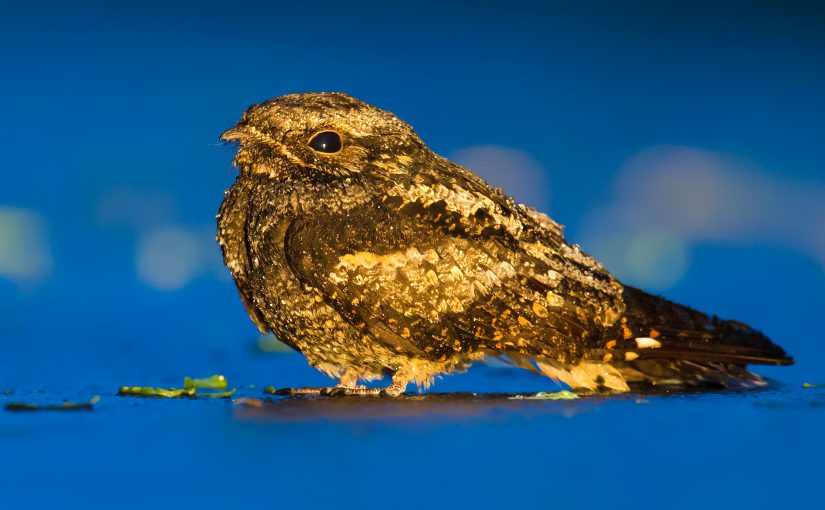Shanghai-area Springtime Birding, 2016
By Craig Brelsford and Elaine Du
for shanghaibirding.com
To return to the Reports page, please click here. For reports on birding destinations outside Shanghai, visit the Explorations page.
“Shanghai-area Springtime Birding, 2016” is part of a series on birding in the Shanghai region. Other reports in the series:
Shanghai-area Autumn & Winter Birding, 2015-16
Shanghai-area Springtime Birding, 2015
Shanghai-area Autumn & Winter Birding, 2014-15
Who Are We?
Craig Brelsford lived in Shanghai from 2007 to 2018. When he departed China in January 2018, Craig was the top-ranked eBirder in that country, having noted 932 species, as well as the top-ranked eBirder in Shanghai (323 species). A 1993 graduate of the University of Florida, Craig was an award-winning newspaper editor in the United States for 10 years. In 2002, he earned a master’s in business administration from the University of Liege in Belgium.
Elaine Du is from Boli, Heilongjiang and has a master’s degree in food science and engineering from the Harbin Institute of Technology. When she left China in February 2018, Elaine was the highest-ranked woman eBirder in China, with more than 730 species on her list, and was second only to Craig on the all-time eBird lists for Shanghai and Heilongjiang. Elaine’s Chinese name is Dù Lián Róng (杜连荣).
Craig and Elaine live in Debary, Florida with their son, Tiny.
Introduction
This report covers the period from 7 March 2016 to 24 May 2016. The husband-and-wife team of Craig Brelsford and Elaine Du birded 38 of those 79 days in the Shanghai region and noted 240 species. Birding on average three days a week, we met our goal of covering the spring migration season at the point on the Earth where the world’s greatest migratory flyway meets the world’s greatest city. We partnered with a growing network of friends, among them Shanghai-based British birder Michael Grunwell and Beijing-based Swedish birder Jan-Erik Nilsén.
Elaine and I compiled not just a sampling but something approaching an exhaustive list of the birds one can expect to experience in a single spring-migration season around Shanghai. We deepened our knowledge of the birds of the East Asian–Australasian Flyway and increased our understanding of the pressures these birds face in the Shanghai region. One of the most densely populated areas in the world and an economic dynamo, the Shanghai tri-province area encompasses Shanghai, Jiangsu, and Zhejiang, is the size of the U.S. state of Kansas, and has a population of 160 million—half that of the United States.
Highlights
• Showing the breadth of the avifauna on the eastern coast of Eurasia in spring, our list of 240 species draws from 53 families, with strong representation from Anatidae (15 species), Scolopacidae (30), Turdidae (11), Muscicapidae (19), and Emberizidae (12). (For the list of all 240 species noted, see our Simple List directly below this section.)
• We continued to monitor species under threat by the uncontrolled coastal development afflicting the region, among them the endangered Black-faced Spoonbill, Great Knot, and Yellow-breasted Bunting; near-threatened Eurasian Oystercatcher, Asian Dowitcher, Black-tailed Godwit, Bar-tailed Godwit, Eurasian Curlew, Grey-tailed Tattler, Red Knot, Curlew Sandpiper, Japanese Paradise Flycatcher, Marsh Grassbird, and Reed Parrotbill; and vulnerable Chinese Egret, Saunders’s Gull, and Yellow Bunting. We led a group one of whose members found the critically endangered Spoon-billed Sandpiper.
• We recorded the first Blue Whistling Thrush in Shanghai since 1987. Other interesting finds were Horned Grebe on Chongming, Oriental Plover on Hengsha Island, Ruddy Kingfisher at Yangkou, Red-throated Thrush at Century Park, singing Sakhalin Leaf Warbler at Zhongshan Park, Grey-crowned Warbler, Two-barred Warbler, Pechora Pipit, and Citrine Wagtail at Nanhui, White-shouldered Starling on Lesser Yangshan, Rufous-faced Warbler at Nanhui and on Lesser Yangshan, and Bluethroat at Nanhui and on Chongming. For more information on places visited, see “List of Place Names” at bottom of this report.
Simple List of Species of Bird Noted Around Shanghai, China, 7 March 2016 to 24 May 2016 (240 species)
Common Shelduck
Gadwall
Falcated Duck
Eurasian Wigeon
Mallard
Eastern Spot-billed Duck
Northern Shoveler
Northern Pintail
Garganey
Eurasian Teal
Common Pochard
Tufted Duck
Greater Scaup
Common Goldeneye
Common Merganser
Japanese Quail
Common Pheasant
Little Grebe
Great Crested Grebe
Horned Grebe
Black-necked Grebe
Eurasian Spoonbill
Black-faced Spoonbill
Eurasian Bittern
Yellow Bittern
Black-crowned Night Heron
Chinese Pond Heron
Eastern Cattle Egret
Grey Heron
Purple Heron
Great Egret
Intermediate Egret
Little Egret
Chinese Egret
Great Cormorant
Western Osprey
Black-winged Kite
Chinese Sparrowhawk
Hen Harrier
Pied Harrier
Eastern Buzzard
Brown-cheeked Rail/Water Rail
Brown Crake
White-breasted Waterhen
Common Moorhen
Eurasian Coot
Eurasian Oystercatcher
Black-winged Stilt
Pied Avocet
Grey-headed Lapwing
Pacific Golden Plover
Grey Plover
Little Ringed Plover
Kentish Plover
Lesser Sand Plover
Greater Sand Plover
Oriental Plover
Pheasant-tailed Jacana
Eurasian Woodcock
Pin-tailed/Swinhoe’s Snipe
Common Snipe
Asian Dowitcher
Black-tailed Godwit
Bar-tailed Godwit
Little Curlew
Whimbrel
Eurasian Curlew
Far Eastern Curlew
Spotted Redshank
Common Redshank
Marsh Sandpiper
Common Greenshank
Green Sandpiper
Wood Sandpiper
Grey-tailed Tattler
Terek Sandpiper
Common Sandpiper
Ruddy Turnstone
Great Knot
Red Knot
Sanderling
Red-necked Stint
Temminck’s Stint
Long-toed Stint
Sharp-tailed Sandpiper
Curlew Sandpiper
Dunlin
Broad-billed Sandpiper
Oriental Pratincole
Black-headed Gull
Saunders’s Gull
Black-tailed Gull
Vega Gull
Gull-billed Tern
Caspian Tern
Little Tern
Common Tern
Whiskered Tern
White-winged Tern
Feral Pigeon (Rock Dove)
Oriental Turtle Dove
Red Turtle Dove
Spotted Dove
Lesser Coucal
Asian Koel
Large Hawk-Cuckoo
Lesser Cuckoo
Indian Cuckoo
Common Cuckoo
Northern Boobook
Grey Nightjar
Pacific Swift
Ruddy Kingfisher
Black-capped Kingfisher
Common Kingfisher
Eurasian Hoopoe
Eurasian Wryneck
Great Spotted Woodpecker
Grey-headed Woodpecker
Common Kestrel
Merlin
Peregrine Falcon
Black-winged Cuckooshrike
Swinhoe’s Minivet
Ashy Minivet
Tiger Shrike
Bull-headed Shrike
Brown Shrike
Long-tailed Shrike
Chinese Grey Shrike
Black-naped Oriole
Black Drongo
Ashy Drongo
Hair-crested Drongo
Amur Paradise Flycatcher
Japanese Paradise Flycatcher
Azure-winged Magpie
Eurasian Magpie
Large-billed Crow
Yellow-bellied Tit
Japanese Tit
Chinese Penduline Tit
Oriental Skylark
Eurasian Skylark
Collared Finchbill
Light-vented Bulbul
Black Bulbul
Sand Martin
Barn Swallow
Asian House Martin
Red-rumped Swallow
Rufous-faced Warbler
Japanese/Manchurian Bush Warbler
Brown-flanked Bush Warbler
Asian Stubtail
Black-throated Bushtit
Dusky Warbler
Pallas’s Leaf Warbler
Yellow-browed Warbler
Arctic Warbler
Two-barred Warbler
Pale-legged Leaf Warbler
Sakhalin Leaf Warbler
Eastern Crowned Warbler
Grey-crowned Warbler
Oriental Reed Warbler
Black-browed Reed Warbler
Thick-billed Warbler
Marsh Grassbird
Zitting Cisticola
Plain Prinia
Chinese Hwamei
Red-billed Leiothrix
Vinous-throated Parrotbill
Reed Parrotbill
Chestnut-flanked White-eye
Japanese White-eye
Goldcrest
Crested Myna
Red-billed Starling
White-cheeked Starling
Black-collared Starling
White-shouldered Starling
Siberian Thrush
White’s Thrush
Grey-backed Thrush
Japanese Thrush
Chinese Blackbird
Eyebrowed Thrush
Pale Thrush
Brown-headed Thrush
Red-throated Thrush
Naumann’s Thrush
Dusky Thrush
Oriental Magpie-Robin
Grey-streaked Flycatcher
Dark-sided Flycatcher
Asian Brown Flycatcher
Blue-and-white Flycatcher
Siberian Blue Robin
Rufous-tailed Robin
Bluethroat
Siberian Rubythroat
Red-flanked Bluetail
Blue Whistling Thrush
Yellow-rumped Flycatcher
Narcissus Flycatcher
Mugimaki Flycatcher
Taiga Flycatcher
Daurian Redstart
Blue Rock Thrush
White-throated Rock Thrush
Stejneger’s Stonechat
Eurasian Tree Sparrow
Forest Wagtail
Eastern Yellow Wagtail
Citrine Wagtail
Grey Wagtail
White Wagtail
Richard’s Pipit
Olive-backed Pipit
Pechora Pipit
Red-throated Pipit
Buff-bellied Pipit
Brambling
Chinese Grosbeak
Grey-capped Greenfinch
Eurasian Siskin
Meadow Bunting
Tristram’s Bunting
Chestnut-eared Bunting
Little Bunting
Yellow-browed Bunting
Rustic Bunting
Yellow-throated Bunting
Yellow-breasted Bunting
Chestnut Bunting
Yellow Bunting
Black-faced Bunting
Pallas’s Reed Bunting
Itinerary (all dates 2016)
For more information on places visited, see “List of Place Names” at end of this report.
07 March Zhongshan Park
11 March Shanghai Botanical Garden
12 March Nanhui and Huangpu Park
15 March Century Park
18 March Chongming
19 March Dongtai
20 March Dongtai, Yangkou, & Chongming
03 April Chongming
04 April Nanhui
05 April Changfeng Park
07 April Century Park
09 April Hengsha
10 April Lesser Yangshan & Nanhui
14 April Century Park
17 April Lesser Yangshan & Nanhui
19 April Shanghai Botanical Garden
21 April Zhongshan Park
22 April Century Park
23 April Nanhui
24 April Nanhui
28 April Zhongshan Park
30 April Lesser Yangshan & Nanhui
01 May Nanhui
05 May Zhongshan Park
07 May Lesser Yangshan & Nanhui
08 May Nanhui
11 May Zhongshan Park
12 May Zhongshan Park
13 May Zhongshan Park
14 May Lesser Yangshan & Nanhui
15 May Nanhui
17 May Nanhui
21 May Dongtai & Yangkou
22 May Yangkou
23 May Yangkou & Nanhui
24 May Nanhui
The Trip
Mon. 7 March 2016 Zhongshan Park
Fri. 11 March 2016 Shanghai Botanical Garden
Sat. 12 March 2016 Nanhui & Huangpu Park
Tues. 15 March 2016 Century Park
It’s spring in Shanghai! The equinox hasn’t arrived yet, but Chinese New Year has passed, and in the parks the flowers are blooming. In recent days in Shanghai, Elaine and I have noted Black-necked Grebe in breeding plumage, seen Greater Scaup lingering at Dishui Lake, and found Red-throated Thrush amid lawn-loving Dusky Thrush at Century Park.
We reached all our destinations on foot or by subway, with two short taxi rides thrown in. Development continues in Shanghai, and it’s a double-edged sword; the ever-more efficient transportation system allows one to bird Nanhui cheaply, but development is also threatening Nanhui, as more and more reed beds fall to the bulldozer and backhoe.
On Mon. 7 March, fresh from our big trip to Dulong Gorge in Yunnan, Elaine and I did our first birding of the season at Zhongshan Park. We ran into Wāng Jìn Róng (汪进荣), a delightful local man who loves to photograph birds. He never tires of watching the Red-flanked Bluetail and Common Kingfisher that use the wooded area around the little central pond. When we heard the thin calls of Yellow-bellied Tit and discovered them on a bare branch across from where we were standing, Mr. Wang said we had brought him good luck. We heard Eurasian Siskin and Chinese Grosbeak in the trees above. Japanese Tit are singing, and Chinese Blackbird have begun to breed. Pale Thrush are a reminder of winter. Mr. Wang proudly showed us the Indochinese Yuhina he photographed recently at Yangpu Park, and he told us that he has seen Silver-throated Bushtit at Zhongshan.
On Fri. 11 March, Elaine and I made Elaine’s first visit ever and my first since Christmas Day 2011 to Shanghai Botanical Garden. We noted 23 species. 2 Collared Finchbill raised the old question of whether they are really wild, and 2 Yellow-browed Warbler may be a sign that the spring migration is beginning.
We searched in vain for White’s Thrush, and we found only 1 Grey-backed Thrush. Among our 9 Pale Thrush was one completely tamed by the photographers, whose latest innovation is to spear mealworms on a thin, stiff wire and induce the Daurian Redstart to hover to reach them. The redstart was uninjured by this tactic, which is an ethical step up from fastening mealworms with tiny, ingestible nails (as I have previously found Shanghai-area photographers doing). The photographers were chasing the Pale Thrush off, but so hooked was the thrush on the free protein that it refused to go away and made occasional dives at the baited wire. Elsewhere, we heard in this most urban of settings the same “tseep, tseep” contact call that Pale Thrush make in the much wilder country near Elaine’s hometown in Heilongjiang—Pale Thrush breeding ground.
A search for buntings in the nursery area turned up 4 Black-faced Bunting, and an old memory of finding small waders floating on garbage in the river was revived when we saw 5 Common Snipe on Zhāngjiātáng Hé (张家塘河). Just as four and a half years ago, these poor snipe were on mats formed by garbage that coalesces in the stagnant water. The snipe were only roosting there, of course, and presumably at dusk they jump onto the nearby muddy ground of the nursery to feed; in any case, the canal, completely walled in, offers zero mud on which to forage.

Shanghai Botanical Garden Gate 4 lies 700 m from Shilong Road Station, Metro Line 3. It is the first place I ever birded in China, two weeks after my arrival in Shanghai in October 2007. I relived with Elaine the thrilling moment when I beheld White’s Thrush for the first time; a moment that at that time and at my level of experience with Asian birds was just as breathtaking as finding Rufous-breasted Bush Robin last month in Dulong Gorge.
On Sat. 12 March, Elaine, Michael Grunwell, and I found 40 species at Nanhui and Huangpu Park on the Bund. We covered Nanhui and the Bund on foot and walked about 16 km. At Nanhui we met a worker in a digging machine carving ditches through which to drain large areas of reed bed, which he said when dry will be leveled and replanted with trees. The operation was well under way; water was running through the newly cut channels as fast as a mountain stream.
This distressing transformation is going to spell disaster for the Reed Parrotbill that are still fairly common at Nanhui. It will mean the end of habitat much relied on by Pallas’s Reed Bunting and Chinese Penduline Tit for winter habitat, it will take away breeding habitat for Oriental Reed Warbler, and it will add to the troubles faced by Oriental Stork and Black-faced Spoonbill, already under pressure at Nanhui.
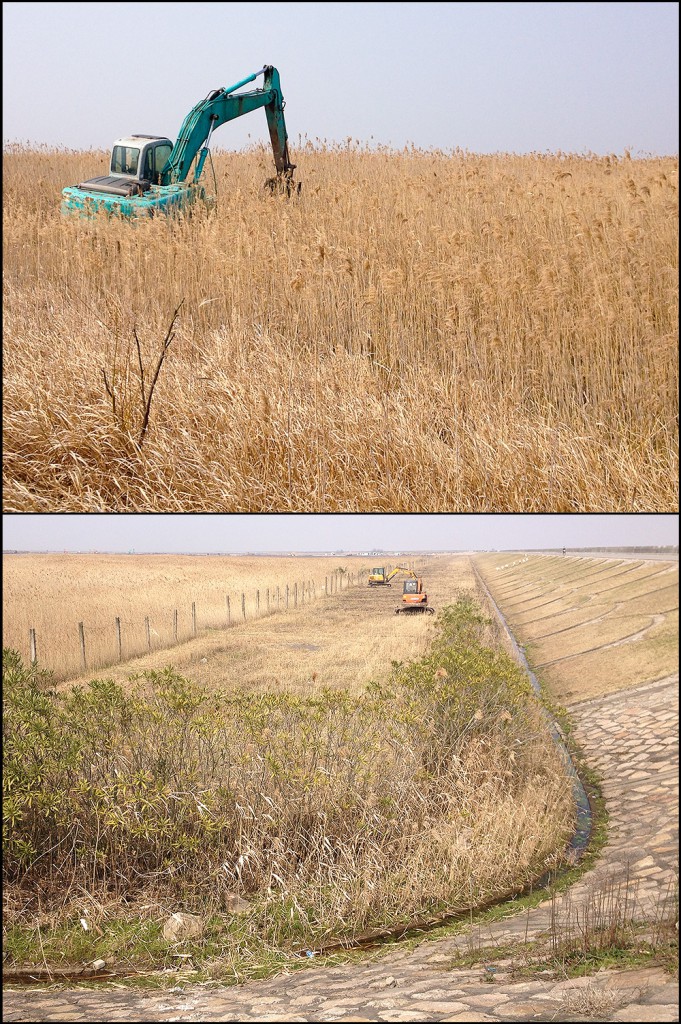
I have to wonder, when these huge transformative schemes are discussed in the corridors of power, are environmental experts even present? Have the planners even heard of Reed Parrotbill? Has anyone ever shown them a picture of Black-faced Spoonbill?
The only good news is that the artificial forests that will replace the historical reed-bed habitat will attract migrating passerines, which could use some help as they make their way up and down the Chinese coast. But that was cold comfort for us. “Pale Thrush will tseep where Reed Parrotbill used to chirr,” I sighed to my companions.
The bird scene at Nanhui was more wintry than spring-y, but we found tschutschensis Eastern Yellow Wagtail assuming breeding plumage and at Dishui Lake found Black-necked Grebe in breeding plumage. Dishui also yielded 7 Greater Scaup as well as Falcated Duck and Tufted Duck. Pied Avocet, Common Snipe, Dunlin, and Common Greenshank winter in the area; we saw no early evidence of spring migration among shorebirds.
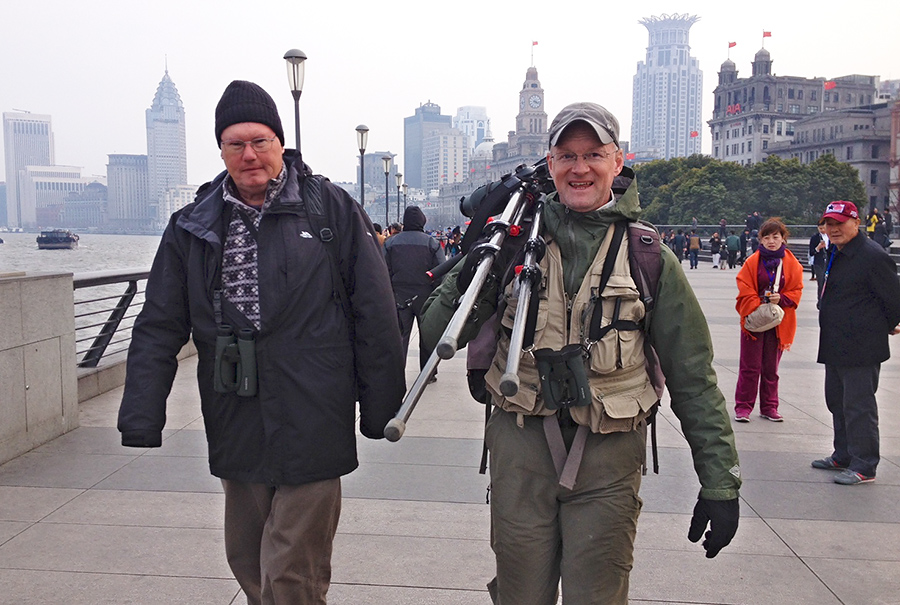
Continuing our theme of birding-by-subway, we moved our party via Metro Line 16 and Line 2 to the Bund. There, Michael carefully picked through the ca. 150 Vega Gull (Larus vegae vegae/mongolicus) in a fruitless search for a rarity such as Kamchatka Gull or even Heuglin’s. Black-headed Gull were there.
The problem with gulling at Shanghai’s most famous landmark is that one is simultaneously examining some of the trickiest birds known to birding and dealing with dozens of onlookers interested in the laowai with the big lens. However, this most international of meeting points also sends interesting people your way, birders such as Shelley Rutkin, who noticed our activities and introduced herself. It’s a grand place to make friends, there on the Bund with the Pudong skyline as your backdrop.
Shelley told us that a birder reported Slaty-backed Gull on the Huangpu River. This birder was near Shangri-La Hotel on the Pudong side. I have yet to bird Huangpu River from the Pudong side and will be interested to hear how others fare there. Shelley also sent us an interesting image of Red-flanked Bluetail attacking a centipede. Thanks, Shelley!
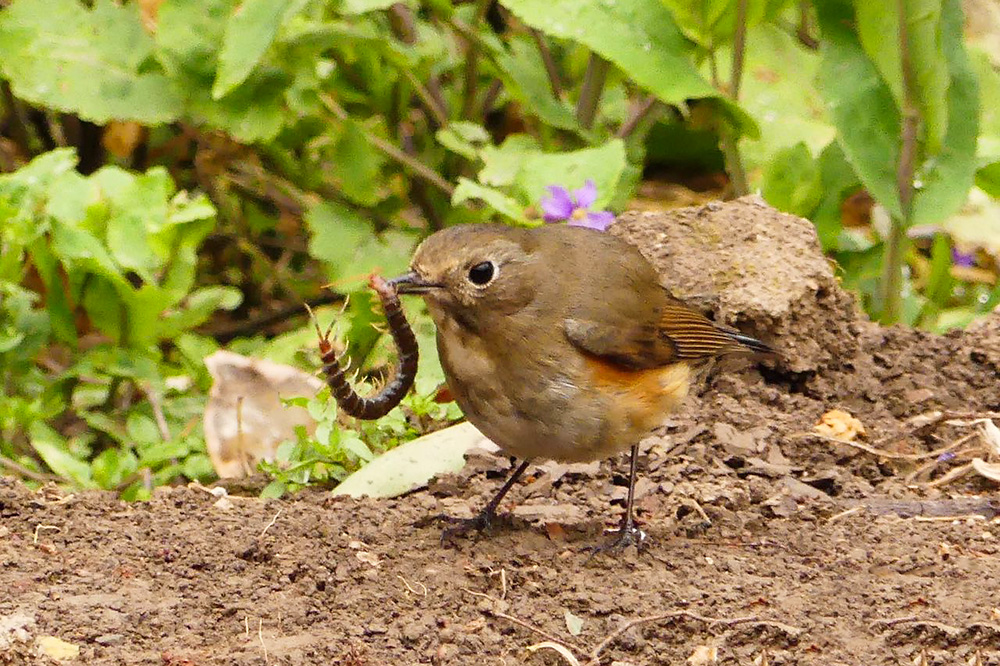
On Tues. 15 March Elaine and I noted the Red-throated Thrush at Century. Elaine spotted the thrush at sunset at the spacious lawn that on park maps is labeled “Amenity Grass” (疏林草坪区). The thrush was in the company of 60 Dusky Thrush and 1 Naumann’s Thrush that had descended onto the lawn to feed. Turdus ruficollis is scarce in Shanghai; Elaine and I note it two or three times each spring and autumn.
The thrushes were among 28 species we noted on our first trip to Century in 2016. Except for the Red-throated Thrush, the lineup was typical of the place and season. We noted a personal record high of 54 Pale Thrush, and large numbers of White-cheeked Starling and Red-billed Starling were assembling in trees around the very effective Bird Island in the middle of the park. Chinese Blackbird, Chinese Grosbeak, and Japanese Tit were singing.
When we arrived at 15:00, the park was crowded with photographers taking pictures of the cherry trees in bloom. Elaine and I know the park well and retreated to the quietest corners, where we found shy species such as Yellow-throated Bunting and Grey-backed Thrush. As the sun was setting, Elaine found White’s Thrush on the edge of the spacious lawn, which 90 minutes before had been full of people and which now, with all the visitors gone, was turning into a thrush feeding ground.
Fri. 18 March 2016 Chongming
Sat. 19 March 2016 Dongtai
Sun. 20 March 2016 Dongtai, Yangkou, Chongming
On 18-20 March 2016, Elaine Du, Kai Pflug, and I noted 89 species at Chongming, Dongtai, and Yangkou. We found a dowitcher at Dongtai, and at Chongming we had 90 cranes so far away and in such thick fog that we were unable to determine how many were the expected Hooded Crane. The canal at the base of the northeast Chongming sea wall gave us Common Goldeneye, Garganey, and Horned Grebe assuming breeding plumage and Black-necked Grebe in breeding plumage. In addition to the dowitcher, Dongtai produced Greater Scaup, Common Merganser, and endangered Far Eastern Curlew and near-threatened Eurasian Oystercatcher as well as early Bar-tailed Godwit, Barn Swallow, and Bull-headed Shrike and singing Chinese Grey Shrike. Yangkou gave us early Black Drongo.

On Fri. 18 March Elaine and I left our apartment near Zhongshan Park in a Skoda Scout rented from Avis. We picked up Kai at his home in Jiading, Shanghai and drove to the ferry terminal on Changxing Island in the Yangtze River. Our plan was to take the ferry to Hengsha Island. The ferry was fogged out until at least 07:25, at which time we gave up and drove to Chongming. We noted 49 species there, our chief stops being a place rich in Common Snipe near the base of the eastern sea wall and the aforementioned canal where we found the goldeneye and grebes.
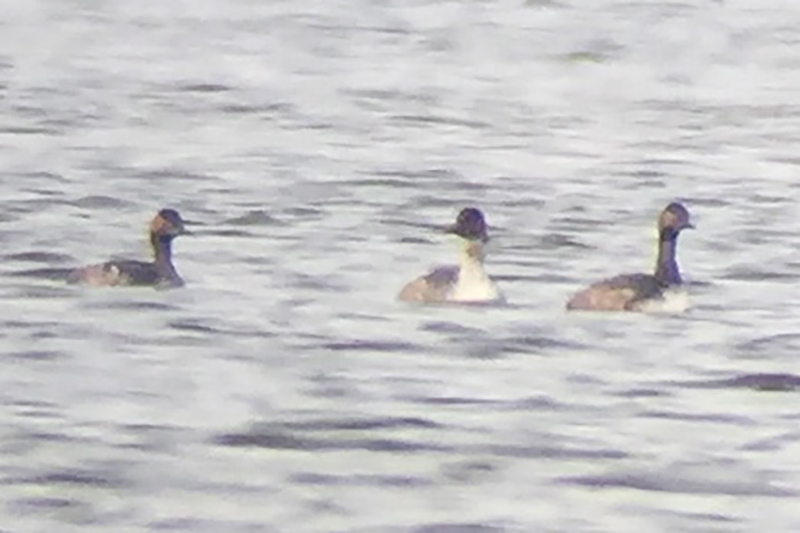
After dark we drove 236 km north on the G40 and G15 to Dongtai. There, we set up for two nights at Greentree Inn (Gélín Háotài Jiǔdiàn [格林豪泰酒店], 160 yuan/night for clean, modern room with fast Internet and breakfast, +86 (0) 515-85820999; 32.749262, 120.850125).
Sat. 19 March saw us note 60 species around what Elaine and I call the Great Dongtai Surf ’n’ Turf Birding Trail. We had a neap tide that crested around 10:00, leaving the shorebirds far out. The godwit showed the slightly upturned bill and was associating with Eurasian Curlew, as was our lone Far Eastern Curlew. The dowitcher was far inside the sea wall and visible only through the spotting scope. It was showing more brown than grey and no orange. It had a long, seemingly straight bill like a snipe but unlike a typical snipe was alone in an area far from cover. We observed a clear sewing-machine feeding motion.
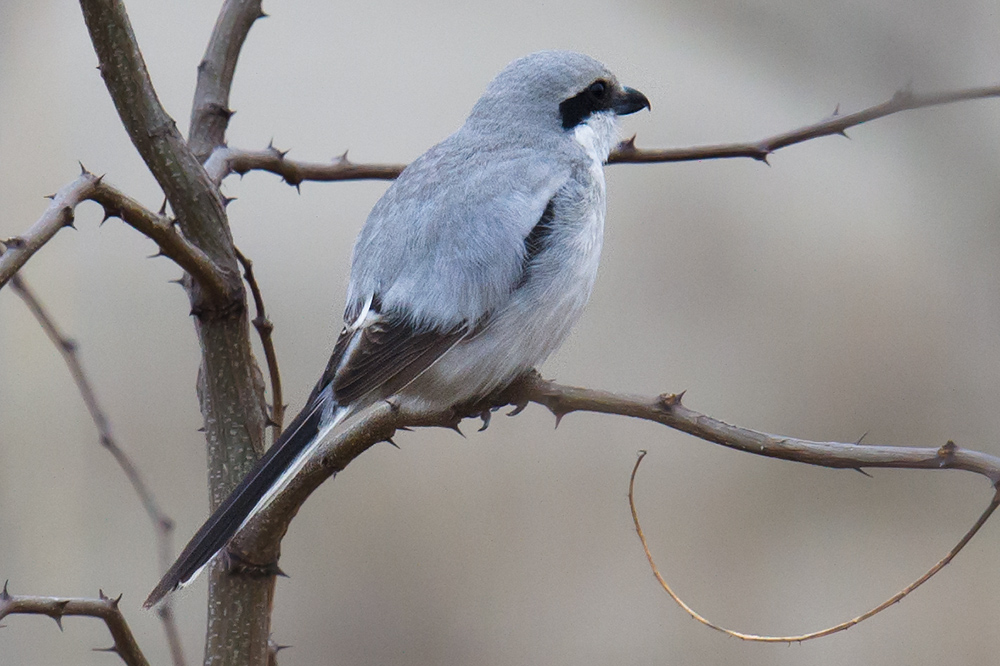
Intensive work is under way around the southeast corner of the reclaimed area. Digging machines were working throughout the weekend dredging up canals, changing forevermore areas where only last year Elaine and I found breeding Common Tern and territorial and possibly breeding Pied Avocet. The plan, clearly spelled out on the billboards near the tourist facilities, is to give nearly the entire reclaimed area over to aquaculture. The Great Dongtai Surf ’n’ Turf Birding Trail offers the best coastal birding within 500 km of Shanghai, it is a critical staging area for Nordmann’s Greenshank and Spoon-billed Sandpiper, it is relied upon by Black-faced Spoonbill, Great Knot, and Far Eastern Curlew—and it is being transformed, utterly. How interesting it is to be birding at this moment in history on the Chinese coast, scene of an ecological disaster like few ever seen before.
On Sunday morning 20 March we again covered the Surf ’n’ Turf Trail. We moved down to Yangkou in the afternoon, and we sneaked in an hour’s worth of birding at Chongming on the way back to the city. At Yangkou we failed to note Brown-cheeked Rail at the spot where I have seen the species three times before. We used playback off and on for about 45 minutes and got no response. Reed Parrotbill were in the area. At the snipe spot on Chongming, I photographed as many of the flushed snipe as possible, trying to find Jack, Pin-tailed, or Swinhoe’s. The photos I got show only Common Snipe.

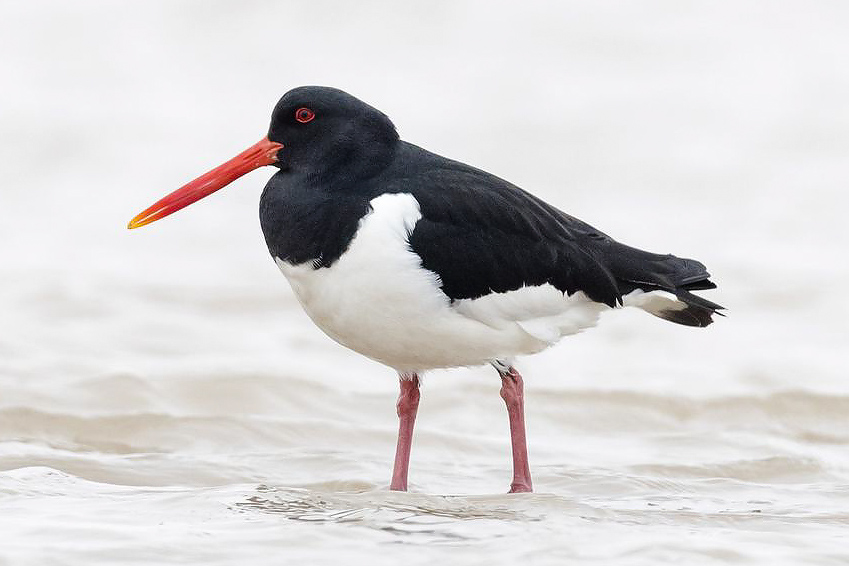


Fri. 25 March 2016 Binjiang Park (Huangpu River)
Sat. 26 March 2016 Nanhui
On Sat. 26 March, Elaine Du and I noted 53 species at Nanhui in southeast Shanghai. Despite air pollution that made my nose run, we enjoyed yet another day of Metro + walk-’n’-bird. We covered 15 km on foot, going camera-less and carrying our Swarovski scope. We took a taxi from the Dishui Lake Metro Line 16 station to Microforest 2 (30.926039, 121.970725). From there we walked back to the station, along the way exploring the reed beds, checking the shore, and scanning Dishui Lake.
Highlights: Falcated Duck 180, Garganey 8, Black-necked Grebe 4 (3 in nearly complete breeding plumage), Eurasian Spoonbill 8, Eurasian Bittern 1, Intermediate Egret 1, Kentish Plover 1, Barn Swallow 4, Reed Parrotbill 27, Naumann’s Thrush 1, Eastern Yellow Wagtail 5 tschutschensis, Richard’s Pipit 8, Buff-bellied Pipit 46, Chestnut-eared Bunting 5, Little Bunting 9 (1 singing), Pallas’s Reed Bunting 70.
In the reeds behind Microforest 2, amid the din of the digging machines that are destroying its home, a Reed Parrotbill was chirring loudly and making sounds reminiscent of babblers. I recorded four types of call:
chirring (00:03; 930 KB)
insistent (00:05; 1 MB)
plaintive (00:04; 958 KB)
joyful (00:20; 1.6 MB)
The transformation of the wetland continues apace. I took a photo showing a former marshy-reedy area, now drained, in which hundreds of a single species of coniferous tree are being planted. In this sector, sightings of Black-faced Spoonbill used to be regular. No more.
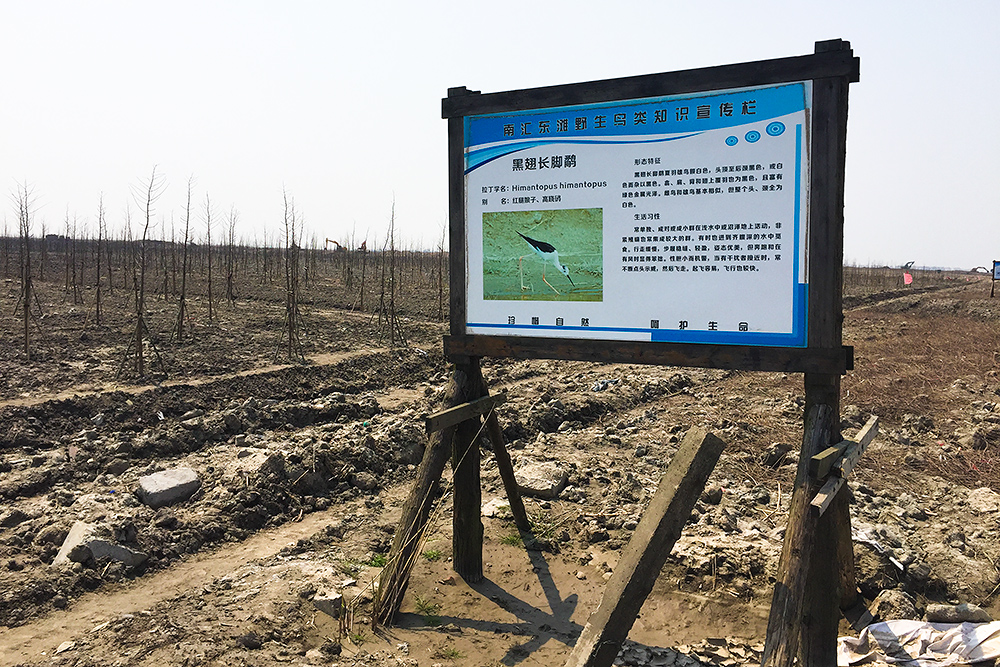
We skipped the Magic Parking Lot after a binocular check revealed about 100 cars parked around the lot. More and more locals are using our old birding area, especially on mild spring days such as Saturday.
On Fri. 25 March, Elaine and I viewed the Huangpu River from the Lujiazui side near Oriental Pearl Tower at a place called Binjiang Park (not to be confused with Binjiang Forest Park). Activity was little; we had just a handful of Vega Gull plus Black-crowned Night Heron, Little Egret, and a single Grey Heron as well as singing Chinese Blackbird, resident Light-vented Bulbul, and a leucopsis White Wagtail.
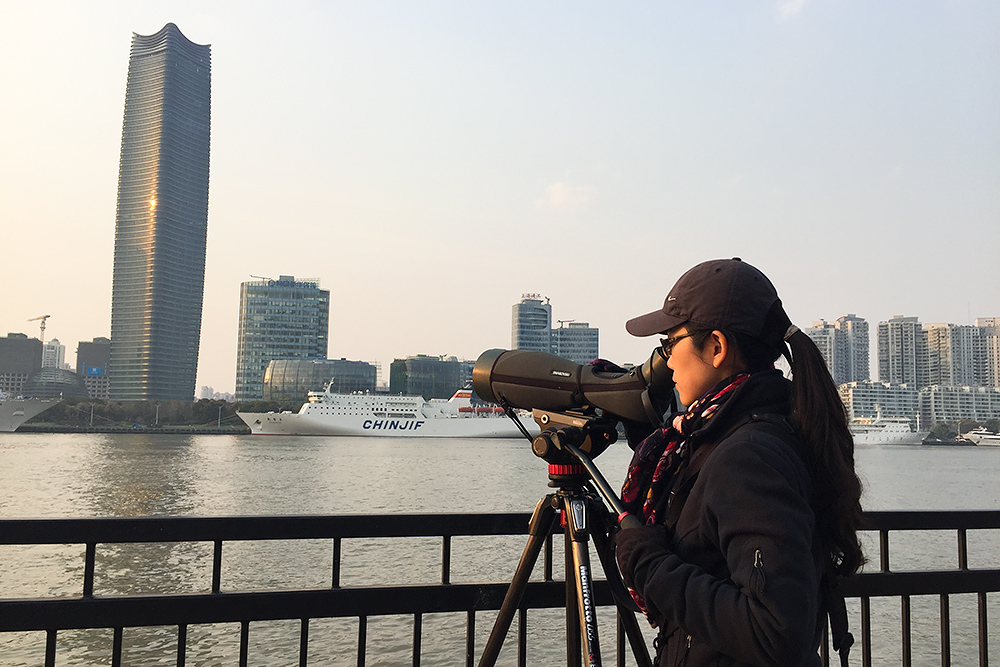
We met a local bird photographer who said he goes to Lujiazui often. At times, this photographer said, “thousands” of gulls can be seen on the river around Lujiazui-Bund. He said he’d had just such a banner day last week, and he was surprised at the lack of gulls on Friday. This gentleman had photos of Black-tailed Gull as well as many Larus vegae vegae/mongolicus.
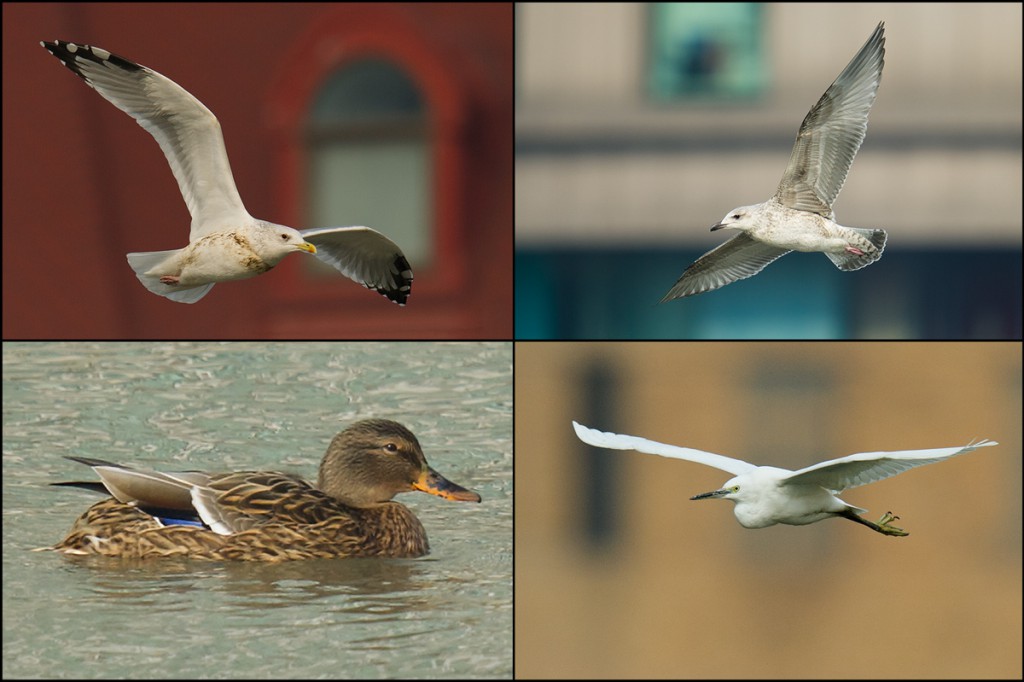
I get a romantic feeling birding the Bund and Lujiazui, one of the world’s best-known urban riverscapes. The romance is especially strong on a sunny day with the polluted air acting as a filter, reducing the sun’s rays to a soft, warm glow. Vega Gull appear; the Huangpu River is their stage, the famous skyscrapers their backdrop. The gulls will soon return to the wastes of Siberia, their northern home. Versatile creatures are they, specks of wild Asia in the heart of Shanghai.
List 1 of 1 for Fri. 25 March 2016 (7 species). Binjiang Park (Bīnjiāng Gōngyuán [滨江公园]; 31.235662, 121.497396), a small urban park on Huangpu River in Pudong New Area (Pǔdōng Xīn Qū [浦东新区]), Shanghai, China. Sunny; low 4° C, high 13° C. Visibility 10 km. Wind NNW 15 km/h. PM2.5 AQI: 109 (unhealthful). Sunrise 05:50, sunset 18:10. FRI 25 MAR 2016 16:10-17:10. Craig Brelsford & Elaine Du.
Black-crowned Night Heron Nycticorax nycticorax 8
Grey Heron Ardea cinerea 1
Little Egret Egretta garzetta 6
Vega Gull Larus vegae vegae/mongolicus 13
Light-vented Bulbul Pycnonotus sinensis 18
Chinese Blackbird Turdus mandarinus 4
White Wagtail Motacilla alba 1 leucopsis
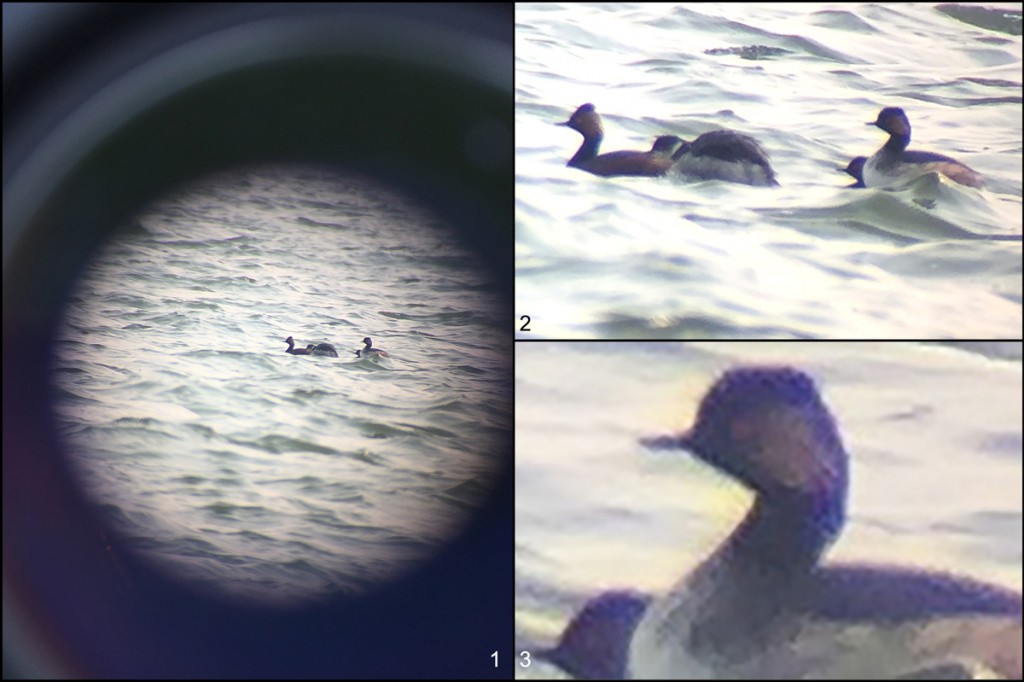
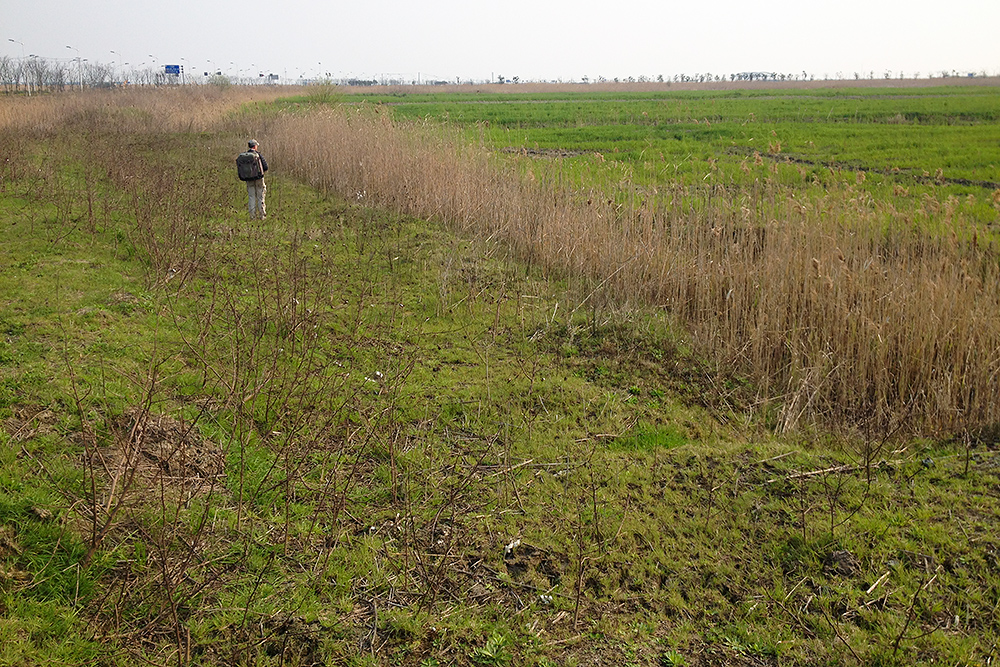
Sun. 3 April 2016 Chongming
Mon. 4 April 2016 Nanhui
Spring has surged into Shanghai! Elaine Du and I noted 92 species on the Qingming weekend. We found 212 endangered Great Knot at Nanhui and Bluethroat and Brown-headed Thrush on Chongming. Other highlights were 2 Greater Scaup and Black-necked Grebe on Chongming and at Nanhui 2 endangered Yellow-breasted Bunting, “Swintail” Snipe, 10 Saunders’s Gull (rare in Shanghai), 3 endangered Far Eastern Curlew, 2 Eurasian Bittern booming amid the sound of traffic, and 10 Pacific Swift.
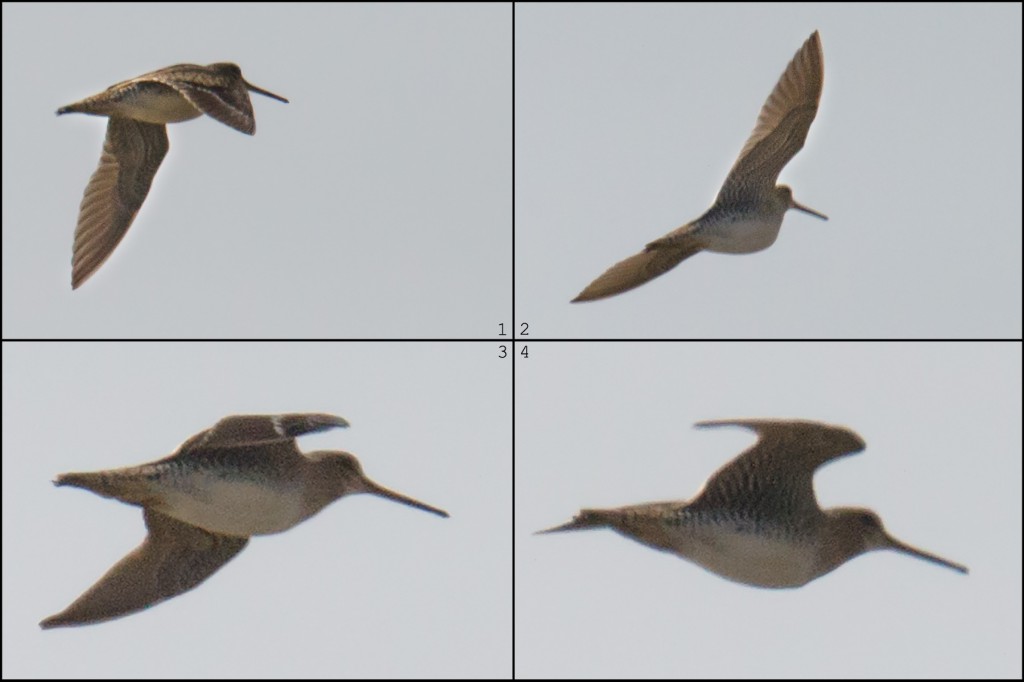
On Sun. 3 April 2016, fog once again kept Elaine and me off Hengsha Island, our original destination. Driving our rented Skoda Scout, we left the Hengsha ferry terminal on Changxing Island and took the Shanghai Changjiang Bridge across the Yangtze to Chongming Island. Visibility was less than 100 meters when we finally arrived at Chongming Dongtan National Bird Sanctuary and Nature Reserve. Rain, usually a drizzle, sometimes a shower, let up only briefly, around noon.
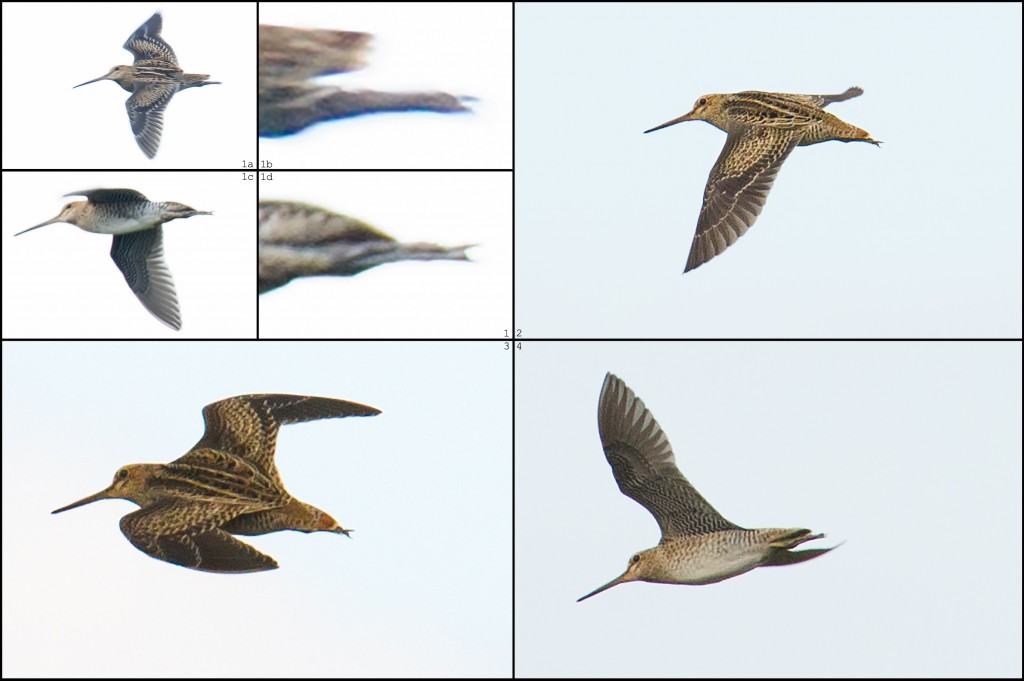
We stayed away from fee and permit areas. The northeast sea wall, with its well-protected mudflats beyond, is blocked off by guards wearing camouflage uniforms. A road running inside and parallel to the sea wall is not in a permit area and affords views of the canal-pond at the base of the wall. Reeds running along this inner road are the first tall, thick vegetation a bird flying along the coastline is likely to see and contained several migrants, among them the Brown-headed Thrush and a leaf warbler that may have been Chinese Leaf Warbler. The Phyllosc was soaking wet, and the characteristics I was noting, such as its seeming lack of a strong coronal stripe like Pallas’s Leaf Warbler, may have merely been the effect of the water. We noted the bright yellow rump, were starting to get hopeful—and then the bird disappeared.
On the eastern end of Chongming, we covered the farmland inside the sea wall and did not drive in the permit area atop the wall. We found the Bluethroat at the very good “snipe corner” (31.479537, 121.937001) south of Changjiang Lu. True to form, the skulker quickly hid away, refusing to flush or show. Still, the fleeting glimpse we got was Elaine’s best view ever of Bluethroat.
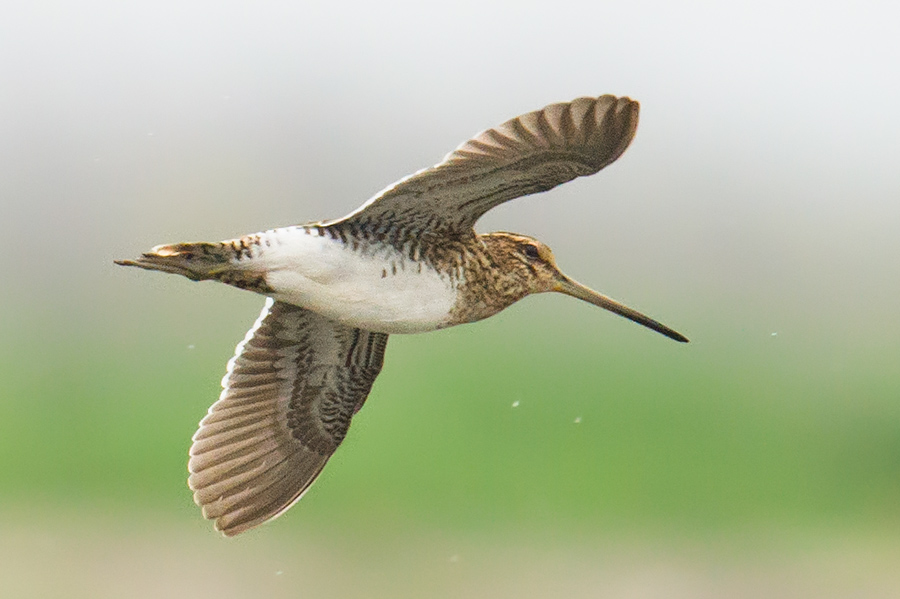
My walk through the reeds in pursuit of the Bluethroat scared up 2 Japanese Quail. Common Snipe were numerous, a pair of Oriental Skylark were hollowing out a tiny cup in the grass, and Water/Brown-cheeked Rail squealed once and fell silent. I recorded a fifth distinctive vocalization of Reed Parrotbill; I call this one the “siren.”
Reed Parrotbill, siren call (00:04; 954 KB)
On Mon. 4 April, Shanghai-based British birder Michael Grunwell once again joined Elaine and me at Nanhui. We noted 73 species. Whereas outings in March gave us a “spring emerging from winter” impression, on Monday the transition to springtime felt complete. All that was missing were the flycatchers and the leaves on the trees in the microforests, those migrant traps dotting the sea wall.
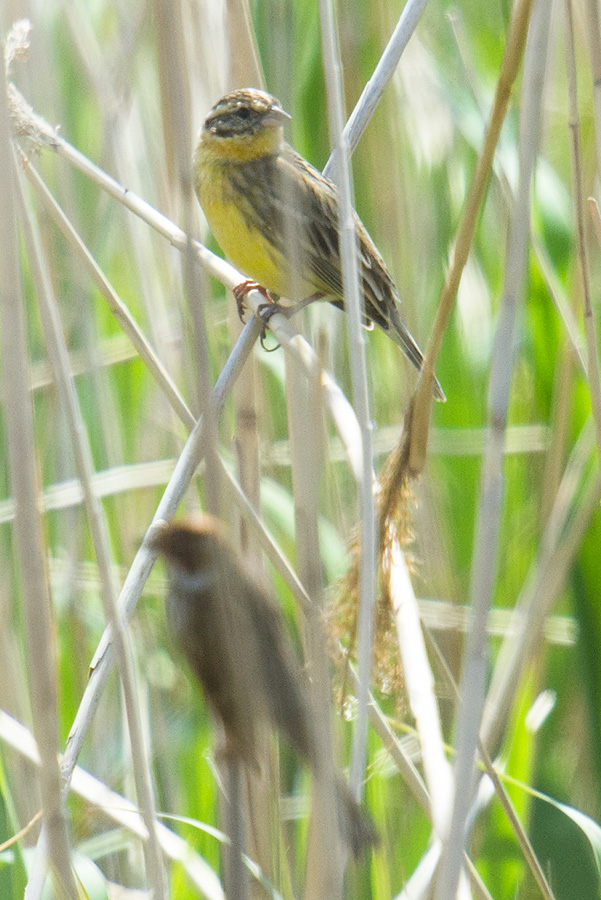
We rented no car, instead relying on the Shanghai Metro, taxis, a ride from a pair of friendly tourists, and our legs. With sunny skies and temperatures reaching 18 degrees, the weather was nearly perfect, and the exercise put us in a good mood.
The birding area at Nanhui is steadily going from “half-forgotten, mostly empty, natural” to “popular, busy, recreational.” Cars were packed around Nanhuizui Park and the Holiday Inn, and Qingming tourists were streaming out of the buses. Amid the commotion we found our first-of-season singing Manchurian/Japanese Bush Warbler as well as a single Asian House Martin flying among the swifts, the suddenly numerous Barn Swallow, and a single Red-rumped Swallow. At the Magic GPS Point (30.880540, 121.964572), we climbed to the deck of the derelict building next to the Holiday Inn. There, we enjoyed the expansive views, noted more Pacific Swift, and wondered how on earth a building as huge as this could be built and then immediately abandoned.
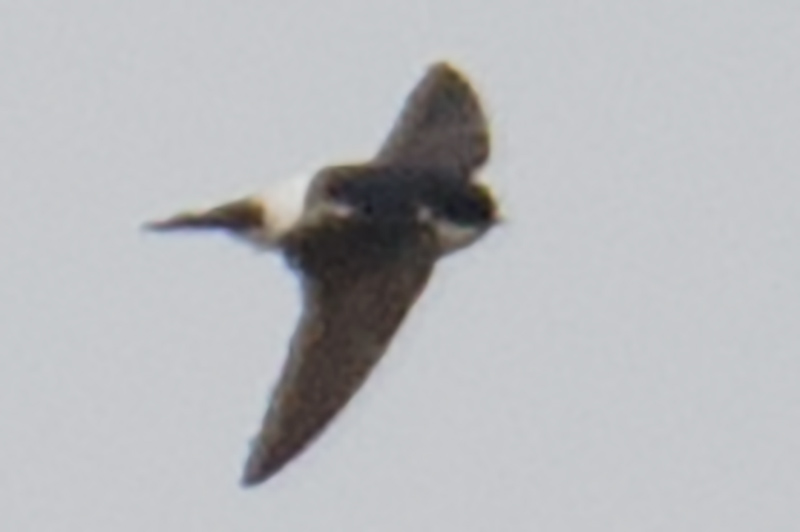
North of the Nanhuizui area, photographers were working on 12 Black-winged Stilt that were using a pond close to Microforest 2 (30.926039, 121.970725). Around that pond we found Marsh Sandpiper, Temminck’s Stint, and Sharp-tailed Sandpiper. The quiet, half-fallow fields behind the pond evoked memories of old Nanhui. We found our Yellow-breasted Bunting here as well as Chestnut-eared Bunting and about 60 of our 90 Pallas’s Reed Bunting. We were looking for but failed to find Japanese Reed Bunting. We noted the absence of harriers, which normally would be hovering over the fields and reed beds.
Great Knot were seen in flight and on the mudflats as the tide receded.
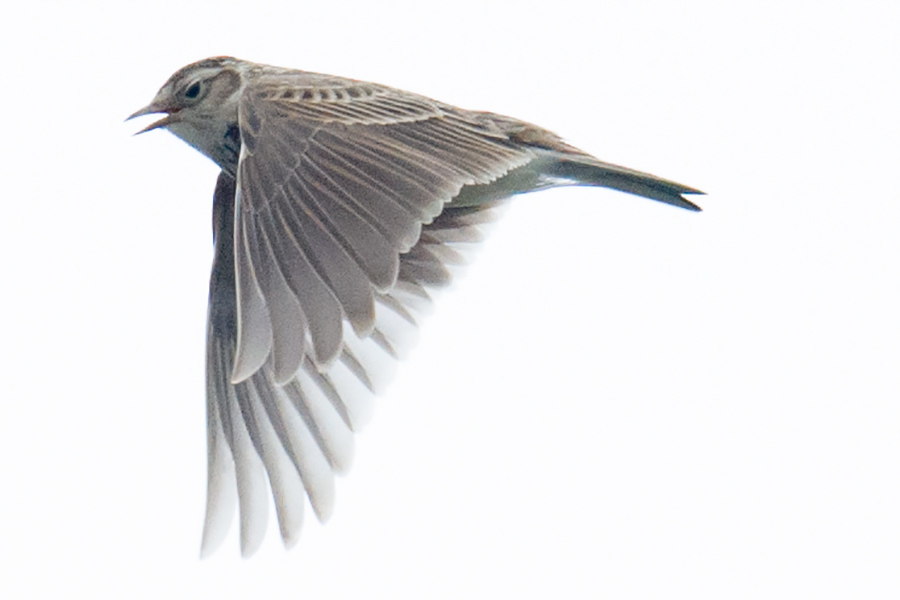
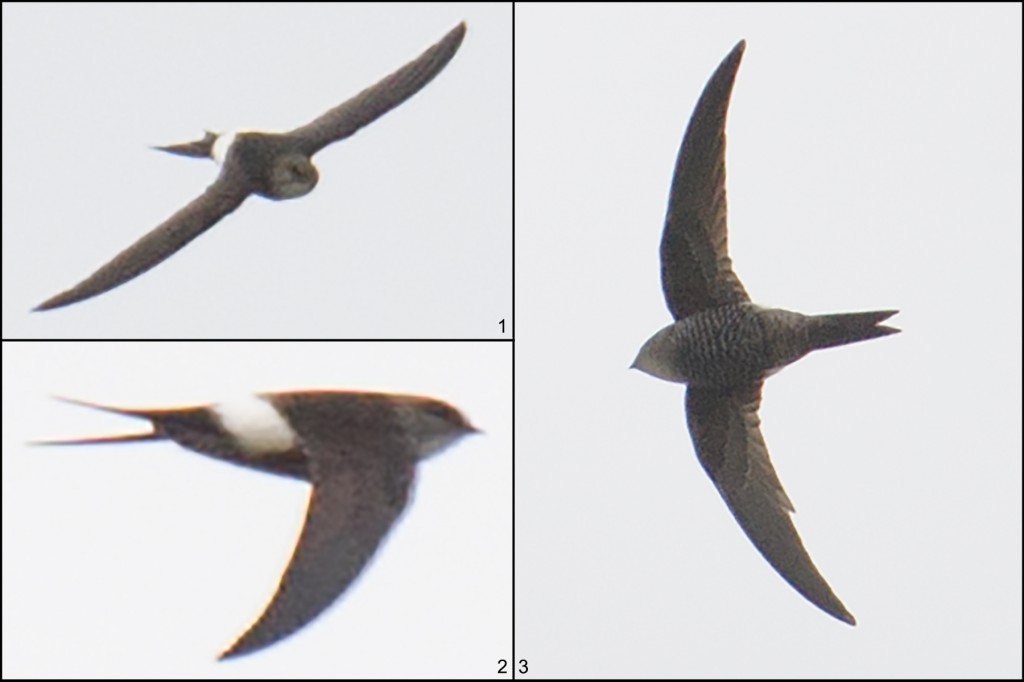
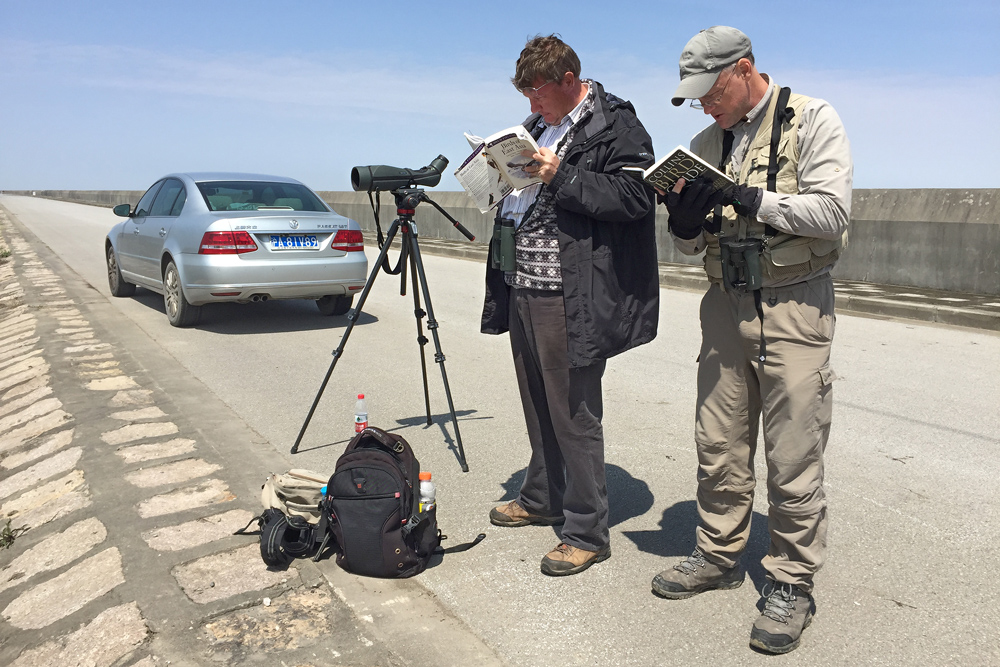
Tues. 5 April 2016
Changfeng Park
Elaine and I took an afternoon constitutional at Changfeng Park and noted 16 species. We took a taxi from our apartment near Zhongshan Park to Changfeng, covered the park on foot, and walked 3.5 km home, staying as close as possible to Suzhou Creek. I first visited Changfeng in 2007 and had not been there since December 2014. The park, like all Shanghai parks, gets busier by the year. Even on a Tuesday afternoon the 36-hectare park was noisy and bustling with people, many of them retired folks. We noted season’s first Black-throated Bushtit in the far northwest corner of the park. The bushtits were sharing one of the many tall trees with Yellow-browed Warbler. Pale Thrush was nearby. Chinese Grosbeak were audible over the din. Red-flanked Bluetail was in the nursery.
List 1 of 1 for Tues. 5 April 2016 (16 species) Changfeng Park (Chángfēng Gōngyuán [长风公园]; 31.224860, 121.399155), urban green space in Putuo District (Pǔtuó Qū [普陀区]), Shanghai, China. Includes observations of birds around Suzhou Creek from Hongqiao Riverside Park (Hóngqiáo Hébīn Gōngyuán [虹桥河滨公园]; 31.219311, 121.400898). Sunny; low 9° C, high 16° C. Visibility 9 km. Wind E 17 km/h. PM2.5 AQI: 89 (moderate). Sunrise 05:36, sunset 18:17. TUE 05 APR 2016 15:30-17:30. Craig Brelsford & Elaine Du.
Black-crowned Night Heron Nycticorax nycticorax 12 along Suzhou Creek
Little Egret Egretta garzetta 1 along Suzhou Creek
Spotted Dove Spilopelia chinensis 15
Long-tailed Shrike Lanius schach 1
Azure-winged Magpie Cyanopica cyanus 14
Japanese Tit Parus minor 2
Light-vented Bulbul Pycnonotus sinensis 28
Black-throated Bushtit Aegithalos concinnus 3
Yellow-browed Warbler Phylloscopus inornatus 1
Vinous-throated Parrotbill Sinosuthora webbiana 8
Chinese Blackbird Turdus mandarinus 24
Pale Thrush T. pallidus 2
Red-flanked Bluetail Tarsiger cyanurus 1
Eurasian Tree Sparrow Passer montanus 10
White Wagtail Motacilla leucopsis 1 leucopsis along Suzhou Creek
Chinese Grosbeak Eophona migratoria 13
Thurs. 7 April 2016
Century Park
On Thurs. 7 April, my wife Elaine Du and I noted 30 species at Century Park. For the first time I heard White’s Thrush sing. Many of the wintering birds were still very much present, among them 40 Pale Thrush. Bird Island, the sanctuary within a sanctuary in the middle of the park, once again proved its worth, yielding 1 of our 2 Great Spotted Woodpecker as well as all our 18 Oriental Turtle Dove plus Chinese Pond Heron and Grey Heron. One of our Red-flanked Bluetail was a beautiful blue adult male, and we found migrating Stejneger’s Stonechat. Dusky Thrush, 63 of which we found on our last visit on 15 March, have left the park, and we found no Grey-backed Thrush.
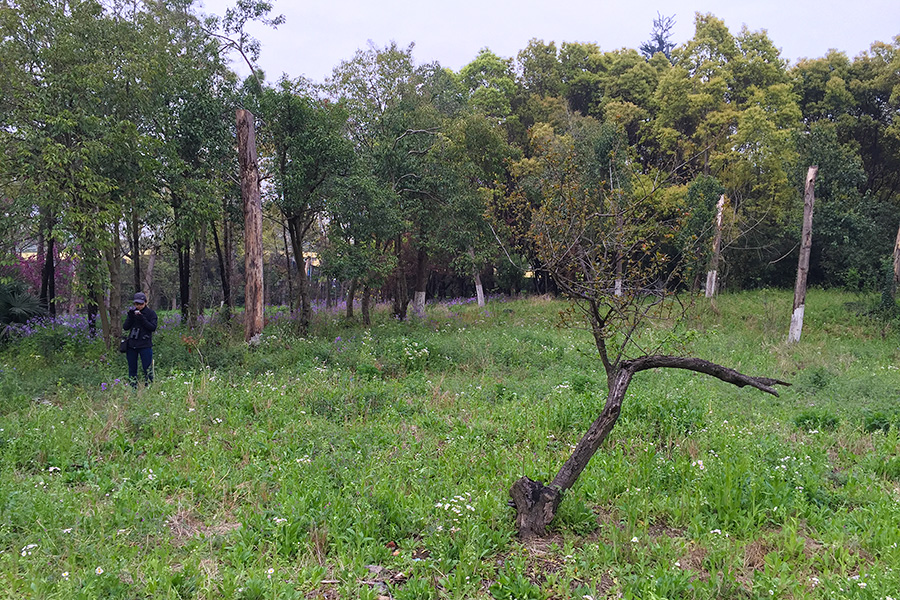
On an overcast, quiet weekday that according to the guards at Gate 7 saw the 140-hectare park attract only 2500 visitors, Elaine and I soaked in the peaceful atmosphere. The recent rains brought forth an earthy odor from the forest floor, some of the wildflowers were fragrant, and in one of the scrubby areas the herbs we trod on gave off spicy scents.
So quiet was the park that we actually were able to listen to birdsong for sustained amounts of time. Chinese Blackbird, Light-vented Bulbul, and Azure-winged Magpie, the Big 3 residents of Century, created a river of sound, supplemented by some Chinese Grosbeak. Amid that flow, and with the low rumble being made by the traffic on Huamu Road, I picked out a sound that was definitely being made by a bird but was unlike any I had heard before. It was a one-note, drawn-out, plaintive whistle, haunting and beautiful, with pauses of several seconds in between. Mesmerized, I walked toward the sound, which was coming from the canopy. The song suddenly stopped, and out flew a White’s Thrush. The whole episode was over in a minute or two, and I had not made a recording. But while the memory of the song was still fresh, I played back recordings of the song of White’s that I have on my iPhone. There was no doubt. The song Elaine and I heard and the song on my phone were the same.
We met a man who recently retired from China Customs and is familiar with Western culture; he picked me out as American without having to ask. This smart fellow says he exercises at Century every day and that so-called Bird Island (31.217405, 121.554936) is devoid of special birds. “鸟岛无鸟,” he said. I knew he was wrong, but I let it go, because appreciating Bird Island requires more knowledge of birds than this gentleman was likely interested in acquiring. He could not see that while Spotted Dove, a “city” bird, are numerous throughout the park as well as in the deepest parts of the inner-city jungle, Oriental Turtle Dove, a more “country” bird, rely greatly on Bird Island. In winter, hundreds of White-cheeked Starling and Red-billed Starling roost on trees on and around the island, and I have seen Mandarin Duck on its shores. Great Spotted Woodpecker, rare in Shanghai, are found there regularly. I have not set foot on Bird Island since 2009, but that’s fine with me because it is possible with binoculars to peer into its forest, and in any case I agree with the principle of Bird Island, which is to confine human beings and cats to the mainland side of its protective moat.
The ticket-takers at Gate 7 told us some interesting facts. Last Monday was Qingming, an important national holiday, and with the fine weather that day, Century received 50,000 visitors. On a typical Saturday or Sunday, they told us, 30,000 to 40,000 visitors pack the Pudong park.
Related Link: Have you viewed our recently created page, Birds Recorded at Century Park? There you can view all 129 species of bird recorded at urban Shanghai’s most birdable park.
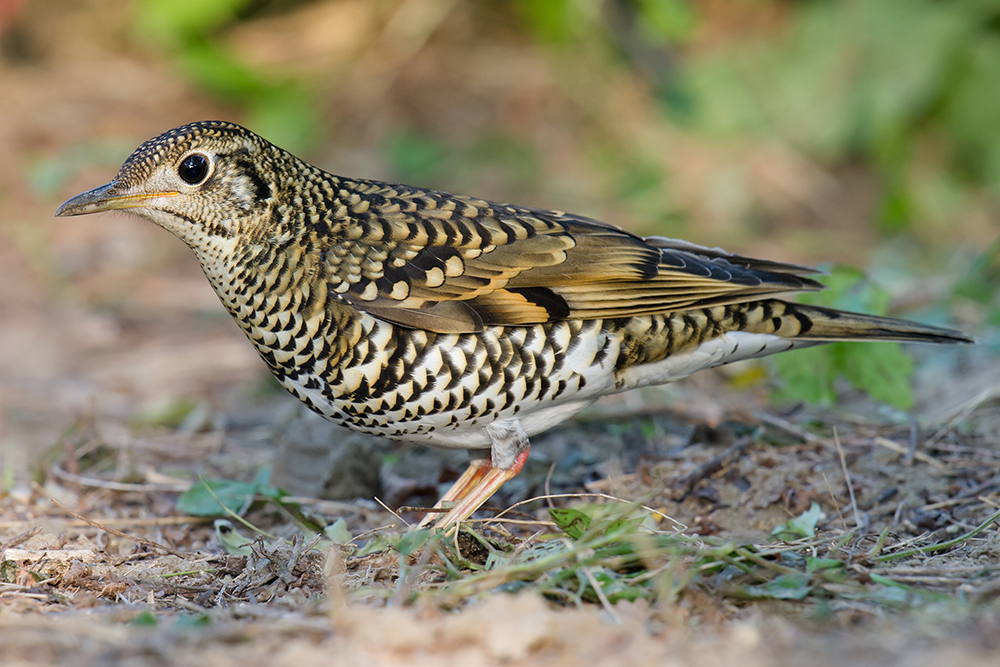
Sat. 9 April 2016 Hengsha Island
Sun. 10 April 2016 Lesser Yangshan and Nanhui
On Sat. 9 April and Sun. 10 April 2016, Elaine Du and I noted 103 species at three Shanghai-area birding hot spots. We had Oriental Plover and Black-faced Spoonbill on Hengsha, the latter present also at Nanhui, where we found in addition Brown Crake, Greater Sand Plover, Black-tailed Godwit, Marsh Grassbird, Bluethroat, and Citrine Wagtail. Lesser Yangshan yielded out-of-range Rufous-faced Warbler and our season’s first flycatcher, Asian Brown Flycatcher. Other season’s firsts were Eurasian Wryneck and Oriental Reed Warbler on Hengsha, Oriental Pratincole, Japanese Thrush, Tristram’s Bunting, and Meadow Bunting on Lesser Yangshan, and Broad-billed Sandpiper at Nanhui. Garganey and singing Brown-flanked Bush Warbler were on Hengsha and Temminck’s Stint and Grey-backed Thrush were noted at Nanhui. Red-throated Pipit were on Hengsha and Nanhui, as were Intermediate Egret, “Swintail” Snipe, Reed Parrotbill, and Chestnut-eared Bunting.
On Sat. 9 April Elaine and I birded Hengsha, the alluvial island at the mouth of the Yangtze. Our target was Oriental Plover Charadrius veredus, which we found after a short search. Oriental Plover breeds in deserts and steppes mainly in Mongolia, and in China in Hulunbeier, Inner Mongolia. For Elaine, Ori Pluv was a virtual lifer, as her only previous experience with the species was our quick, long-distance look at an individual near Hulun Lake last July.
On Sun. 10 April Elaine and I were joined by Shanghai-based British birder Michael Grunwell. We noted 90 species on Lesser Yangshan Island and at Nanhui.
The three of us found 30 singing Marsh Grassbird in the large reed bed at 30.866006, 121.939614, a point 2.8 km south of the lock at Nanhui and 4.1 km south of the Magic Parking Lot/Holiday Inn (30.882784, 121.972782). An unpaved road leads into the marsh. The grassbirds were noted only in that reed bed and not in other seemingly suitable reed beds elsewhere at Nanhui. The grassbirds were using only those parts of the reed bed far from the road. They were making their curving display flight.
Marsh Grassbird is also known as Japanese Swamp Warbler and Japanese Marsh Warbler. It is listed as Near Threatened by the IUCN. The IUCN notes that Marsh Grassbird is “very sensitive to habitat structure and does not tolerate vegetation that is too short or too tall.” It is threatened mainly by the conversion of its wetland habitat to other uses.
Speaking of conversions, new construction is changing all three of the birding spots we visited last weekend. Lesser Yangshan Island is being converted from an island to an even bigger megaport, and Garbage Dump Coastal Plain (30.638860, 122.060089) is steadily growing unbirdable. A bright spot on Lesser Yangshan is the new wetland (30.611902, 122.114873) on reclaimed land between Lesser Yangshan and Dazhitou Island.
In the reclaimed area on Hengsha, a 100-hectare area at 31.299495, 121.893845 is being converted from savanna to forest. That is an area about two-thirds the size of Century Park in Pudong. This may be good news, as the tree plantation may attract forest species such as flycatchers and leaf warblers, families that on the formerly treeless reclaimed area at Hengsha have always been scarce.
The springtime birding season in Shanghai is really picking up steam. On the Web site of the Shanghai Wild Bird Society, shwbs.org, birders have recently reported Long-billed Dowitcher, Asian Dowitcher, and Ruff on Chongming and Spoon-billed Sandpiper and Black Redstart on Hengsha.
Photos
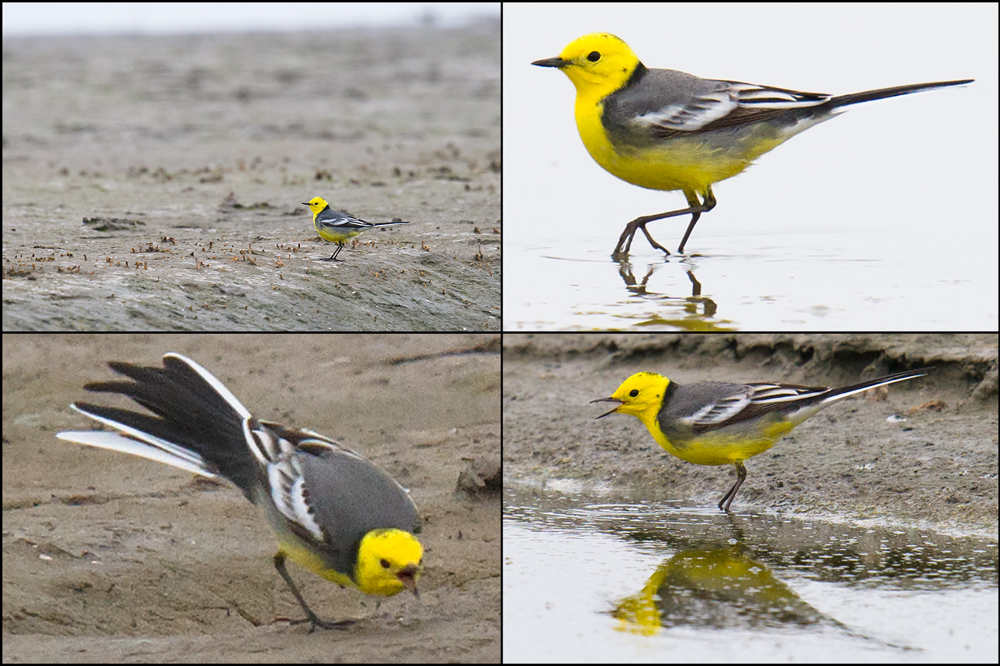
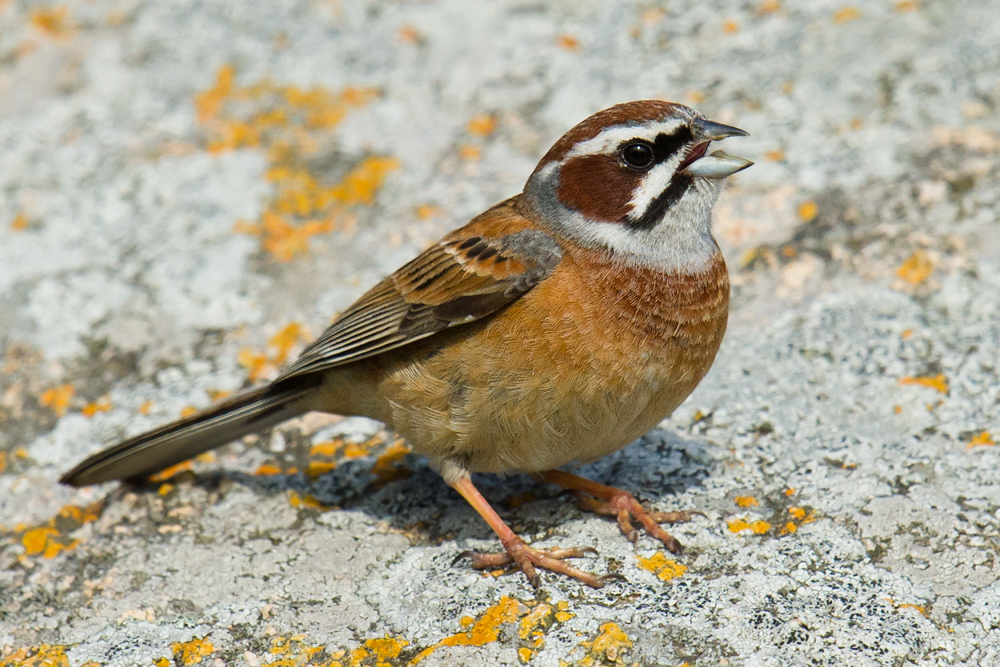
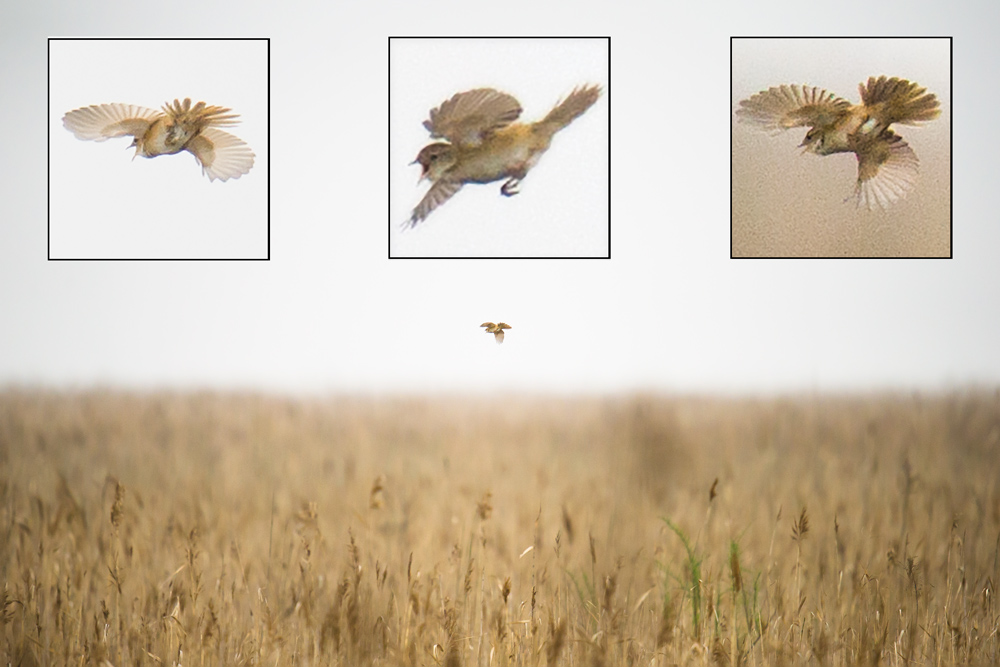
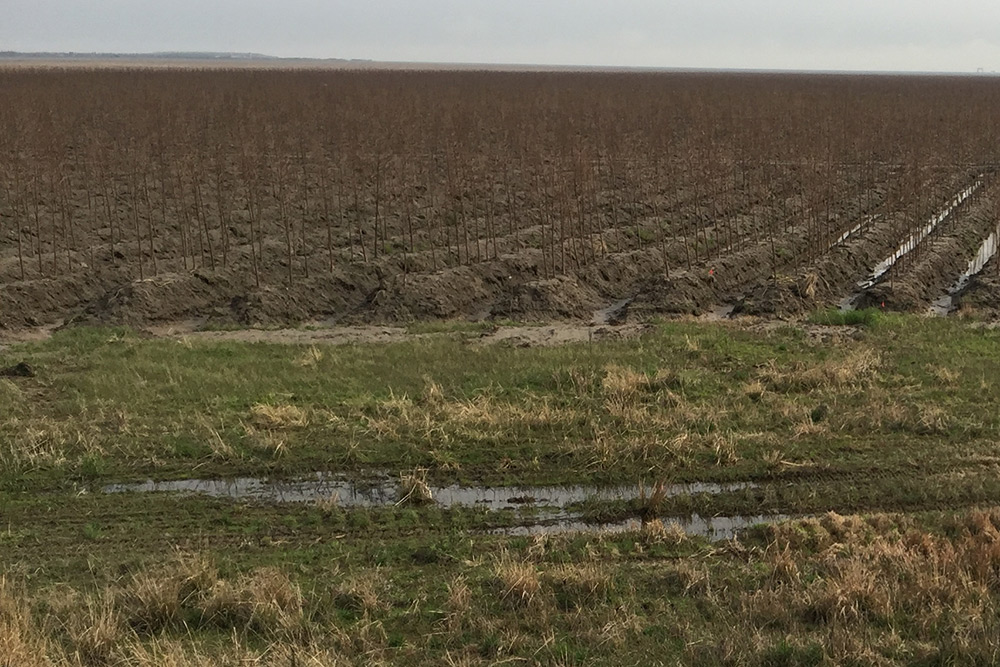
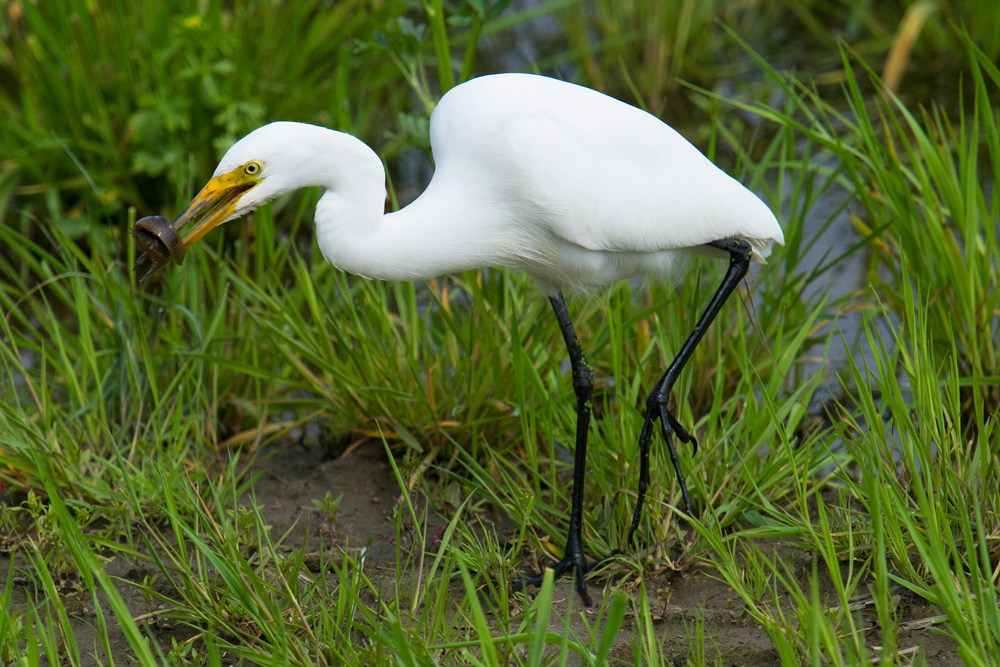
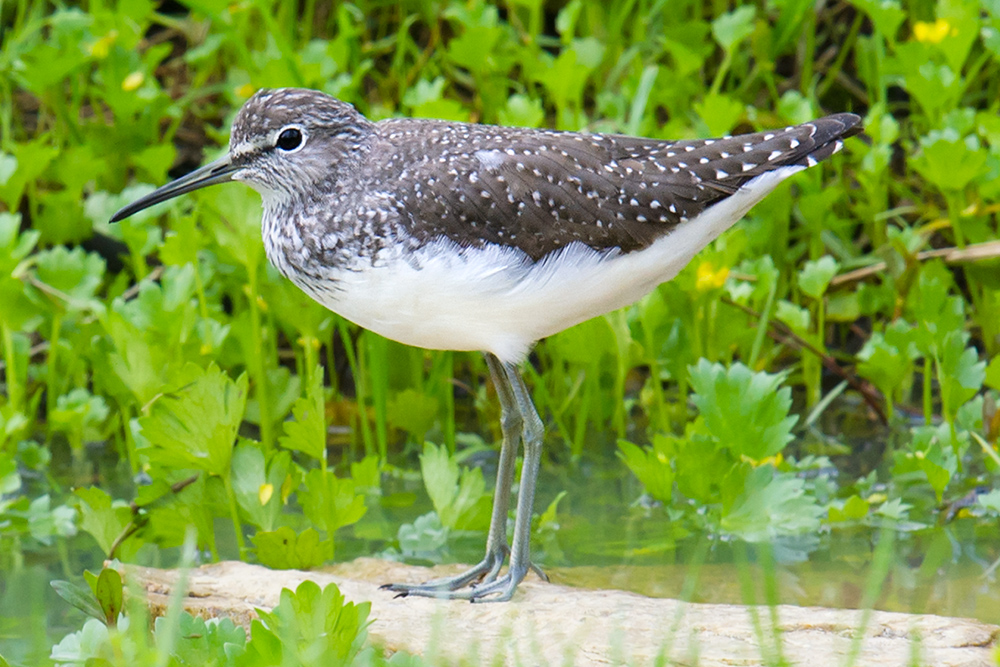
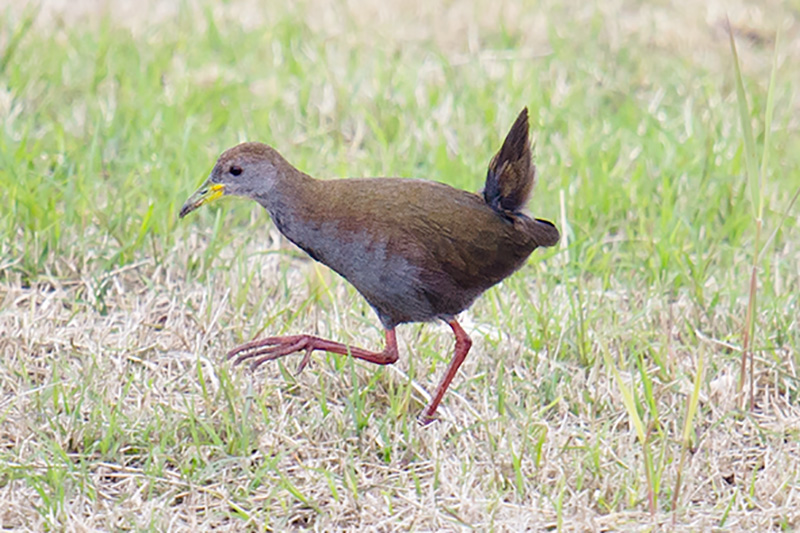
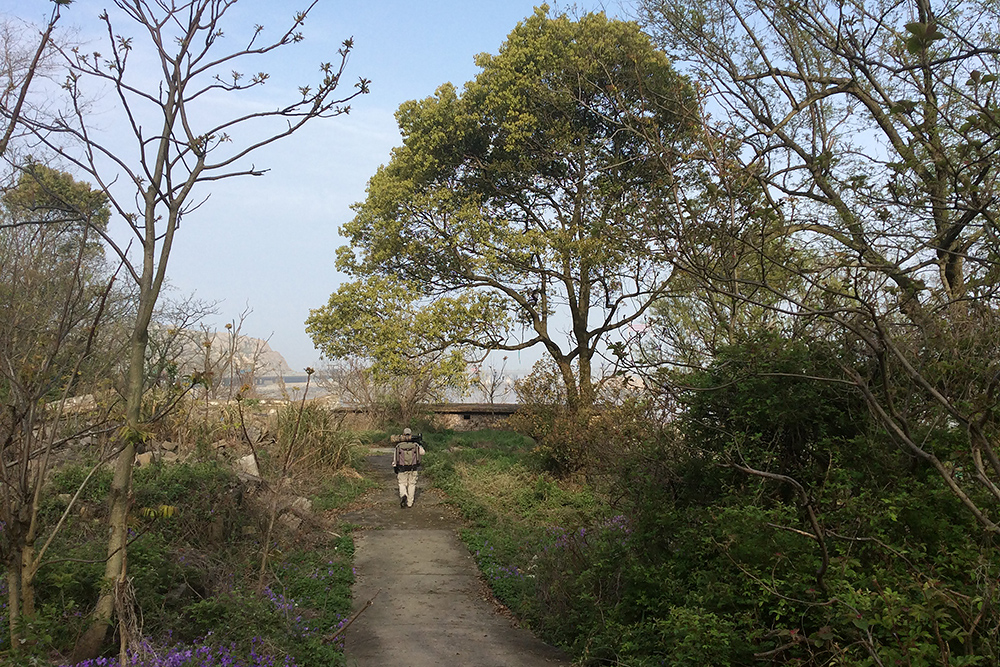
Thurs. 14 April 2016 Century Park
Sun. 17 April 2016 Lesser Yangshan and Nanhui
Tues. 19 April 2016 Shanghai Botanical Garden
From Thurs. 14 April to Tues. 19 April 2016, Elaine and I combined inner-city birding (Century Park, Shanghai Botanical Garden) with suburban-coastal birding (Nanhui, Lesser Yangshan). We noted 102 species. Sun. 17 April was the big day, with 95 species noted. Among them were 2 Chinese Egret and 3 singing Pale-legged Leaf Warbler on Lesser Yangshan and Rufous-faced Warbler, Swinhoe’s Minivet, and near-threatened Curlew Sandpiper at Nanhui. Among our many firsts-of-season were 10 Narcissus Flycatcher, 4 Eastern Crowned Warbler, 2 members of the Arctic Warbler Complex, and Yellow-browed Bunting. With the spring migration rolling on strong, even the city parks gave us seasonal firsts, with Eurasian Woodcock and Blue-and-white Flycatcher at Century on Thursday and Eyebrowed Thrush Tuesday at the Botanical Garden. During the 6-day period, we noted 0 raptors, whether Accipitriform, Strigiform, or Falconiform.
When silent, as is most often the case in Shanghai even in spring, Pale-legged Leaf Warbler and Sakhalin Leaf Warbler are indistinguishable, and a typical bird list this time of year includes the entry “Pale-legged/Sakhalin Leaf Warbler Phylloscopus tenellipes/borealoides.” The songs of these lookalikes are, however, distinct, and on Sunday in the wooded areas of Garbage Dump Valley on Lesser Yangshan we heard the cricket-like song of P. tenellipes. I made a recording (00:22; 1.7 MB):
On Tuesday, Elaine and I found a silent pair; they were moving along thick branches in the manner of a nuthatch and pumping their tail, but because they were not singing we could not ID them beyond Pale-legged/Sakhalin.
Garbage Dump Valley also yielded Meadow Bunting, Brown-flanked Bush Warbler, and Manchurian/Japanese Bush Warbler, and Temple Mount gave us a single Goldcrest as well as Swinhoe’s/Pin-tailed Snipe.
On Sunday, Blue-and-white Flycatcher were noted in Garbage Dump Valley, on Temple Mount, and at Nanhui and on Thursday at Century. Each male was studied carefully so as not to miss Zappey’s Flycatcher, a recently recognized species that has been recorded in Shanghai (by Swedish birder Jocko Hammar in 2014). This spring, we Shanghai birders will do well to study each Blue-and-white Flycatcher carefully, in particular adult males, lest we miss Zappey’s. In Forktail No. 28, August 2012, Paul Leader and Geoff Carey write: “Males from populations that breed in central China [i.e., Zappey’s] are distinct from other populations in being blue or blue-green across the breast, throat and ear-coverts, and in having black or blackish restricted to the lores. … The upperparts are typically blue-green.” There are various other distinctions, not noted here.
For the first time we noted Marsh Grassbird north of the Magic Parking Lot/Holiday Inn at Nanhui. This new location is on the road leading into the reed bed and lined with street lamps. Another, larger location is 30.866006, 121.939614, a point 2.8 km S of the lock at Nanhui and 4.1 km S of the Magic Parking Lot/Holiday Inn. We discovered Locustella pryeri at the southern location on 10 April and found them there again Sunday. 3 Reed Parrotbill were in the area, and Pallas’s Reed Bunting, so numerous just a few weeks ago, were nearly absent, most of them having departed for breeding areas north.
The Chinese Egret were our reward for never failing to scrutinize groups of Little Egret. Sure enough, our Egretta eulophotes were associating with 3 E. garzetta on a taut anchor line tethering a boat to the bottom of a little bay along Gangchi Road (30.612507, 122.105993). We are not sure whether our view is a one-off or whether something about that bay is attractive to that species.
At the Accidental (and probably Temporary) Wetland on Lesser Yangshan, we found the 2 Little Curlew, 1 of our 2 Garganey, Purple Heron, Black-tailed Godwit, 1 of our 6 Pacific Swift, 18 of our 80 Sharp-tailed Sandpiper, 2 Red-rumped Swallow, and Oriental Reed Warbler. Accidental Marsh sits on land reclaimed when a causeway was built linking Lesser Yangshan and Dazhitou Island. The coordinates of this spot are 30.611902, 122.114873. Bird this spot while the birding is good!
On Thurs. 14 April, Elaine and I birded Century Park, noting 31 species. 2 Eurasian Woodcock were seen in the forested area near Gate 7 known as “Woodcock Forest” (31.215413, 121.547678). There were impressive flocks of Brambling, 72 in all. Other highlights: Eurasian Hoopoe 1, Pale Thrush 23, White’s Thrush 2, and Chinese Blackbird 40, among them 2 fledglings.
The encounter with the woodcocks occurred just a few meters from the point where Elaine and I found this species last 30 Oct. Woodcock Forest is usually devoid of humans, and forest species tend to pool there. For best results, tiptoe in and scan silently. Do not forget to look into the canopy; I have seen sparrowhawks there.
We found no Yellow-bellied Tit, the only leaf warbler we found was a single Yellow-browed Warbler, and we thought low our count of just 1 Grey-backed Thrush. There were no other flycatchers besides the Blue-and-white.
As I have noted many times before, thieves are active at Century. On Thursday I had the unusual experience of thief-watching. Two folks were sitting on a park bench looking out over the lake. Elaine and I were standing far behind and noticed an ugly man in ratty clothing approach the couple from the forest behind them. He was moving in a catlike manner and was either casing the couple or was about to snatch something. I moved in noisily, and he slunk off.
This thief and others in his gang must be skillful, otherwise they wouldn’t have operated in the park so long. Their booty is phones, wallets, and purses, their victims distracted persons relaxing in the park. To avoid falling prey, keep your phone zipped in your pocket, leave nothing lying around, and use your powers of observation honed through birding to assess the people around you.
On Tues. 19 April, a walk through the Shanghai Botanical Garden netted Elaine and me 28 species. 2 Japanese Tit fledglings were following their parents and making begging calls, 4 Common Sandpiper were in Zhāngjiātáng Hé (张家塘河), and White’s Thrush, Grey-backed Thrush, Pale Thrush, and Eyebrowed Thrush were found in a quiet wooded area (31.147780, 121.438917) along the stream.
Sunday marked the reunion of the five-member Dream Team after a winter hiatus. Husband-wife members Stephan and Xueping Popp took many fine shots, and Stephan once again performed skillfully behind the wheel. Senior Birder Michael Grunwell combined sober experience with boyish enthusiasm, the latter particularly in evidence when he beheld Narcissus Flycatcher, a lifer for him. Elaine Du did her usual fine job keeping the list. Though I’m making a quick recovery from my intercostal muscle strain suffered 10 April, still I traveled light, eschewing photography and using only binoculars.
Have you viewed our recently created page, Birds Recorded at Century Park? There you can view all the species of bird recorded at urban Shanghai’s most birdable park.
List 1 of 1 for Tues. 19 April 2016 (28 species). Shanghai Botanical Garden (Shànghǎi Zhíwùyuán [上海植物园]; Gate 4 at 31.152036, 121.445856), an urban green space in Shanghai, China. Breezy, sunny, and clear; low 13° C, high 19° C. Visibility 10 km. Wind SSE 26 km/h. PM2.5 AQI: 74 (moderate). Sunrise 05:20, sunset 18:26. TUE 19 APR 2016 14:40-18:20. Craig Brelsford & Elaine Du.
Common Sandpiper Actitis hypoleucos 4
Spotted Dove Spilopelia chinensis 25
Common Kingfisher Alcedo atthis 2
Long-tailed Shrike Lanius schach 1
Azure-winged Magpie Cyanopica cyanus 24
Eurasian Magpie Pica pica 2
Japanese Tit Parus minor 4 (2 ad., 2 fledglings)
Light-vented Bulbul Pycnonotus sinensis 30
Barn Swallow Hirundo rustica 12
Yellow-browed Warbler Phylloscopus inornatus 1
Pale-legged/Sakhalin Leaf Warbler P. tenellipes/borealoides 2
Eastern Crowned Warbler P. coronatus 2
Vinous-throated Parrotbill Sinosuthora webbiana 3
Crested Myna Acridotheres cristatellus 6
White-cheeked Starling S. cineraceus 6
White’s Thrush Zoothera aurea 2
Grey-backed Thrush Turdus hortulorum 3
Chinese Blackbird T. mandarinus 40
Eyebrowed Thrush T. obscurus 1
Pale Thrush T. pallidus 1
Oriental Magpie-Robin Copsychus saularis 3
Red-flanked Bluetail Tarsiger cyanurus 1
Eurasian Tree Sparrow Passer montanus 10
White Wagtail Motacilla alba 1 leucopsis
Chinese Grosbeak Eophona migratoria 3
Grey-capped Greenfinch Chloris sinica 2
Tristram’s Bunting Emberiza tristrami 6
Black-faced Bunting E. spodocephala 1
Thurs. 21 April 2016 Zhongshan Park
Friday 22 April 2016 Century Park
Sat. 23 April 2016 Nanhui
Sun. 24 April 2016 Nanhui
On 21-24 April 2016, teaming up with Jan-Erik Nilsén and Michael Grunwell, Elaine Du and I noted 110 species. Our birding ranged from the inner city of Shanghai (Zhongshan Park, Century Park) to the coast at Nanhui. The highlight of this spring-mig bird pageant was Asian Dowitcher at Nanhui. The dowitcher was in a pool that also held 11 Chinese Egret. Nanhui also gave us endangered Black-faced Spoonbill, Far Eastern Curlew, and Great Knot and near-threatened Red Knot and Curlew Sandpiper. Among the other uncommon to scarce passage migrants were 4 Greater Sand Plover, 2 Pechora Pipit, 4 Brown-headed Thrush, 2 Siberian Blue Robin, 3 Siberian Rubythroat, and Citrine Wagtail. Joining them were 5 Terek Sandpiper, 3 Temminck’s Stint, 12 Long-toed Stint, 3 Eurasian Wryneck, 2 Eastern Crowned Warbler, 4 Japanese Thrush, 2 Eyebrowed Thrush, Mugimaki Flycatcher, 2 Blue-and-white Flycatcher, macronyx Eastern Yellow Wagtail, and 3 Tristram’s Bunting. We had impressive numbers (ca. 3180) of Barn Swallow, and picking through the clouds of hirundines we coaxed out 3 Pale/Sand Martin and 4 Red-rumped Swallow. Near-threatened Marsh Grassbird were singing in the reed bed at 30.866006, 121.939614. Near the grassbirds were Brown Crake, Reed Parrotbill, and Oriental Reed Warbler. A quick trip to Zhongshan Park on Thursday netted Narcissus Flycatcher and Yellow-rumped Flycatcher, and at Century Park on Friday we had Indian Cuckoo.
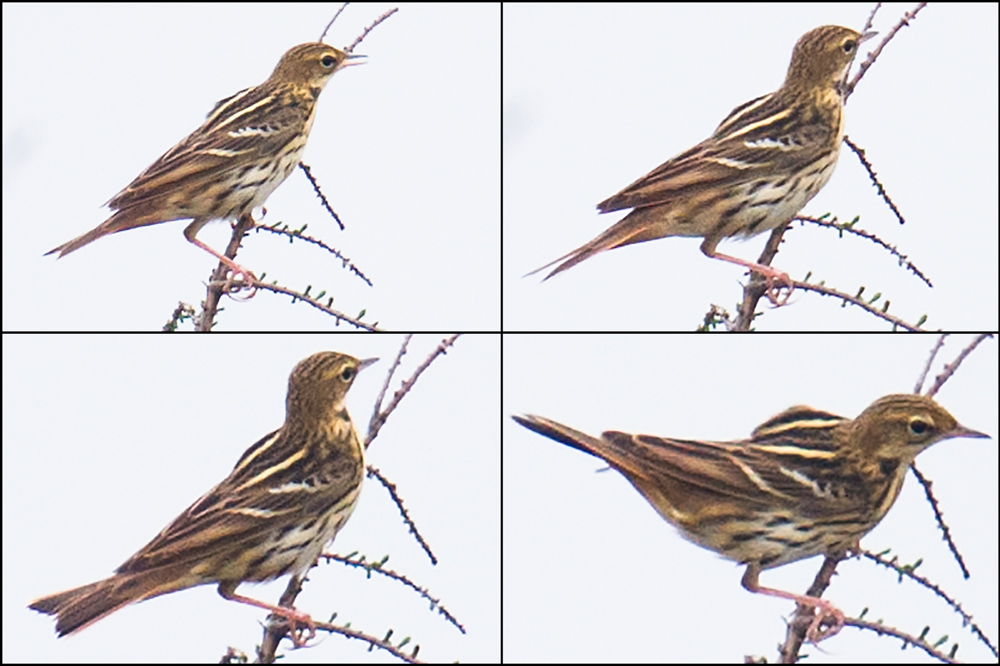
A Swede based in Beijing, Jan-Erik is an experienced birder and a friend. I have partnered with Jan-Erik in Qinghai (2014) and in Hulunbeier, Inner Mongolia (2015). Last year he introduced me to the Beijing-area birding hot spots.
Among Jan-Erik’s many strengths is his ear. When the rain finally let up on Sunday, Jan-Erik and I were walking between microforests on the Nanhui sea wall. “Pechora Pipit!” Jan-Erik cried. On a windy day, Jan-Erik’s sensitive ear had detected the hard, clicking call of a distant Pechora. I missed this one, but my adrenaline was running, and I ran back to our rented Buick, driven by Elaine. I put together my 600 mm lens and Nikon D3S, which had lain dormant throughout the rainy Saturday and Sunday morning. “Record-shot time!” I said to my wife. Almost as soon as I had set up my camera, I found another Pechora atop a tree. I had not seen Pechora Pipit since 2010. Jan-Erik’s strong hearing skills made the rare view possible.
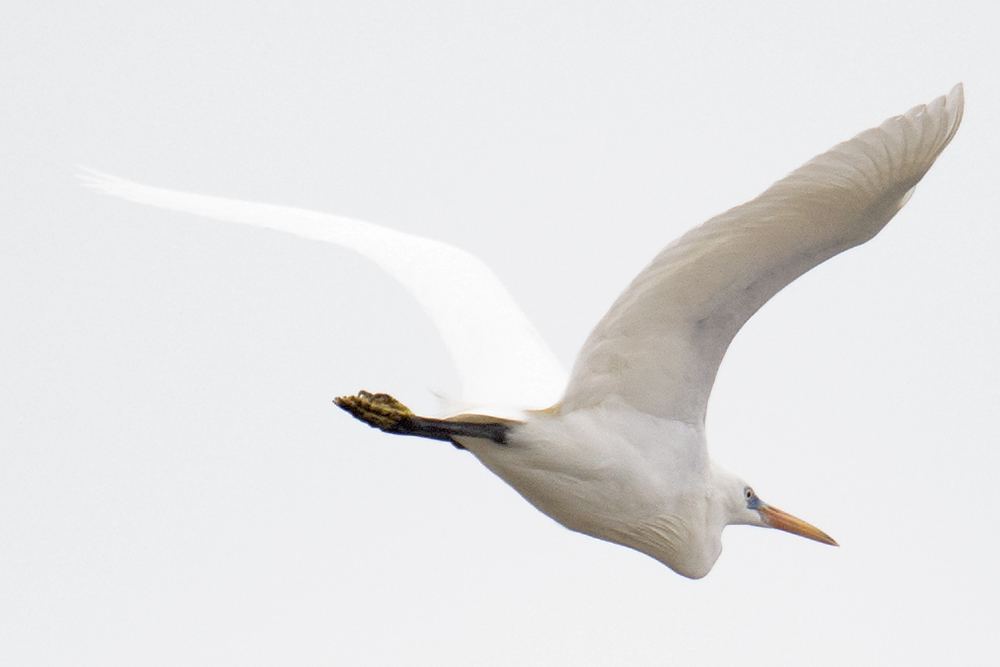
The teamwork continued later that day. At the dowitcher spot (30.877779, 121.955465), Elaine, using the spotting scope and scanning the pond below us, cried out, “Dowitcher! Maybe Asian!” Elaine had never seen Asian Dowitcher, but Michael Grunwell’s fascination with this bird had prepared Elaine for the possibility of encountering the species. Jan-Erik and I ran back, and I enjoyed my first-ever views of the near-threatened species. Great spot, Elaine!

Jan-Erik arrived late Thursday night. On Friday we did light birding at Century, noting 29 species. On Saturday and Sunday I had the pleasure of introducing Jan-Erik to Nanhui. We noted 99 species over the weekend, and we had the added pleasure of having Michael Grunwell join us Saturday. Despite the rain, I have rarely been happier birding than I was Saturday, for on that day the two birders who have taught me the most were finally in the same car together. Michael is a British birder who has been living in Shanghai since last year.
The bad weather kept us off Lesser Yangshan Island and dashed our hopes of visiting Hengsha Island. As darkness fell Saturday, we drove Michael to the Dishui Lake Metro Station. Jan-Erik, Elaine, and I spent the night at the Holiday Inn at Nanhui. This proved to be a good move, for staying at Nanhui saved me a 90-km drive back to the city after an exhausting day and put us in position for an early start Sunday. A sea-view room cost 500 yuan, money we considered well-invested.
List 1 of 1 for Thurs. 21 April 2016 (13 species)
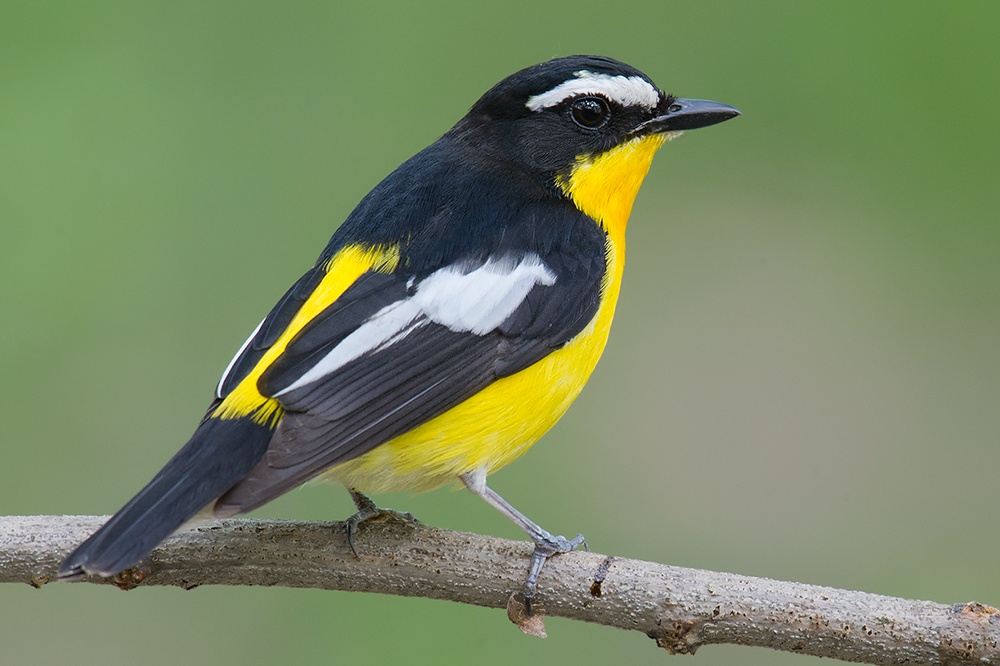
Zhongshan Park (Zhōngshān Gōngyuán [中山公园]; 31.221888, 121.420066), urban green space in Shanghai, China. Mostly cloudy; low 16° C, high 24° C. Visibility 10 km. Wind NW 15 km/h. PM2.5 AQI: 137 (unhealthful). Sunrise 05:18, sunset 18:27. THU 21 APR 2016 15:35-17:25. Craig Brelsford & Elaine Du.
Spotted Dove Spilopelia chinensis 8
Japanese Tit Parus minor 7 (2 fledglings)
Light-vented Bulbul Pycnonotus sinensis 20
Black-throated Bushtit Aegithalos concinnus 5
Yellow-browed Warbler Phylloscopus inornatus 9 (3 singing)
Vinous-throated Parrotbill Sinosuthora webbiana 7
Chinese Blackbird Turdus mandarinus 17 (1 fledgling)
Oriental Magpie-Robin Copsychus saularis 1 singing
Yellow-rumped Flycatcher Ficedula zanthopygia 1
Narcissus Flycatcher F. narcissina 1
Eurasian Tree Sparrow Passer montanus 30
White Wagtail Motacilla alba 1 leucopsis
Chinese Grosbeak Eophona migratoria 3
List 1 of 1 for Fri. 22 April 2016 (29 species)
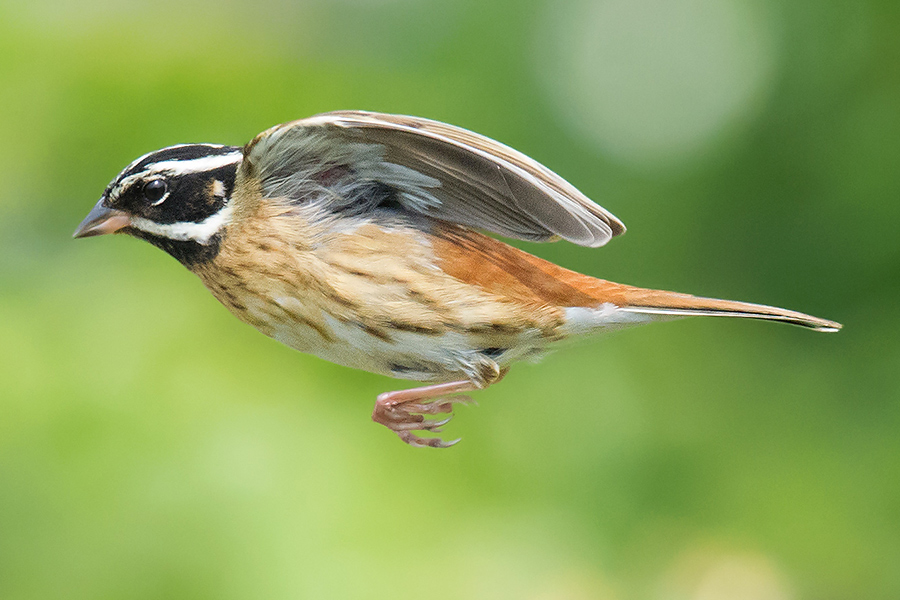
Birds noted at Century Park (Shìjì Gōngyuán [世纪公园]; 31.219361, 121.551900), Pudong New Area (Pǔdōng Xīn Qū [浦东新区]), Shanghai, China. Cloudy; low 13° C, high 25° C. Visibility 10 km. Wind SSW 11 km/h. Sunrise 05:17, sunset 18:28. FRI 22 APR 2016 15:30-18:20. Craig Brelsford, Elaine Du, & Jan-Erik Nilsén.
Mallard Anas platyrhynchos 1
Little Grebe Tachybaptus ruficollis 2
Black-crowned Night Heron Nycticorax nycticorax 3
Little Egret Egretta garzetta 4
Common Moorhen Gallinula chloropus 4
Feral Pigeon (Rock Dove) Columba livia 1
Oriental Turtle Dove Streptopelia orientalis 1
Spotted Dove Spilopelia chinensis 35
Indian Cuckoo Cuculus micropterus 1 singing
Long-tailed Shrike Lanius schach 2
Azure-winged Magpie Cyanopica cyanus 30
Japanese Tit Parus minor 7 (2 fledglings)
Light-vented Bulbul Pycnonotus sinensis 30
Barn Swallow Hirundo rustica 5
Yellow-browed Warbler Phylloscopus inornatus 7
Arctic/Kamchatka Leaf/Japanese Leaf Warbler P. borealis/examinandus/xanthodryas 1
Vinous-throated Parrotbill Sinosuthora webbiana 5
Crested Myna Acridotheres cristatellus 3
Red-billed Starling Spodiopsar sericeus 6
White’s Thrush Zoothera aurea 1
Grey-backed Thrush Turdus hortulorum 1
Chinese Blackbird T. mandarinus 24 (3 fledglings)
Pale Thrush T. pallidus 1
Blue-and-white Flycatcher Cyanoptila cyanomelana 1
Eurasian Tree Sparrow Passer montanus 10
Olive-backed Pipit Anthus hodgsoni 5
Chinese Grosbeak Eophona migratoria 6
Tristram’s Bunting Emberiza tristrami 11
Black-faced Bunting E. spodocephala 5
Have you viewed our recently created page, Birds Recorded at Century Park? There you can view all the species of bird recorded at urban Shanghai’s most birdable park.
List 1 of 1 for Sat. 23 April 2016 (76 species)
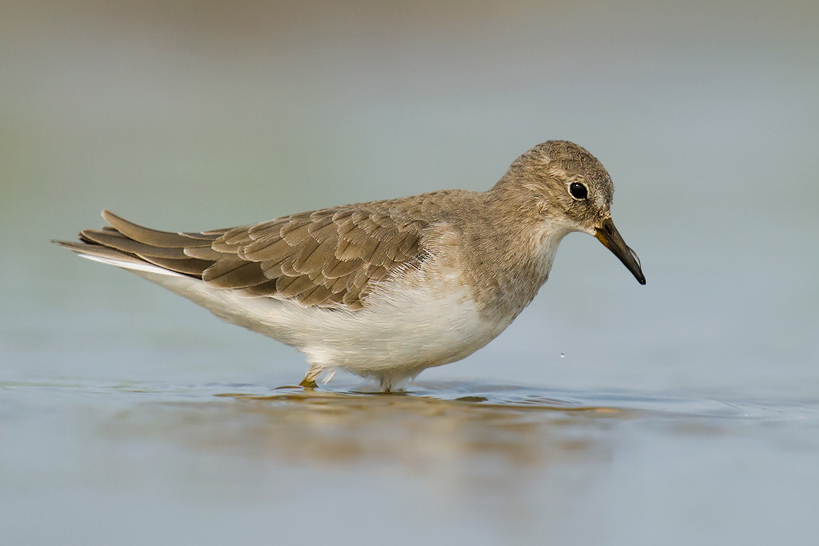
Birds noted around Pudong Nanhui Dongtan Wetland (Pǔdōng Nánhuì Dōngtān Shīdì [浦东南汇东滩湿地]), Shanghai, China (30.920507, 121.973159). List includes birds found along Shijitang Road from 31.000204, 121.938145 S to 30.851114, 121.848527. Rainy & windy. Low 14° C, high 16° C. Wind E 26 km/h. Visibility 10 km. PM2.5 AQI: 107 (unhealthful). Sunrise 05:16, sunset 18:29. SAT 23 APR 2016 06:00-17:15. Craig Brelsford, Elaine Du, Michael Grunwell, & Jan-Erik Nilsén.
Eurasian Wigeon Anas penelope 10
Eastern Spot-billed Duck A. zonorhyncha 12
Garganey A. querquedula 2 (pair)
Japanese Quail Coturnix japonica 2
Common Pheasant Phasianus colchicus 2
Little Grebe Tachybaptus ruficollis 9
Great Crested Grebe Podiceps cristatus 6
Eurasian Spoonbill Platalea leucorodia 10
Black-faced Spoonbill P. minor 3
Chinese Pond Heron Ardeola bacchus 12
Eastern Cattle Egret Bubulcus coromandus 1
Grey Heron Ardea cinerea 3
Great Egret A. alba 1
Intermediate Egret A. intermedia 2
Little Egret Egretta garzetta 14
Brown Crake Amaurornis akool 1
Common Moorhen Gallinula chloropus 5
Eurasian Coot Fulica atra 6
Black-winged Stilt Himantopus himantopus 6
Little Ringed Plover Charadrius dubius 15
Kentish Plover C. alexandrinus 15
Lesser Sand Plover C. mongolus 11
Greater Sand Plover C. leschenaultii 4
Pin-tailed/Swinhoe’s Snipe Gallinago stenura/megala 3
Common Snipe G. gallinago 12
Whimbrel Numenius phaeopus 7
Common Redshank Tringa totanus 8
Marsh Sandpiper T. stagnatilis 20
Common Greenshank T. nebularia 38
Wood Sandpiper T. glareola 3
Terek Sandpiper Xenus cinereus 2
Common Sandpiper Actitis hypoleucos 3
Ruddy Turnstone Arenaria interpres 2
Red-necked Stint Calidris ruficollis 50
Temminck’s Stint C. temminckii 3
Long-toed Stint C. subminuta 8
Sharp-tailed Sandpiper C. acuminata 10
Dunlin C. alpina 7
Black-headed Gull Chroicocephalus ridibundus 20
Vega Gull Larus vegae vegae/L. v. mongolicus 3
Gull-billed Tern Gelochelidon nilotica 17
Whiskered Tern Chlidonias hybrida 12
Feral Pigeon (Rock Dove) Columba livia 2
Spotted Dove Spilopelia chinensis 1
Common Kingfisher Alcedo atthis 2
Long-tailed Shrike Lanius schach 6
Oriental Skylark Alauda gulgula 10
Light-vented Bulbul Pycnonotus sinensis 12
Pale/Sand Martin Riparia diluta/riparia 1
Barn Swallow Hirundo rustica 180
Red-rumped Swallow Cecropis daurica 1
Japanese/Manchurian Bush Warbler Horornis diphone canturians/H. borealis borealis 1 singing
Yellow-browed Warbler Phylloscopus inornatus 2
Marsh Grassbird Locustella pryeri 2 singing
Zitting Cisticola Cisticola juncidis 5
Plain Prinia Prinia inornata 2
Vinous-throated Parrotbill Sinosuthora webbiana 50
Reed Parrotbill Paradoxornis heudei 2
Crested Myna Acridotheres cristatellus 8
White-cheeked Starling Spodiopsar cineraceus 40
Grey-backed Thrush Turdus hortulorum 1
Japanese Thrush T. cardis 2
Eyebrowed Thrush T. obscurus 1
Pale Thrush T. pallidus 3
Asian Brown Flycatcher Muscicapa latirostris 1
Stejneger’s Stonechat Saxicola stejnegeri 4
Eurasian Tree Sparrow Passer montanus ca. 50
Eastern Yellow Wagtail Motacilla tschutschensis 180 (120 tschutschensis, 20 taivana)
Citrine Wagtail M. citreola 1
White Wagtail M. alba 9 (6 leucopsis, 2 ocularis, 1 lugens)
Olive-backed Pipit Anthus hodgsoni 3
Red-throated Pipit A. cervinus 15
Chestnut-eared Bunting Emberiza fucata 2
Little Bunting E. pusilla 8
Black-faced Bunting E. spodocephala 30
Pallas’s Reed Bunting E. pallasi 6
List 1 of 1 for Sun. 24 April 2016 (79 species)
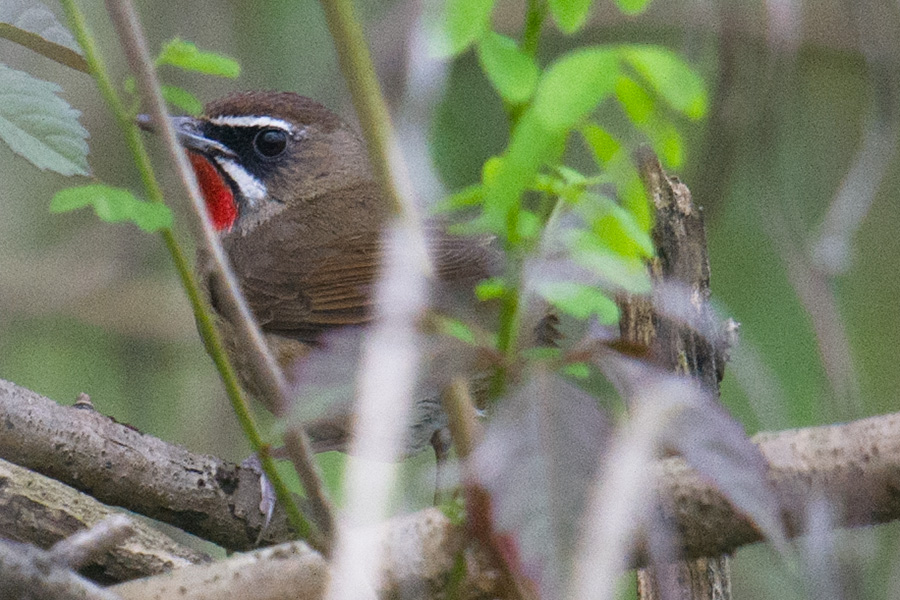
Birds noted around Pudong Nanhui Dongtan Wetland (Pǔdōng Nánhuì Dōngtān Shīdì [浦东南汇东滩湿地]), Shanghai, China (30.920507, 121.973159). List includes birds found along Shijitang Road from 31.000204, 121.938145 S to 30.851114, 121.848527. Rainy in morning, then cloudy. Low 13° C, high 17° C. Wind ENE 21 km/h. Visibility 10 km. PM2.5 AQI: 139 (unhealthful). Sunrise 05:15, sunset 18:29. SUN 24 APR 2016 05:45-13:10. Craig Brelsford, Elaine Du, & Jan-Erik Nilsén.
Common Pheasant Phasianus colchicus 2
Little Grebe Tachybaptus ruficollis 2
Black-faced Spoonbill Platalea minor 17
Chinese Pond Heron Ardeola bacchus 3
Grey Heron Ardea cinerea 2
Little Egret Egretta garzetta 13
Chinese Egret E. eulophotes 11
Grey Plover Pluvialis squatarola 1
Little Ringed Plover Charadrius dubius 4
Kentish Plover C. alexandrinus 5
Lesser Sand Plover C. mongolus 2
Lesser/Greater Sand Plover C. mongolous/leschenaultii 5
Pin-tailed/Swinhoe’s Snipe Gallinago stenura/megala 1
Common Snipe G. gallinago 15
Asian Dowitcher Limnodromus semipalmatus 1
Whimbrel Numenius phaeopus 10
Far Eastern Curlew N. madagascariensis 2
Common Redshank Tringa totanus 4
Marsh Sandpiper T. stagnatilis 30
Common Greenshank T. nebularia 15
Wood Sandpiper T. glareola 8
Terek Sandpiper Xenus cinereus 3
Common Sandpiper Actitis hypoleucos 3
Great Knot Calidris tenuirostris 1
Red Knot C. canutus 2
Red-necked Stint C. ruficollis 60
Temminck’s Stint C. temminckii 1
Long-toed Stint C. subminuta 4
Sharp-tailed Sandpiper C. acuminata 5
Curlew Sandpiper C. ferruginea 1
Vega Gull Larus vegae vegae/L. v. mongolicus 1
Whiskered Tern Chlidonias hybrida 14
Oriental Turtle Dove Streptopelia orientalis 2
Spotted Dove Spilopelia chinensis 3
Common Kingfisher Alcedo atthis 2
Eurasian Wryneck Jynx torquilla 3
Brown Shrike Lanius cristatus 1
Long-tailed Shrike L. schach 3
Chinese Penduline Tit Remiz consobrinus 5
Oriental Skylark Alauda gulgula 15
Light-vented Bulbul Pycnonotus sinensis 30
Pale/Sand Martin Riparia diluta/riparia 2
Barn Swallow Hirundo rustica ca. 3000
Red-rumped Swallow Cecropis daurica 3
Japanese/Manchurian Bush Warbler Horornis diphone canturians/H. borealis borealis 1 singing
Yellow-browed Warbler Phylloscopus inornatus 2
Arctic/Kamchatka Leaf/Japanese Leaf Warbler P. borealis/examinandus/xanthodryas 1
Pale-legged/Sakhalin Leaf Warbler P. tenellipes/borealoides 2
Eastern Crowned Warbler P. coronatus 2
Oriental Reed Warbler Acrocephalus orientalis 20 singing
Marsh Grassbird Locustella pryeri 3 singing
Plain Prinia Prinia inornata 2
Vinous-throated Parrotbill Sinosuthora webbiana 50
Reed Parrotbill Paradoxornis heudei 2
Crested Myna Acridotheres cristatellus 10
White’s Thrush Zoothera aurea 1
Grey-backed Thrush Turdus hortulorum 8
Japanese Thrush T. cardis 2
Eyebrowed Thrush T. obscurus 1
Pale Thrush T. pallidus 10
Brown-headed Thrush T. chrysolaus 4
Asian Brown Flycatcher Muscicapa latirostris 3
Blue-and-white Flycatcher Cyanoptila cyanomelana 2
Siberian Blue Robin Larvivora cyane 2
Siberian Rubythroat Calliope calliope 3
Mugimaki Flycatcher Ficedula mugimaki 1
Stejneger’s Stonechat Saxicola stejnegeri 4
Eurasian Tree Sparrow Passer montanus 30
Eastern Yellow Wagtail Motacilla tschutschensis 100 (60 tschutschensis, 10 taivana, 1 macronyx)
Grey Wagtail M. cinerea 2
White Wagtail M. alba 5 leucopsis
Richard’s Pipit Anthus richardi 4
Olive-backed Pipit Anthus hodgsoni 5
Pechora Pipit A. gustavi 2
Red-throated Pipit A. cervinus 1
Tristram’s Bunting Emberiza tristrami 3
Chestnut-eared Bunting E. fucata 3
Little Bunting E. pusilla 1
Black-faced Bunting E. spodocephala 40
Pallas’s Reed Bunting E. pallasi 2
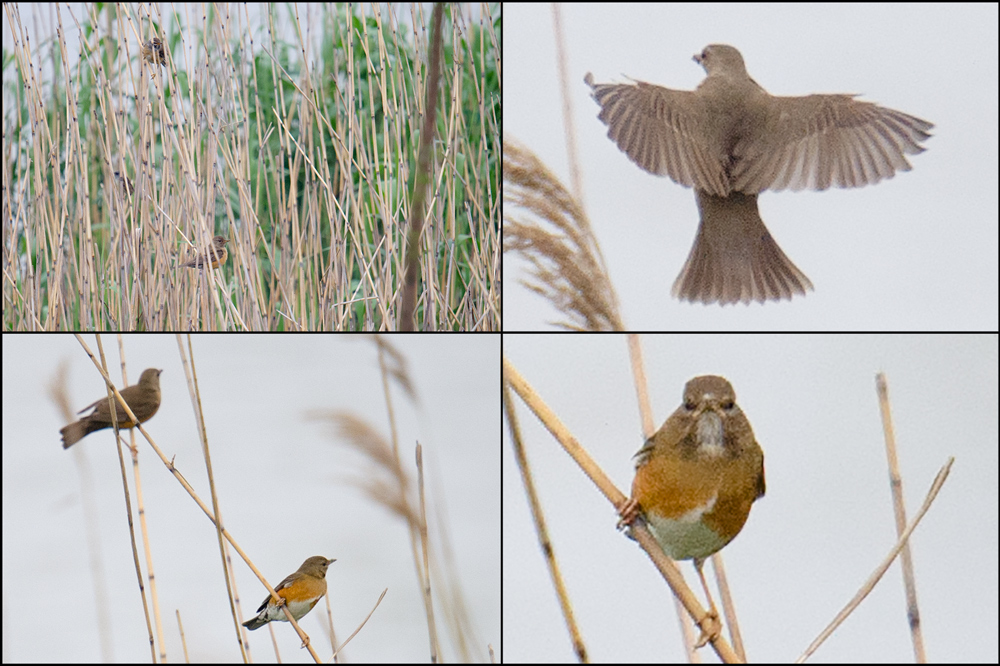
Thurs. 28 April 2016 Zhongshan Park
Sat. 30 April 2016 Lesser Yangshan and Nanhui
Sun. 1 May 2016 Nanhui
Elaine and I noted 112 species over May Day weekend 2016. We did island birding on Lesser Yangshan, coastal birding at Nanhui, and inner-city birding at Zhongshan Park. Highlights were 26 Pechora Pipit, 6 of them singing, plus (Japanese) Yellow Bunting and 2 endangered Yellow-breasted Bunting at Nanhui. Nanhui also gave us 3 Chinese Egret, a rare view of Large Hawk-Cuckoo, endangered Far Eastern Curlew and 4 near-threatened Curlew Sandpiper, and high-value passage migrants such as Chinese Sparrowhawk, Asian Stubtail, Brown-headed Thrush, Siberian Blue Robin, Narcissus Flycatcher, Mugimaki Flycatcher, and Chestnut Bunting. Lesser Yangshan yielded 2 Rufous-tailed Robin singing from cover, Pheasant-tailed Jacana, Greater Sand Plover, Pacific Golden Plover, 18 near-threatened Grey-tailed Tattler, 2 Broad-billed Sandpiper, and Taiga Flycatcher. Seasonal firsts were numerous and included Little Tern, Dusky Warbler, and Black-browed Reed Warbler at Nanhui and Grey-streaked Flycatcher on Lesser Yangshan. On Sat. 30 April and Sun. 1 May we birded with veteran English birder Michael Grunwell.
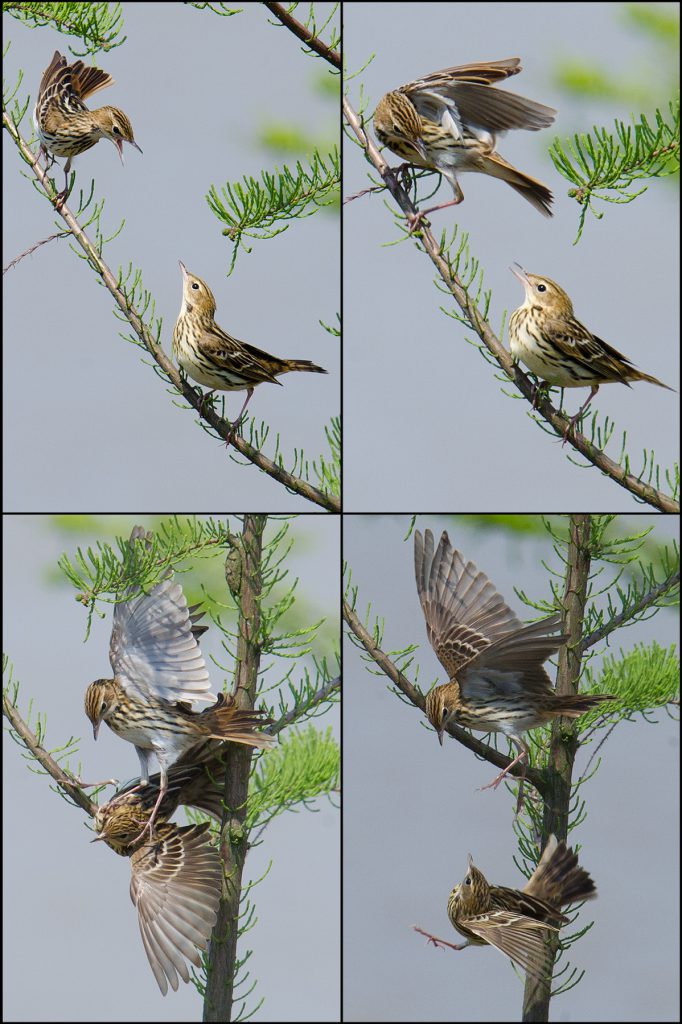
On Saturday near Microforest 2 at Nanhui, Michael enjoyed his first views of Pechora Pipit in 26 years while Elaine and I enjoyed our second view in a week of this scarce passage migrant. Those views were just a prelude to the excitement of Sunday. Again at Nanhui, driving along the sea-wall road, we began finding Pechoras. Some of them were singing; two of them were sparring. We decided to make a survey of this scarce passage migrant. Driving slowly from the Holiday Inn north, we scanned the thickly vegetated inner base of the sea wall. Thousands of trees have been planted there recently, giving the Pechoras perches and making them easier to see. We counted 26. Here is the song I recorded of Pechora Pipit (00:27; 1.9 MB):
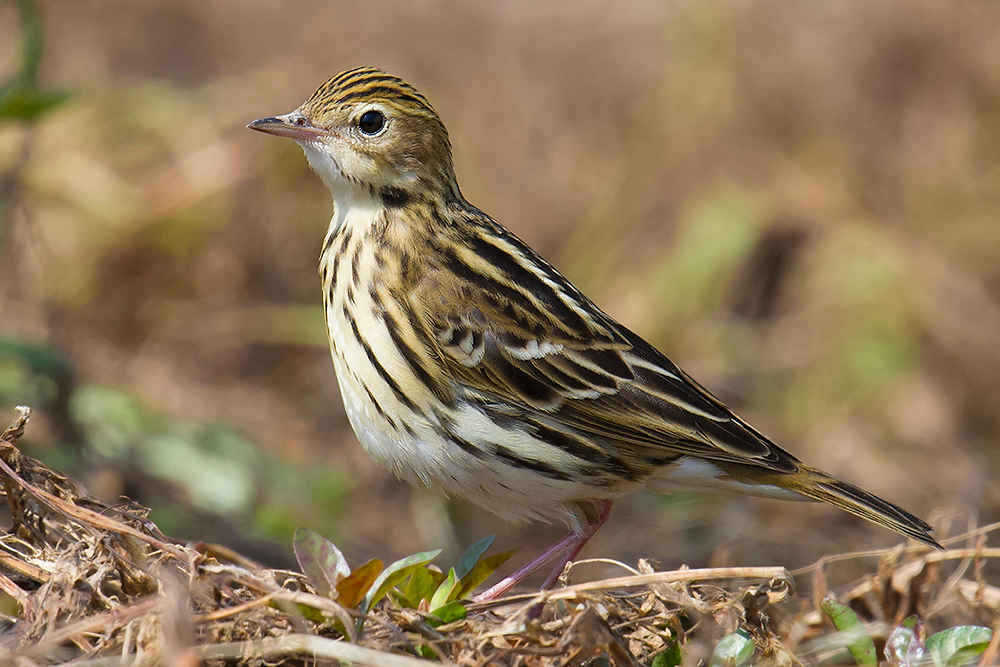
Saturday began with a 4 a.m. pickup of Michael and 90-minute drive to Lesser Yangshan. We went first to Accidental Marsh (30.611902, 122.114873). Accidental Marsh is several hectares of newly formed wetland created by the construction of a causeway linking Lesser Yangshan and Dazhitou Island. Besides the waders noted above, we found singing Oriental Reed Warbler, and we rejoiced because for a change we had found a place where the reed-bed habitat of that species is expanding, rather than contracting, as is so often the case on the beleaguered Chinese coast. Another interesting record there was Black-collared Starling, uncommon in the Shanghai region. Moving to Garbage Dump Gully (30.641565, 122.062836), we found Black Drongo and the Rufous-tailed Robin singing from cover. On the half-destroyed Garbage Dump Coastal Plain next to the Gully, we met a lone Pacific Golden Plover.
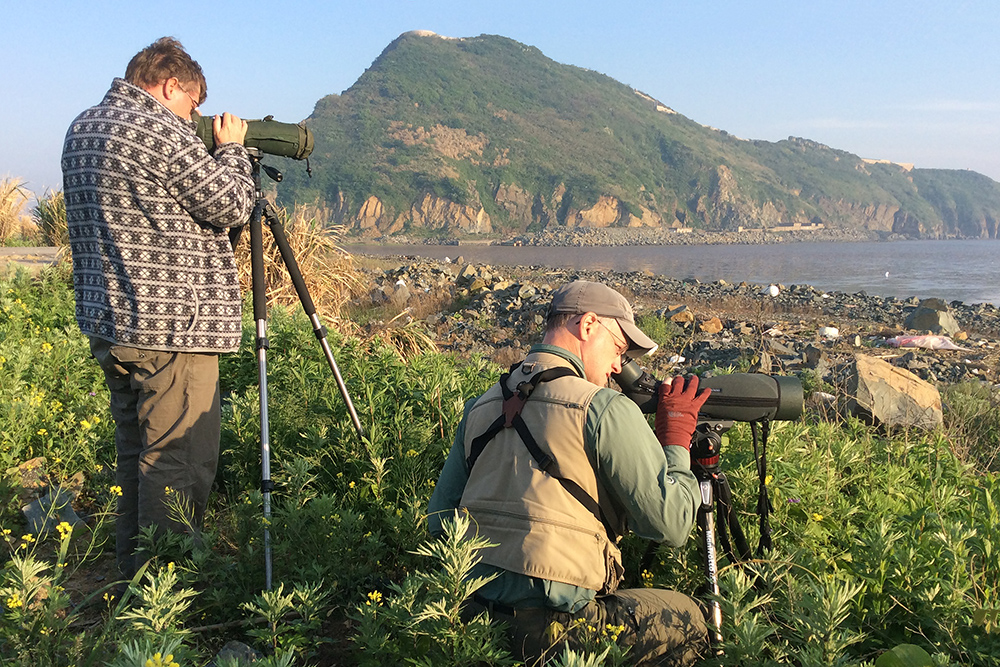
We drove back to the mainland and remained at Nanhui the rest of Saturday and all of Sunday. We noticed once again that the Magic Parking Lot (30.882688, 121.972489) and nearby areas are turning into a circus, especially on holiday weekends. Upwards of 300 cars are parked there at midday, and though the Parking Lot is an effective migrant trap, on weekends in good weather birding the Lot is difficult after 9 a.m.
In light of the new popularity of the Lot as well as the continued flattening of the local reed beds, we are looking for new areas to bird. We found a place we are calling South Lock (30.857798, 121.914106). South Lock is the area around the place where the S2 expressway meets the mainland. A sluice gate is nearby, hence the name. On Saturday, trees at South Lock were holding Eastern Crowned Warbler, a species beloved by Michael, and the adjacent ponds and marshes held waders and buntings and gave us our only weekend record of Grey Wagtail. A stop there on Sunday morning gave us our Dusky Warbler. South Lock looks good and because so near the freeway may remain undeveloped. Another new area for us is South Lawn (midpoint at 30.849840, 121.897953), a stretch of grassy land at the inner base of the sea wall north of Luchao (Lúcháo Gǎng [芦潮港]). There we found flocks of Eastern Yellow Wagtail containing members of the nominate race as well as taivana.
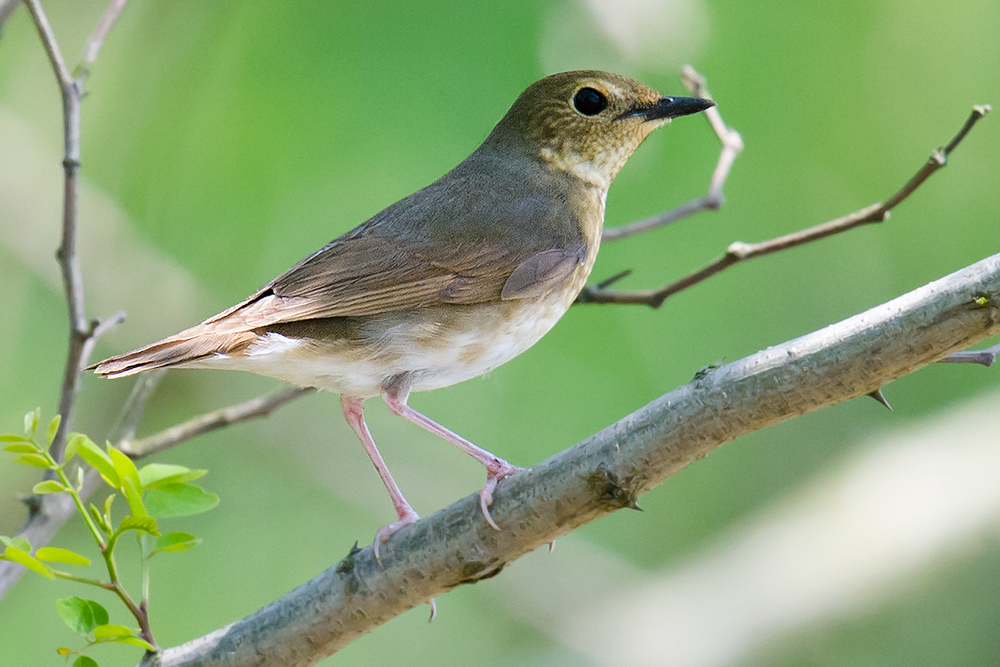
All four of our views of Siberian Blue Robin occurred in the Nanhui microforests. In Shanghai, Sibe Blue offers a good example of how migrant traps work. This species will spend the summer in thick cover in the great forests of northeastern China, the Russian Far East, Sakhalin Island, and Japan. It is a master skulker. Flying up the Nanhui coast, with its dearth of forest cover, a Sibe Blue sees the microforests the same way a tired traveler sees a hotel after a long day on the road. In the Nanhui microforests, now thickly carpeted with daisies and grasses, watch your step! Tired migrants such as Asian Stubtail, Sibe Blue, Rufous-tailed Robin, and Pale Thrush will wait until your foot is inches away before exploding out.
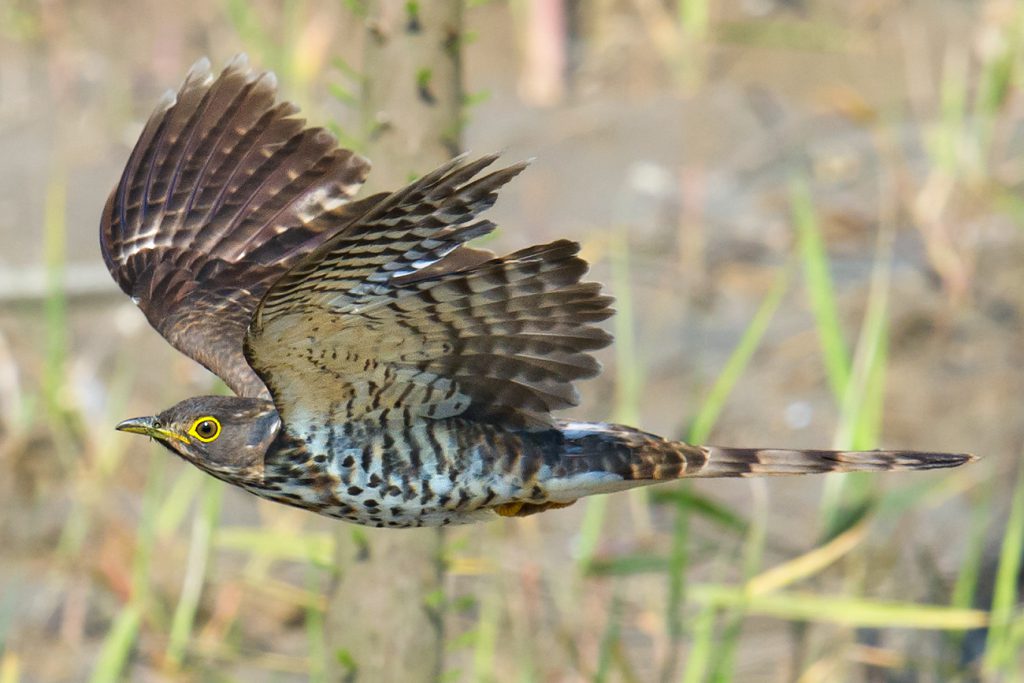
May Day is arguably the height of migration season in the Shanghai region. On sunny, warm days such as Sunday, the stimulation is constant, and exciting moments are many. Here is just one of many anecdotes: Nanhui, Sunday morning. Through Michael’s spotting scope I am enjoying a view of an endangered Yellow-breasted Bunting that he and Elaine found. As I watch, a Pechora Pipit jumps into the circular view and drives the bunting away. An endangered bunting being chased away by a scarce passage migrant! Wow! Then Michael calls out that he has just seen a raptor. The bird disappears, and we get into our rented Buick and drive toward the trees into which it vanished. As we drive, out jumps Large Hawk-Cuckoo! Three rare Shanghai records in the space of five minutes!
The view of Yellow Bunting was team birding at its best. We were driving slowly on the semi-abandoned low road discovered a few months back by Michael. (The starting point of this road, which leads inland from a point behind the Magic Parking Lot, is 30.885592, 121.967369.) As we drove, we were kicking up foraging buntings, mainly Black-faced Bunting. Elaine and I, sitting up front, were the first to notice an anomaly: a yellow-shaded bunting with a mustache and goatee. It had to be Yellow Bunting! The bird disappeared. Michael and Elaine were going for a lifer, so we had to work carefully. We stopped the car and walked up and down the road, six eyeballs searching for the rare migrant. Elaine found it! Michael and I came running. Luckily for us, the bunting had found a feeding area it liked; it was loath to leave the road. Michael was ecstatic as he set up his spotting scope and watched the bunting feed.
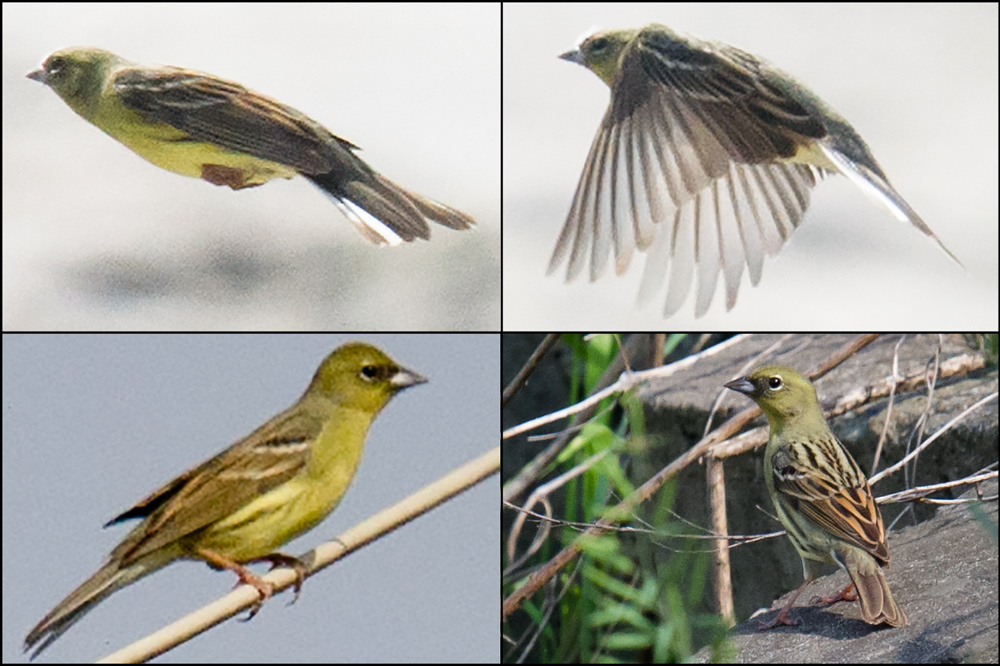
On Thurs. 28 April, Elaine and I did a quick walk-through at Shanghai’s Zhongshan Park. The park is more than a hundred years old, has many tall trees, and offers some of the best mid-sized urban-park birding in Earth’s largest city. Zhongshan holds sentimental value for me because it is where I ticked Elaine as a lifer (i.e., I met her there).
Our visit of less than two hours brought Elaine and me six passage migrants: Yellow-browed Warbler, Sakhalin/Pale-legged Leaf Warbler, Eastern Crowned Warbler, Narcissus Flycatcher, Mugimaki Flycatcher, and Tristram’s Bunting. A seventh, Blue-and-white Flycatcher, was reported by another birder.
The focal point at Zhongshan is the little central pond (31.224111, 121.414194). On Thursday all 3 Narcissus Flycatcher were noted there, among them a female, as well as our Eastern Crowned Warbler and Pale-legged/Sakhalin Leaf Warbler. A tiny island in the center of the pond is almost cat-free (some cats do make the jump) and contains several large trees. Thanks to the nearly daily presence there of bird photographer Wāng Jìn Róng (汪进荣), the central pond is an information clearinghouse; Mr. Wang and his buddies are always eager to tell you what they have been seeing lately.
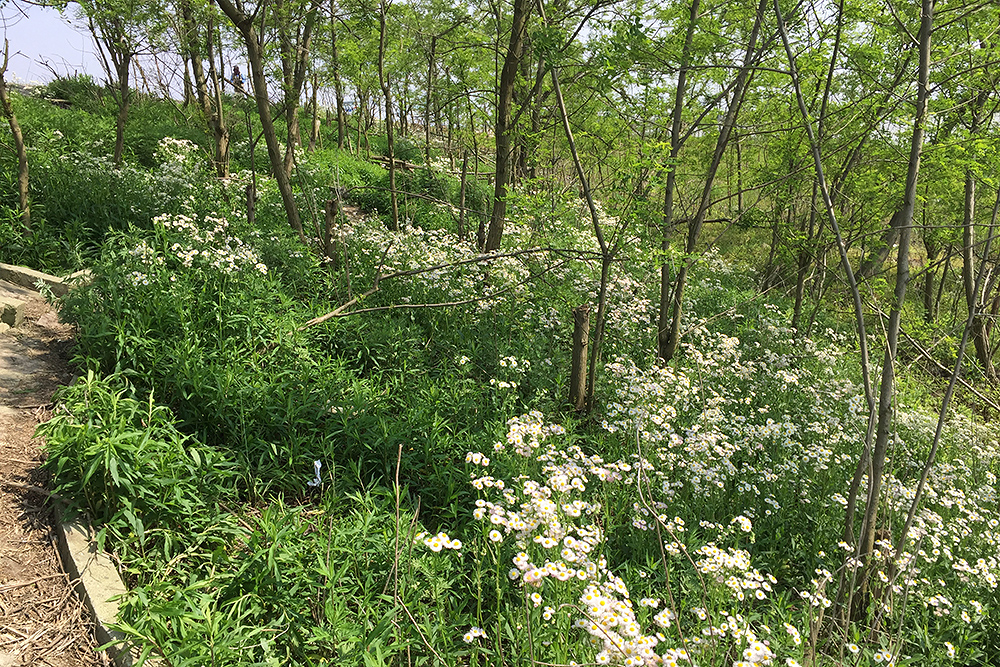
Thurs. 5 May 2016
Zhongshan Park
Today, 5 May 2016, I got my first-ever record of Sakhalin Leaf Warbler. The bird was singing on the tiny island at the little central pond (31.224111, 121.414194) at Zhongshan Park, Shanghai. Singing nearby was Pale-legged Leaf Warbler. These lookalike species were two of the seven species of passage migrant I noted, the others being Ashy Minivet, Yellow-browed Warbler, Eastern Crowned Warbler, at least one Turdus sp. that was not Chinese Blackbird, Asian Brown Flycatcher, Narcissus Flycatcher, and Mugimaki Flycatcher.
I saw a Pale-legged or Sakhalin Leaf Warbler, pulled out my iPhone, and played back a recording of Pale-legged. I got no response. I played Sakhalin for a while, got no response, then stopped. I knew not to walk away, but wait. As Shanghai is outside the breeding range of both species, their urge to sing may not be strong, but it is May and the testosterone is flowing. A response may come after a lag.
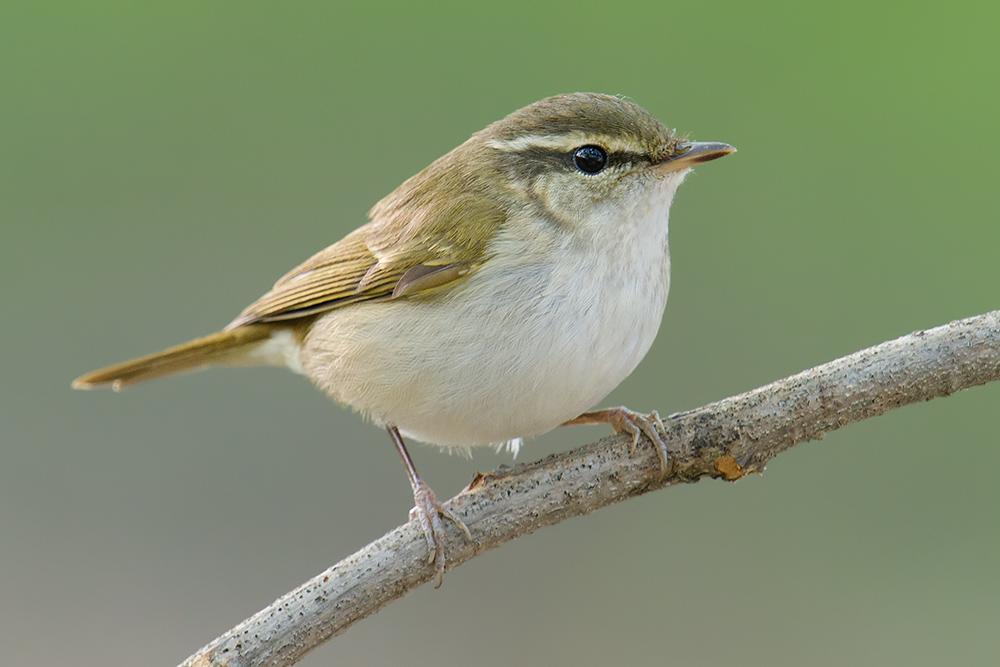
I was standing at the edge of the little pond, admiring Narcissus Flycatcher. My brain was barely registering the normal background noise being made by Japanese Tit, Light-vented Bulbul, Chinese Blackbird, Chinese Grosbeak, caged Chinese Hwamei, and old folks practicing qigong. Suddenly from the din came an anomalous sound. I trained my attention to the high-pitched whistle. Sakhalin! My playback had apparently been heard and had attracted a Sakhalin to the tree on the island closest to me on the “mainland.” I glimpsed the bird but saw nothing in its plumage or bare parts to tell it from Pale-legged. In the field, the only reliable element separating the two species is song. Sakhalin makes a three-note whistle, very different from the cricket-like trill of Pale-legged. The three-note whistle is exactly what I was hearing.
After a few minutes, the singing stopped, and then, as if on cue, the trill of Pale-legged surged out from the foliage. I again played back Pale-legged recordings and this time got an immediate and very strong response. Making the “tink” call, a Pale-legged flew to my side of the pond and lingered in trees near me. The tink is apparently similar to that of Sakhalin and therefore not a reliable separator. But soon the tink was followed by another trill, and I knew I was looking at Pale-legged.
What luck! There I was, in the middle of Earth’s largest city, hearing the songs of two East Asian leaf warblers, one of them (Sakhalin) little-known. Does urban birding get any better than this?

I sound-recorded both species. In all, one can hear the din from a busy inner-city park. In the first of the two song fragments of Sakhalin Leaf Warbler, among the species heard in the background is Ashy Minivet.
Sakhalin Leaf Warbler, Song Fragments 1/2 (00:51; 2.8 MB)
Sakhalin Leaf Warbler, Song Fragments 2/2 (00:36; 2.2 MB)
Pale-legged Leaf Warbler, Trill (00:03; 922 KB)
Pale-legged Leaf Warbler, Tink (00:15; 1.4 MB)
Thanks to Jan-Erik Nilsén, Jonathan Martinez, and Jason Loghry for their help in today’s project.
Sat. 7 May 2016 Lesser Yangshan and Nanhui
Sun. 8 May 2016 Nanhui
Elaine Du and I noted 86 species over the rainy weekend of 7-8 May 2016. We had White-shouldered Starling, Siberian Blue Robin, and Chestnut Bunting on Lesser Yangshan Island and Chinese Egret, Black-faced Spoonbill, and Curlew Sandpiper at Nanhui. I got my best view of Sakhalin Leaf Warbler at Nanhui, and on Yangshan our partner Michael Grunwell got his best view of Yellow-rumped Flycatcher. Other passage migrants were Brown Shrike, Eyebrowed Thrush, Siberian Rubythroat, and season’s first Dark-sided Flycatcher at Nanhui and Blue-and-white Flycatcher on Lesser Yangshan.
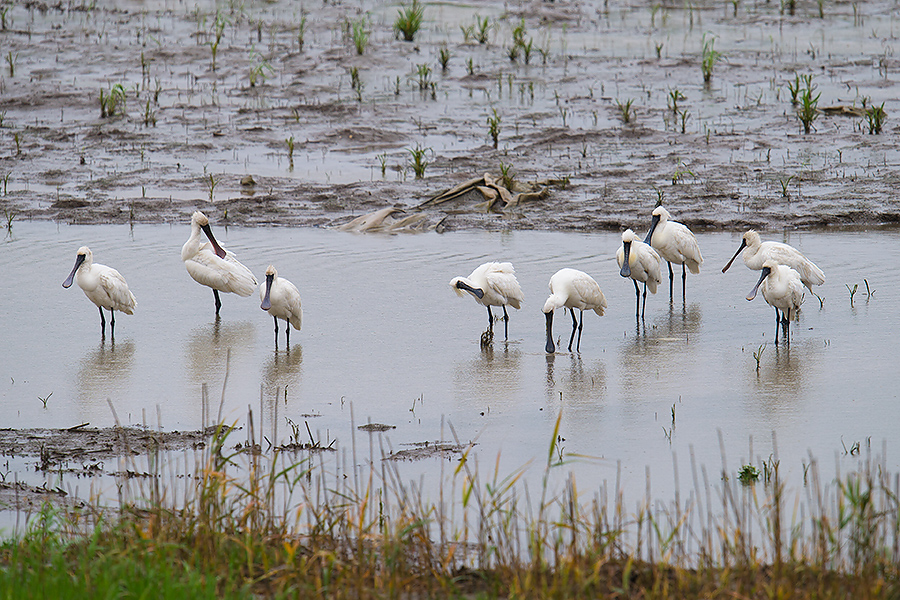
The nearly constant rain made birding challenging but had its good points. While depressing our bird count, especially on Sunday (just 62 species), the rain also depressed the number of visitors, giving Nanhui its former wild feel. The lack of tourists and their vehicles on Sunday allowed 9 Black-faced Spoonbill to exploit a good pond just a stone’s throw from the usually busy sea-wall road. The spoonbills, all sub-adults in non-breeding plumage, noted our car and went back to feeding. On that same pond on Saturday, we captured in a single photograph 6 birds representing five species: 2 Black-faced Spoonbill plus Intermediate Egret, Little Egret, Great Egret, and Chinese Egret.
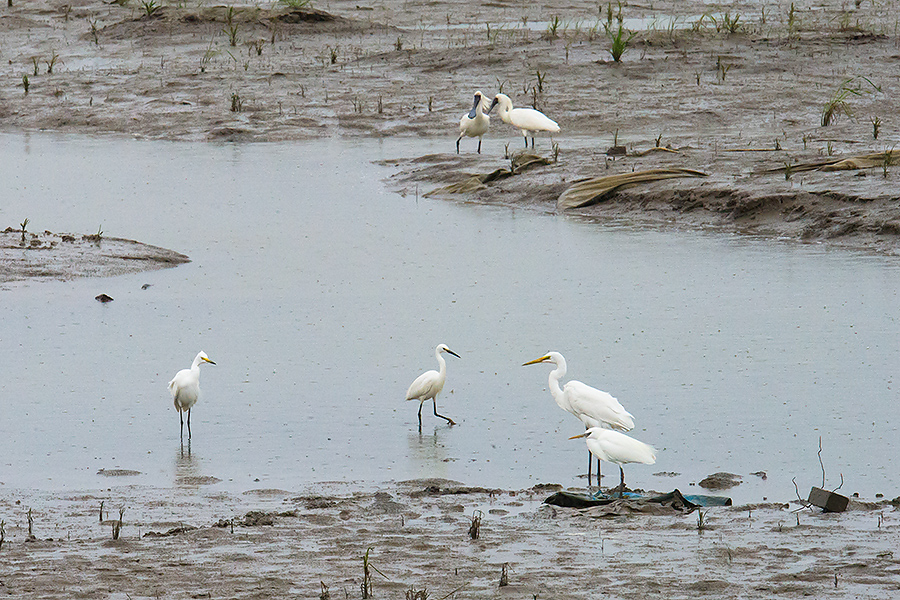
Though rainy, the weather Sunday was not windy; the lack of wind plus lack of cars made Nanhui quiet and good for sound-recording. I got a particularly good recording of Black-browed Reed Warbler and Oriental Reed Warbler. Note the more slowly delivered, more powerful song of the much larger Oriental Reed Warbler.
Black-browed Reed Warbler, Song (01:19; 3.9 MB)
Oriental Reed Warbler, Song (01:00; 3.2 MB)
I also made a recording of a bird that may be Sakhalin Leaf Warbler (00:15; 1.4 MB):
Phylloscopus borealoides was one of my hot topics over the weekend, after the excitement caused by my encounter on 5 May with a Sakhalin Leaf Warbler at Shanghai’s Zhongshan Park. The tink sound I recorded on Saturday at Nanhui was delivered faster than and at a slightly different pitch from the majority of tink calls assigned to Pale-legged Leaf Warbler and currently available on xeno-canto.org. The call more closely matches the quickly delivered, higher-pitched tink calls assigned to Sakhalin Leaf Warbler.
I got a good look at the leaf warbler I recorded. It was obviously a Pale-legged or Sakhalin, but the crown was greyer than in a normal Pale/Sak and it contrasted more with the olive-brown mantle. Mark Brazil in Birds of East Asia notes the “strong contrast between greyish-toned crown/nape, and greenish (or brownish) mantle” of Sak. However, these characters are only more likely to be found in Sak; they may also be found in Pale. Because the features of the two species overlap, only song or a DNA test is diagnostic.
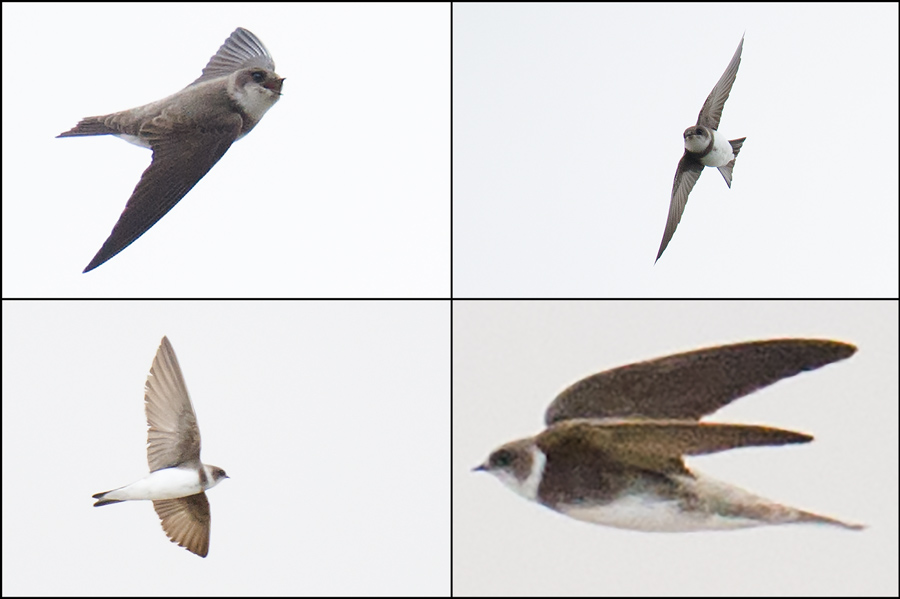
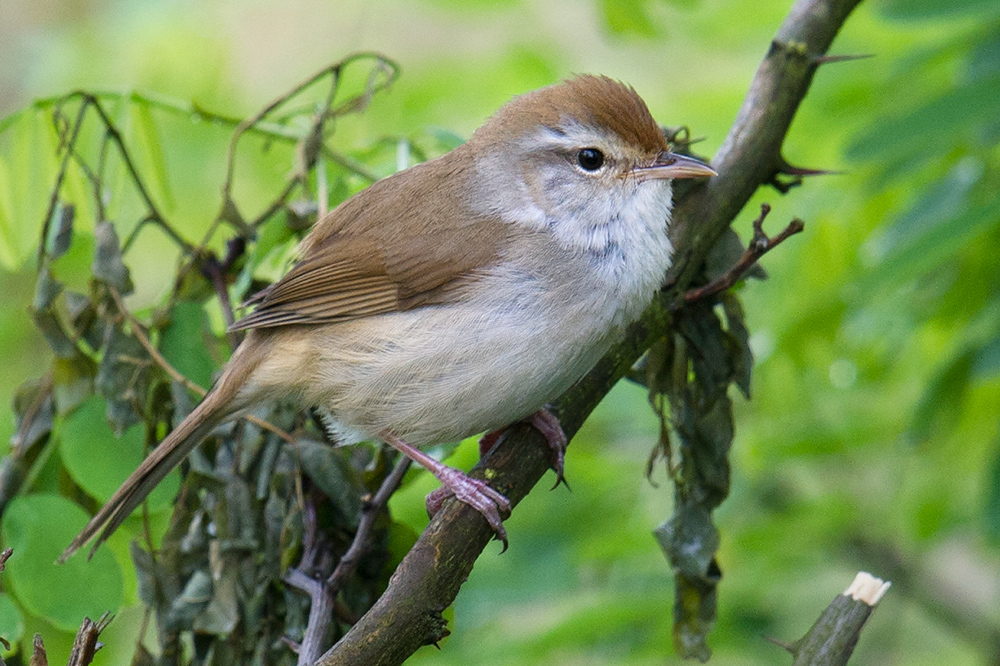
Another problem is the non-calling Cuculus cuckoos one encounters in Shanghai. On size one can often distinguish a well-viewed Lesser Cuckoo Cuculus poliocephalus, and if the eye is seen well one can distinguish the dark iris of Indian Cuckoo C. micropterus. Common Cuckoo C. canorus, Oriental Cuckoo C. optatus, and Himalayan Cuckoo C. saturatus are larger than C. poliocephalus, and unlike C. micropterus have yellow irides. C. optatus and C. saturatus are virtually indistinguishable, but this pair and C. canorus have some differences, among them the often unbarred yellow undertail coverts of C. optatus/saturatus and the thicker barring of those species on the breast and belly.
Common Cuckoo almost certainly breeds in Nanhui, and very soon we should be hearing its famous call. I have recorded neither C. optatus nor C. saturatus in the Shanghai region, I have witnessed C. micropterus in Shanghai, in the Tianmu Mountains, and at Dongtai in Jiangsu, and I have found C. poliocephalus at Dongtai.
In springtime, one encounters Cuculus adults, which if not calling are hard enough to ID; but just wait, come autumn we will be seeing the juveniles coming through. Juveniles never call, and the various Cuculus species in juvenile form resemble each other even more than Cuculus adults.
On Saturday, Elaine and I birded once again with Shanghai-based English birder Michael Grunwell. On Sunday, we birded briefly with Stephan Popp and Xueping Popp, and later Kai Pflug and his wife Jing dropped by.
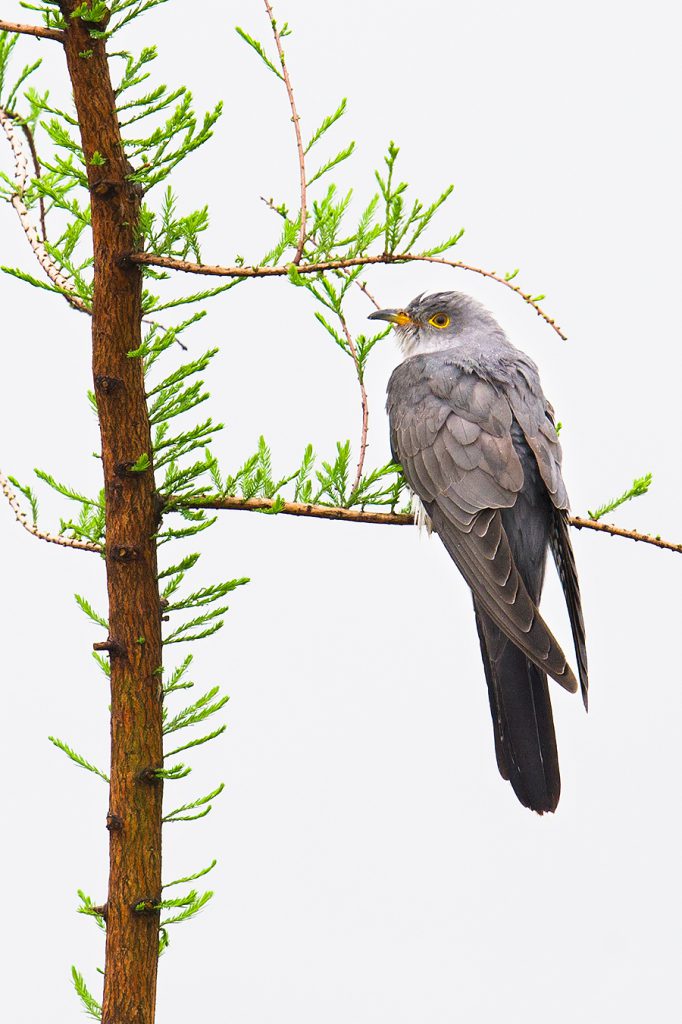
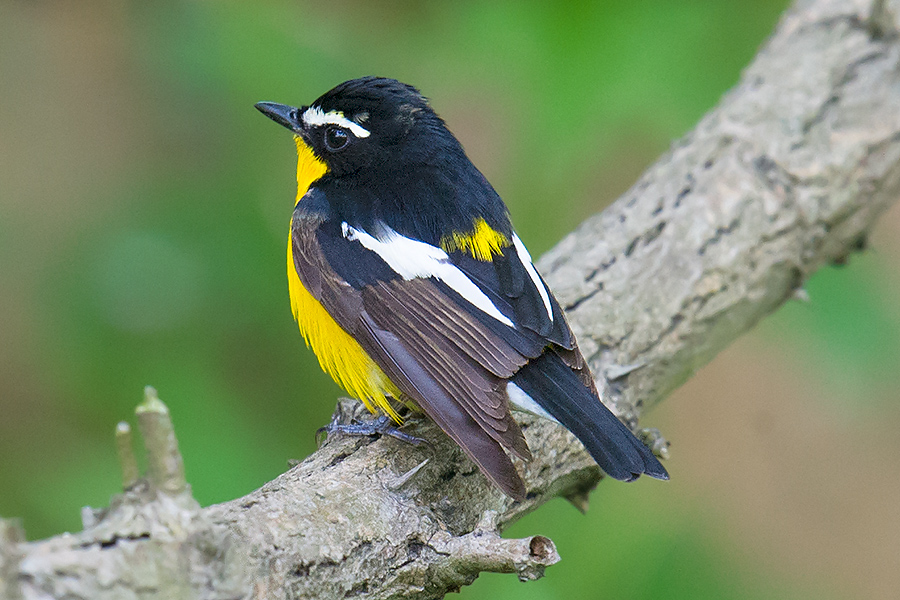
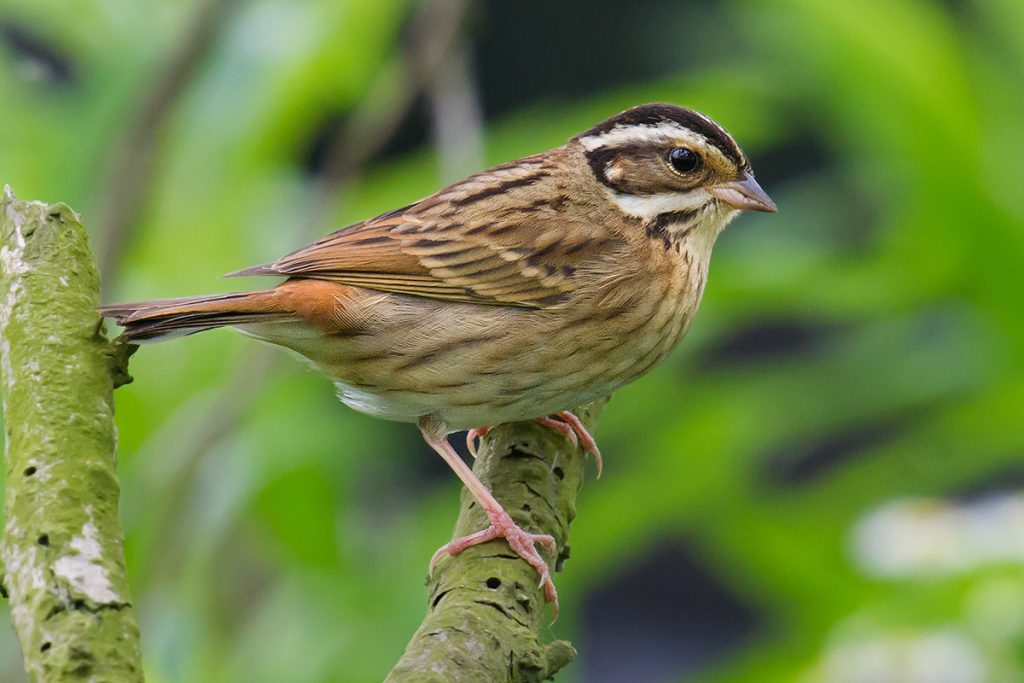
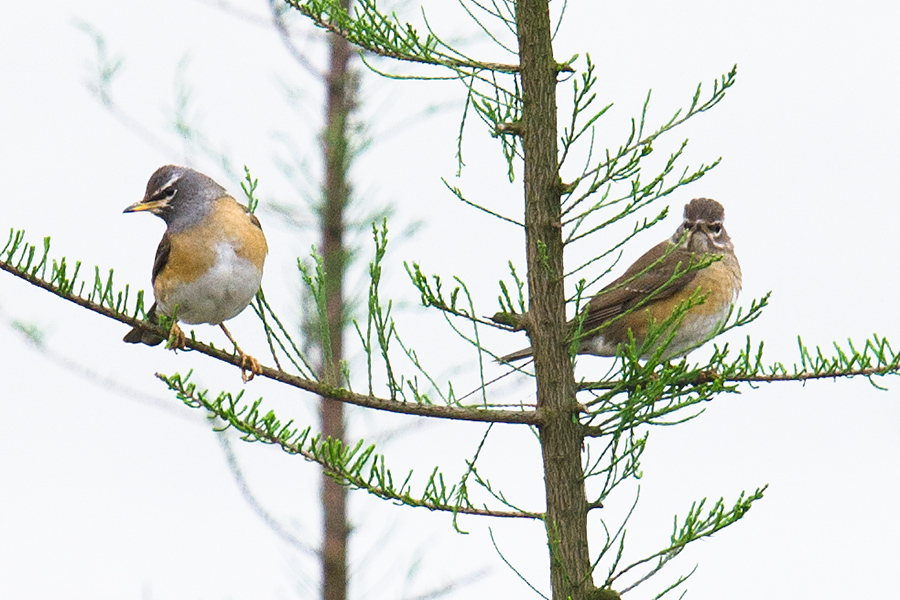
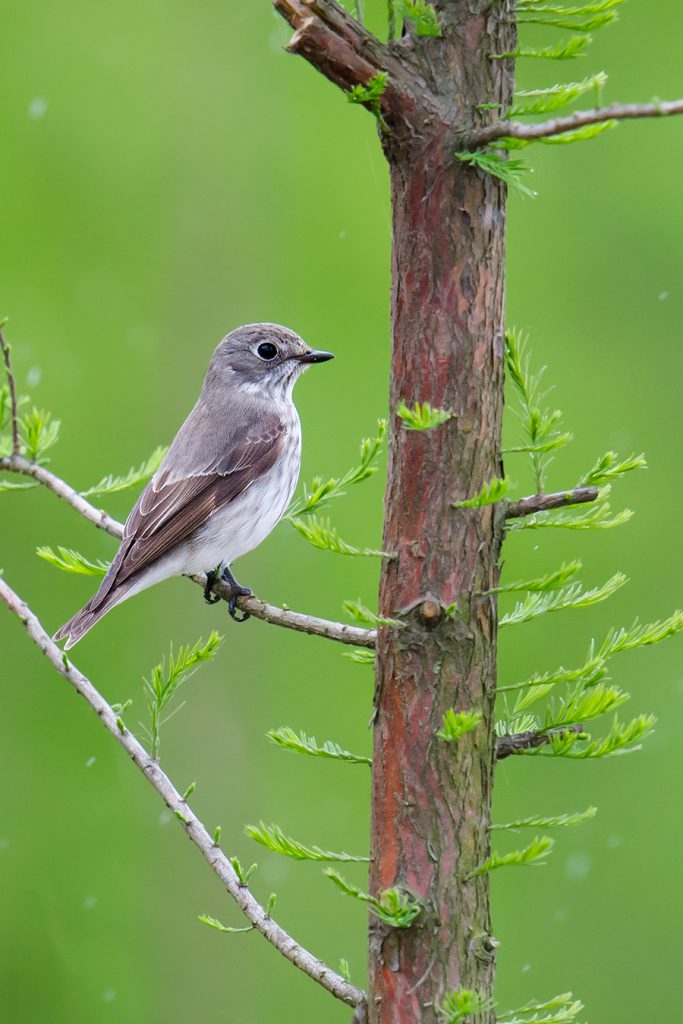
Wed. 11 May 2016 Zhongshan Park
Thurs. 12 May 2016 Zhongshan Park
Fri. 13 May 2016 Zhongshan Park
Sat. 14 May 2016 Lesser Yangshan and Nanhui
Sun. 15 May 2016 Nanhui
Tues. 17 May 2016 Nanhui
The past 10 days have seen a parade of migrants passing through Shanghai. Grey-crowned Warbler and Blue Whistling Thrush shocked birders at Nanhui. The birding site in southeast Pudong also yielded Pheasant-tailed Jacana, Pacific Golden Plover, Red Knot, Grey-tailed Tattler, Amur Paradise Flycatcher, singing Arctic Warbler, calling Two-barred Warbler, Radde’s Warbler, White-throated Rock Thrush, and still more Pechora Pipit. Tiger Shrike and Black Bulbul have been noted at Nanhui and on Lesser Yangshan, with the latter location yielding Peregrine Falcon and Rufous-tailed Robin singing from deep cover. Other interesting records were Red Turtle Dove, Black-winged Cuckooshrike, Hair-crested Drongo, Ashy Drongo, day counts as high as 21 of Black Drongo, a trio of Siberians (Siberian Thrush, Siberian Blue Robin, Siberian Rubythroat), plus Chestnut Bunting and endangered Yellow-breasted Bunting. Zhongshan Park yielded our season’s first singing Black-naped Oriole. My friend Kai Pflug was one of a group of birders who found Fujian Niltava at Nanhui, a first for Shanghai.
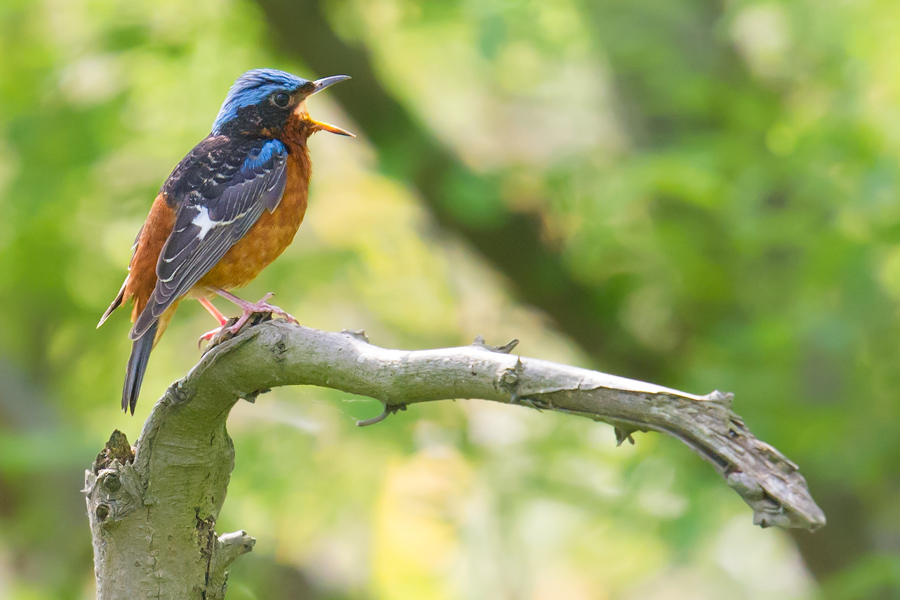
At this time of year, considering the richness of the Shanghai coast and the lack of birder coverage over the years, I go out not hoping, but expecting to get interesting records. Recently, I have rarely been disappointed.
GREY-CROWNED WARBLER, RARE IN SHANGHAI
Though I missed Kai’s niltava, the German birder brought me good luck in another way. On a spectacular Tues. morning 17 May at Nanhui, exploring the lush microforests, he and I found Grey-crowned Warbler Seicercus tephrocephalus.
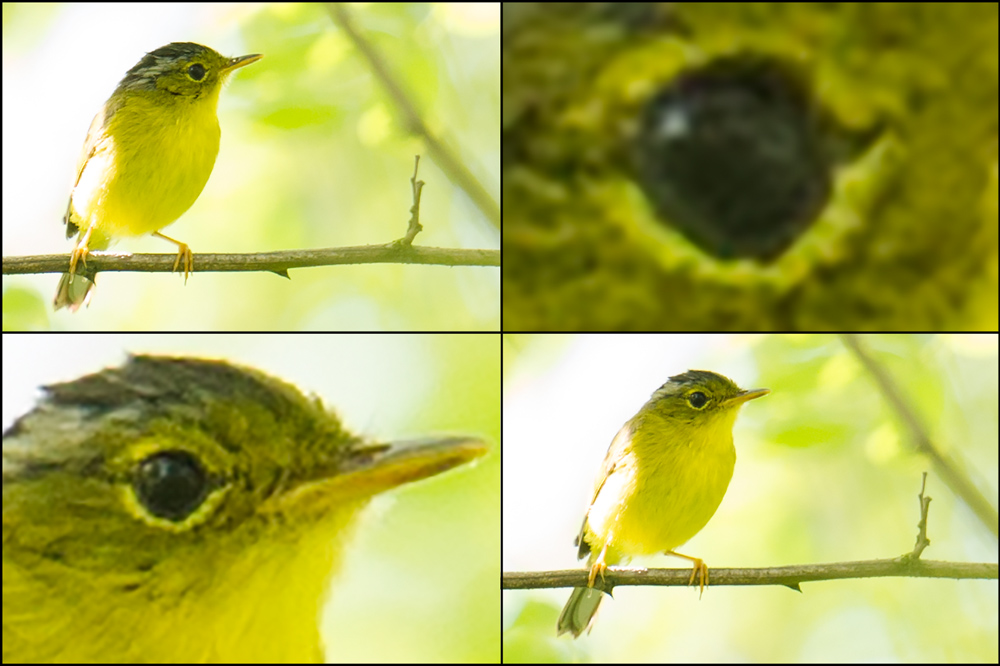
The bird was singing, an amazing incongruity, the bright, sharp south-Chinese Seicercus sound here in a tiny wood on the muddy Chinese coast. The golden warbler alighted on a branch for several seconds. I got photos and a sound recording. Grey-crowned Warbler is rarely seen this far east and is not covered in Mark Brazil’s Birds of East Asia. However the very good Handbook of the Birds of the World Vol. 11, which I can’t recommend enough to lovers of leaf warblers and golden spectacled warblers, has the info we need.
A monotypic species, S. tephrocephalus is said by HBW 11 to breed closest to us in Hubei. It is very simliar in plumage and song to Martens’s Warbler S. omeiensis but unlike Martens’s has eye-ring broken at rear. S. tephrocephalus is common to abundant in its normal range of south China and Southeast Asia, but it has rarely if ever been recorded in Shanghai. The lack of records is owing not only to its scarcity but also to its difficulty in identification, particularly for birders unfamiliar with HBW 11.
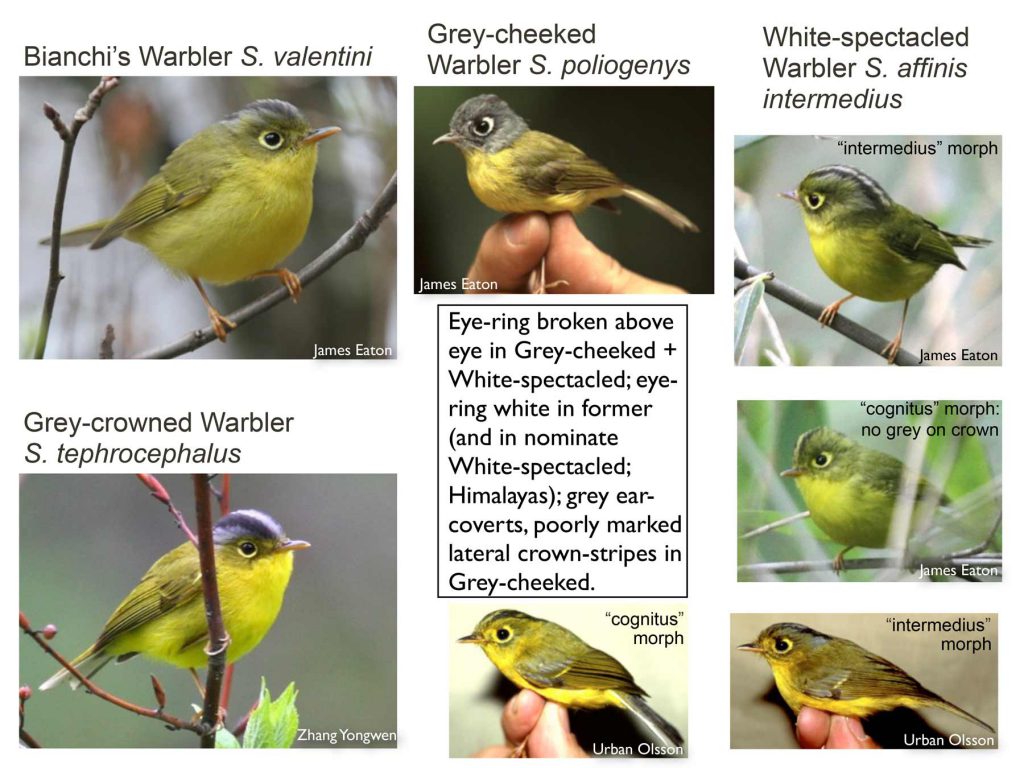
Much of the wealth of info on Seicercus warblers in HBW 11 is the fruit of the research of Swedish ornithologist Per Alström, who wrote nearly all the Seicercus entries. Guangdong-based French birder Jonathan Martinez has also researched S. tephrocephalus and helped me with the ID of the Grey-crowned Warbler. Both are members of the Shanghai Birding WeChat group and are readers of shanghaibirding.com. Thanks to both of you for your contributions.
Here are the sound-recordings I made of Grey-crowned Warbler. The recordings and photos are of the same individual.
Grey-crowned Warbler 1/2, Nanhui, Shanghai, 17 May 2016 (00:11; 1.2 MB)
Grey-crowned Warbler 2/2, Nanhui, Shanghai, 17 May 2016 (00:23; 1.7 MB)
After viewing the photos and listening to the recordings, Per wrote the following to the Shanghai Birding chat group:
“Hi Craig. … I agree with your id of Grey-crowned Warbler, mainly based on the song recording (songs and calls are by far the best ways to id Seicercus warblers). The photos look a bit off (e.g., eye-ring broken in front, which isn’t normally the case in any Seicercus, seemingly poorly marked lateral crown-stripes, no clear grey on crown [though that could be a photo effect], and dark-tipped lower mandible [only in Grey-cheeked W]). Simple id tips, paintings and a few photos can be found on my research web page. In a PDF on leaf warblers from a talk for Beijing Birdwatching Society, there are also sound recordings of … Seicercus warblers on the same page.” (That very useful PDF is now available for download through shanghaibirding.com [13 MB]: Phylloscopidae-Beijing-Birdwatching-Society-nov-2012 English)
To sum up:
My research indicates, and Per Alström concurs: Grey-crowned Warbler (Seicercus tephrocephalus)
Grey-crowned has eye-ring broken at rear; my photos show eye-ring broken at rear. The songs I recorded most closely match the song of S. tephrocephalus.
Next-closest possibility: Martens’s Warbler (S. omeiensis)
Very similar to Grey-crowned Warbler but doesn’t have eye-ring broken at rear.
Also: Alström’s Warbler (S. soror); my recording has trills; distinctive song of Alström’s lacks trills. Bianchi’s Warbler (S. valentini) does not trill. White-spectacled Warbler (S. affinis intermedius) has eye-ring broken above eye, not behind.
BLUE WHISTLING THRUSH, ANOTHER RARITY IN SHANGHAI
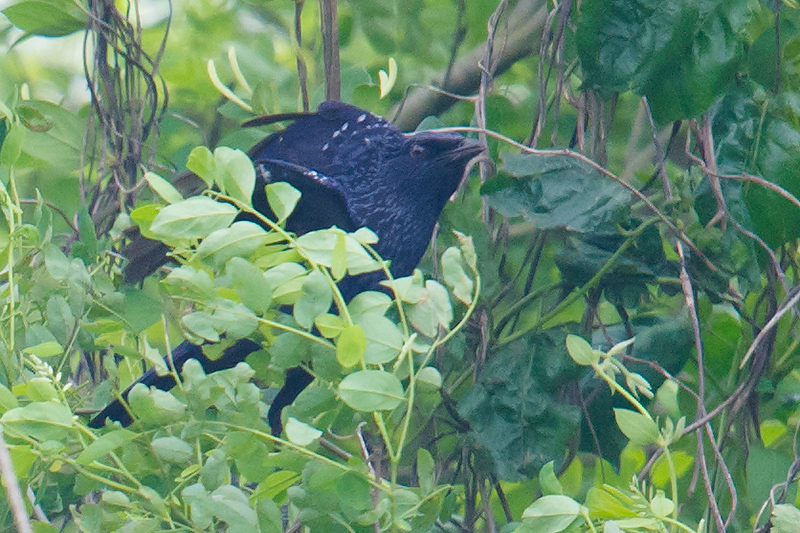
A coastal record of Blue Whistling Thrush is rare; the species had not been recorded in Shanghai since 1987. The places closest to Shanghai where I’ve seen the species are Tianmu Mountains in Zhejiang and in Nanjing Zhongshan Botanical Garden. When on Sun. 15 May we first saw the glossy blue-black bird, my partners Jan-Erik Nilsén and Elaine Du and I were flummoxed. We lingered around microforests 3-8 at Nanhui, waiting to get another look. We finally got a second look and realized it was whistler.
Birders tend to think of Blue Whistling Thrush as the ultimate resident, a fixture along fast-flowing mountain streams. The bird is however at least partly migratory, as our record and observations of other birders prove. In a text message to the Shanghai Birding WeChat group, Jonathan Martinez wrote: “BWT are migrants; I used to have them annually in northern Hunan at a site not suitable for breeding.”
CUCKOOS ARE CALLING IN SHANGHAI!
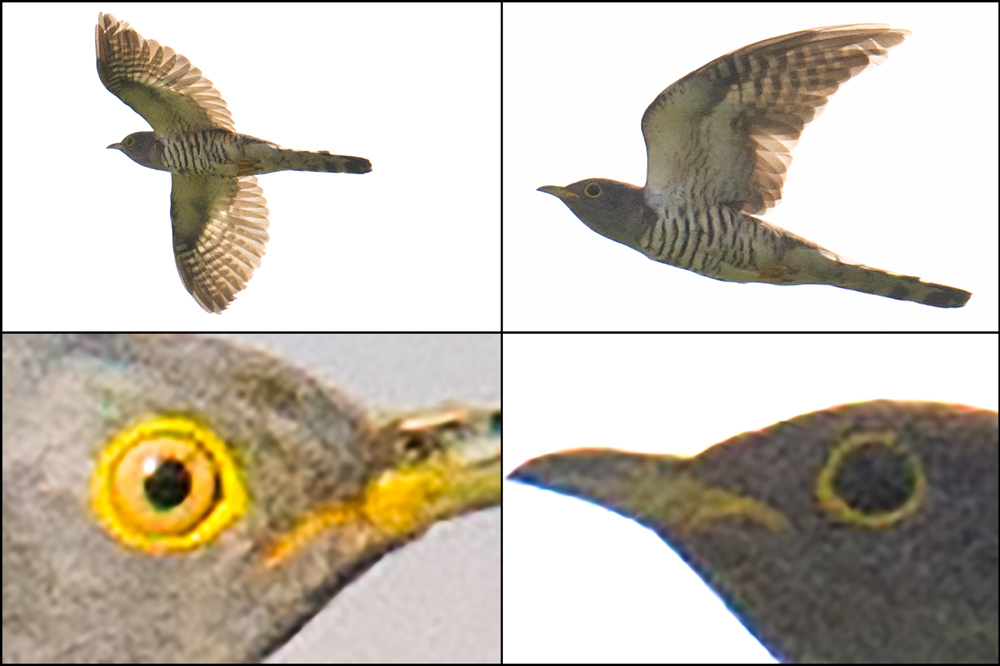
One of the many reasons I love spring is that during this time cuckoos call and are easier to identify. On Tues. 17 May at Nanhui Kai Pflug and I had two calling cuckoos: Common and Indian. I got photos of both. Can you see differences in the appearance of Common and Indian? One is eye color. See four-panel photo for comparison. The other is the thickness of the barring on the underparts. Indian also is smaller than Common, but the size difference is harder to see.
Here is one of the best-known bird calls in the world, that of Common Cuckoo, recorded by me at Nanhui on 17 May (00:31; 2 MB):
OTHER NOTES
— More Nanhui notes from Tues. 17 May: 0 ducks, 0 raptors, and Dishui Lake contained a grand total of 3 birds, all Great Crested Grebe. Also, on a weekday, even though weather superb, tourists were few; Kai Pflug and I enjoyed blessed peace and quiet. It was as quiet as a rainy Saturday or Sunday. We were lovin’ that!
— On Tues. 17 May Kai and I found bird netting at “Dowitcher Pond” (30.877779, 121.955465) in Nanhui. Area is fenced in and netting was tied to posts in deep water, so removing it will be a challenge.
— Here is a recording I made of Arctic Warbler at Nanhui.
Arctic Warbler, “half-hearted” song, Nanhui, 17 May 2016 (00:38; 2.3 MB)
— Here is the sound of Rufous-tailed Robin singing on Lesser Yangshan. The robins were singing unseen on the thickly vegetated hillside above the tunnel entrance at Xiǎoyánglíng Cove (30.642243, 122.066940).
Rufous-tailed Robin singing from thick cover, Lesser Yangshan Island, 14 May 2016 (00:08; 1.1 MB):
— Thanks to our birding partners Michael Grunwell, Jan-Erik Nilsén, and Kai Pflug.
List 1 of 1 for Wed. 11 May 2016 (10 species). Zhongshan Park (Zhōngshān Gōngyuán [中山公园]; 31.221888, 121.420066), urban green space in Shanghai, China. Sunny. Low 11° C, high 24° C. Visibility 10 km. Wind SSE 18 km/h. PM2.5 AQI: 175 (unhealthful). Sunrise 05:00, sunset 18:41. WED 11 MAY 2016 17:50-18:55. Craig Brelsford.
Spotted Dove Spilopelia chinensis 6
Japanese Tit Parus minor 1
Light-vented Bulbul Pycnonotus sinensis 25
Chinese Blackbird Turdus mandarinus 20
Oriental Magpie-Robin Copsychus saularis 1
Asian Brown Flycatcher Muscicapa latirostris 1
Yellow-rumped Flycatcher Ficedula zanthopygia 1
Mugimaki Flycatcher F. mugimaki 1
Eurasian Tree Sparrow Passer montanus 30
Chinese Grosbeak Eophona migratoria 5
List 1 of 1 for Thurs. 12 May 2016 (9 species). Zhongshan Park (Zhōngshān Gōngyuán [中山公园]; 31.221888, 121.420066), urban green space in Shanghai, China. Cloudy. Low 16° C, high 24° C. Visibility 3 km. Wind SSE 15 km/h. PM2.5 AQI: 165 (unhealthful). Sunrise 04:59, sunset 18:42. THU 12 MAY 2016 17:50-18:55. Craig Brelsford.
Feral Pigeon (Rock Dove) Columba livia 15
Spotted Dove Spilopelia chinensis 8
Japanese Tit Parus minor 2
Light-vented Bulbul Pycnonotus sinensis 25
Barn Swallow Hirundo rustica 4
Chinese Blackbird Turdus mandarinus 22
Eyebrowed Thrush T. obscurus 1
Eurasian Tree Sparrow Passer montanus 30
Chinese Grosbeak Eophona migratoria 2
List 1 of 1 for Fri. 13 May 2016 (12 species). Zhongshan Park (Zhōngshān Gōngyuán [中山公园]; 31.221888, 121.420066), urban green space in Shanghai, China. Cloudy. Low 17° C, high 20° C. Visibility 5 km. Wind ENE 23 km/h. PM2.5 AQI: 165 (unhealthful). Sunrise 04:59, sunset 18:42. FRI 13 MAY 2016 05:40-06:35. Craig Brelsford & Jan-Erik Nilsén.
Feral Pigeon (Rock Dove) Columba livia 16
Spotted Dove Spilopelia chinensis 7
Long-tailed Shrike Lanius schach 1
Black-naped Oriole Oriolus chinensis 1 singing
Japanese Tit Parus minor 1
Light-vented Bulbul Pycnonotus sinensis 25
Arctic/Kamchatka Leaf/Japanese Leaf Warbler Phylloscopus borealis/examinandus/xanthodryas 1
Chinese Blackbird Turdus mandarinus 15
Turdus sp. 1 making tseep call high in trees
Oriental Magpie-Robin Copsychus saularis 1
Eurasian Tree Sparrow Passer montanus 30
Chinese Grosbeak Eophona migratoria 3
List 1 of 2 for Sat. 14 May 2016 (47 species). Birds noted on Lesser Yangshan Island (Xiǎo Yángshān [小洋山]), island in Hangzhou Bay, Zhejiang, China. List includes birds noted at Garbage Dump Gully (30.641565, 122.062836) & Temple Mount (30.639866, 122.048327). Cloudy. Low 19° C, high 24° C. Wind SSE 18 km/h. Visibility 10 km. PM2.5 AQI: 107 (unhealthful). Sunrise 04:58, sunset 18:43. SAT 14 MAY 2016 05:20-09:30. Craig Brelsford, Elaine Du, Michael Grunwell, & Jan-Erik Nilsén.
Chinese Pond Heron Ardeola bacchus 1
Eastern Cattle Egret Bubulcus coromandus 6
Great Egret Ardea alba 1
Common Sandpiper Actitis hypoleucos 2
Feral Pigeon (Rock Dove) Columba livia 2
Spotted Dove Spilopelia chinensis 1
Cuculus sp. 1
Northern Boobook Ninox japonica 1
Peregrine Falcon Falco peregrinus 1
Ashy Minivet Pericrocotus divaricatus 2
Tiger Shrike Lanius tigrinus 1
Brown Shrike Lanius cristatus 3
Eurasian Magpie Pica pica 2
Large-billed Crow Corvus macrorhynchos 4
Japanese Tit Parus minor 2
Light-vented Bulbul Pycnonotus sinensis 20
Black Bulbul Hypsipetes leucocephalus 4
Barn Swallow Hirundo rustica 50
Japanese/Manchurian Bush Warbler Horornis diphone canturians/H. borealis borealis 15 singing
Brown-flanked Bush Warbler Horornis fortipes 1
Dusky Warbler Phylloscopus fuscatus 4
Yellow-browed Warbler P. inornatus 2
Arctic Warbler P. borealis 1 calling
Eastern Crowned Warbler P. coronatus 2
Oriental Reed Warbler Acrocephalus orientalis 10
Black-browed Reed Warbler A. bistrigiceps 1
Zitting Cisticola Cisticola juncidis 1
Plain Prinia Prinia inornata 1
White-cheeked Starling Spodiopsar cineraceus 12
Eyebrowed Thrush Turdus obscurus 2
Pale Thrush T. pallidus 1
Grey-streaked Flycatcher Muscicapa griseisticta 2
Asian Brown Flycatcher M. latirostris 6
Rufous-tailed Robin Larvivora sibilans 2 singing
Yellow-rumped Flycatcher Ficedula zanthopygia 1
Mugimaki Flycatcher F. mugimaki 1
Taiga Flycatcher F. albicilla 1
Blue Rock Thrush Monticola solitarius philippensis 6
Eurasian Tree Sparrow Passer montanus 10
Grey Wagtail Motacilla cinerea 1
White Wagtail M. alba 1
Richard’s Pipit Anthus richardi 2
Olive-backed Pipit A. hodgsoni 8
Meadow Bunting Emberiza cioides 6
Tristram’s Bunting E. tristrami 4
Yellow-breasted Bunting E. aureola 1
Chestnut Bunting E. rutila 2
List 2 of 2 for Sat. 14 May 2016 (68 species)
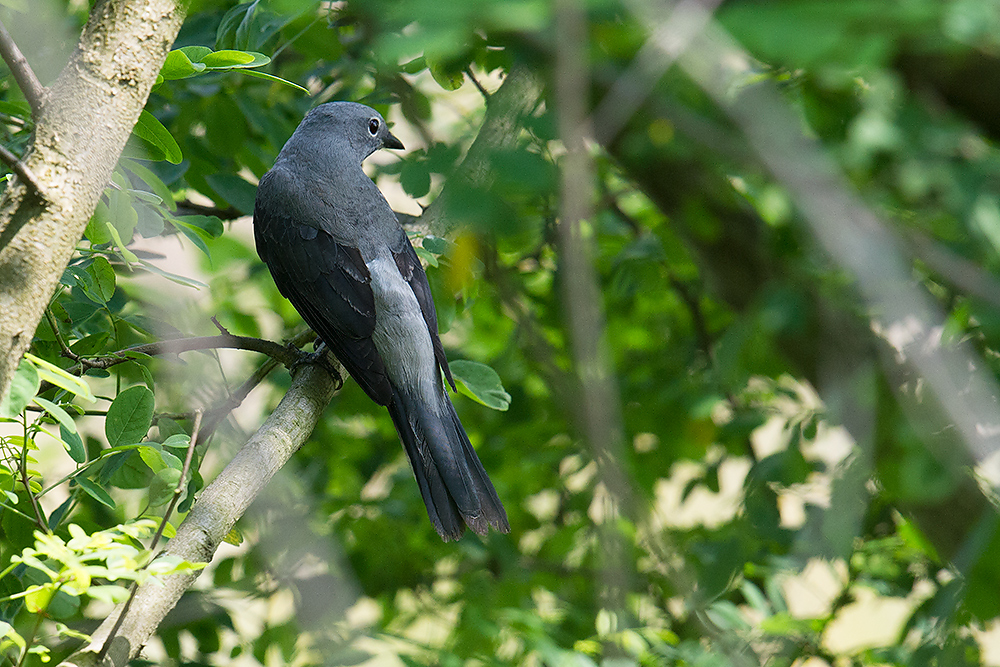
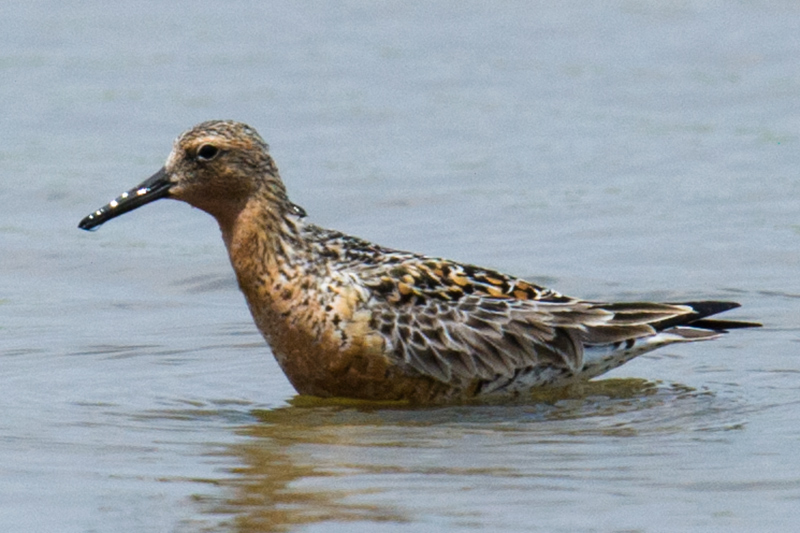
List 1 of 1 for Tues. 17 May 2016 (74 species)
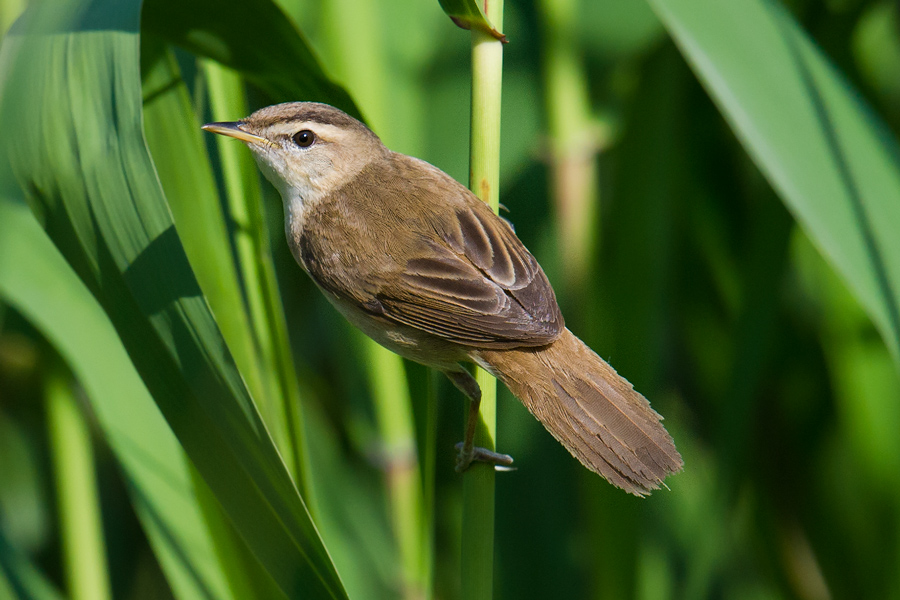
Birds noted around Pudong Nanhui Dongtan Wetland (Pǔdōng Nánhuì Dōngtān Shīdì [浦东南汇东滩湿地]), Shanghai, China (30.920507, 121.973159). List includes birds found along Shijitang Road between 31.000204, 121.938145 & 30.851114, 121.848527, in particular South Lock (30.857798, 121.914106) & South Lawn (midpoint of grassy area at 30.849840, 121.897953). Cloudy. Low 13° C, high 24° C. Wind SSE 6 km/h. Visibility 10 km. PM2.5 AQI: 109 (unhealthful). Sunrise 04:56, sunset 18:45. TUE 17 MAY 2016 05:05-17:35. Craig Brelsford & Kai Pflug.
Common Pheasant Phasianus colchicus 4
Little Grebe Tachybaptus ruficollis 3
Great Crested Grebe Podiceps cristatus 3
Black-crowned Night Heron Nycticorax nycticorax 20
Chinese Pond Heron Ardeola bacchus 16
Eastern Cattle Egret Bubulcus coromandus 6
Grey Heron Ardea cinerea 4
Great Egret A. alba 1
Intermediate Egret A. intermedia 8
Little Egret Egretta garzetta 29
Common Moorhen Gallinula chloropus 2
Black-winged Stilt Himantopus himantopus 1
Little Ringed Plover Charadrius dubius 4
Kentish Plover C. alexandrinus 6
Pheasant-tailed Jacana Hydrophasianus chirurgus 4
Gallinago sp. 1
Whimbrel Numenius phaeopus 1
Common Greenshank Tringa nebularia 15
Common Sandpiper Actitis hypoleucos 3
Red-necked Stint Calidris ruficollis 4
Oriental Turtle Dove Streptopelia orientalis 2
Red Turtle Dove S. tranquebarica 1
Spotted Dove Spilopelia chinensis 8
Indian Cuckoo Cuculus micropterus 1 calling
Common Cuckoo C. canorus 7 calling
Cuculus sp. 2
Black-winged Cuckooshrike Coracina melaschistos 1
Swinhoe’s Minivet Pericrocotus cantonensis 4
Tiger Shrike Lanius tigrinus 1
Brown Shrike L. cristatus 4
Long-tailed Shrike L. schach 6
Black-naped Oriole Oriolus chinensis 3
Black Drongo Dicrurus macrocercus 21
Hair-crested Drongo D. hottentottus 3
Amur Paradise Flycatcher Terpsiphone incei 1
Oriental Skylark Alauda gulgula 15
Light-vented Bulbul Pycnonotus sinensis 40
Black Bulbul Hypsipetes leucocephalus 1
Barn Swallow Hirundo rustica ca. 200
Red-rumped Swallow Cecropis daurica 1
Japanese/Manchurian Bush Warbler Horornis diphone canturians/H. borealis borealis 2 singing
Dusky Warbler Phylloscopus fuscatus 1
Yellow-browed Warbler P. inornatus 9
Arctic Warbler P. borealis 3 singing
Arctic/Kamchatka Leaf/Japanese Leaf Warbler P. borealis/examinandus/xanthodryas 3
Two-barred Warbler P. plumbeitarsus 1
Pale-legged/Sakhalin Leaf Warbler P. tenellipes/borealoides 3
Eastern Crowned Warbler P. coronatus 1
Grey-crowned Warbler Seicercus tephrocephalus 1 singing
Seicercus sp. 1
Oriental Reed Warbler Acrocephalus orientalis ca. 75
Black-browed Reed Warbler A. bistrigiceps 7
Zitting Cisticola Cisticola juncidis 3
Plain Prinia Prinia inornata 1
Vinous-throated Parrotbill Sinosuthora webbiana 15
Reed Parrotbill Paradoxornis heudei 3
Japanese White-eye Zosterops japonicus 2
Crested Myna Acridotheres cristatellus 15
Red-billed Starling Spodiopsar sericeus 4
White-cheeked Starling S. cineraceus 5
Siberian Thrush Geokichla sibirica 1
Grey-streaked Flycatcher Muscicapa griseisticta 6
Dark-sided Flycatcher M. sibirica 1
Asian Brown Flycatcher M. latirostris 9
Blue-and-white Flycatcher Cyanoptila cyanomelana 1
Siberian Blue Robin Larvivora cyane 1
Siberian Rubythroat Calliope calliope 2
Mugimaki Flycatcher Ficedula mugimaki 2
Daurian Redstart Phoenicurus auroreus 1
White-throated Rock Thrush Monticola gularis 2
Eurasian Tree Sparrow Passer montanus ca. 50
Grey Wagtail Motacilla cinerea 2
White Wagtail M. alba 2 leucopsis
Pechora Pipit Anthus gustavi 4
Chinese Grosbeak Eophona migratoria 4
Tristram’s Bunting Emberiza tristrami 5
Chestnut Bunting E. rutila 2
Mammals
Siberian Weasel Mustela sibirica 1
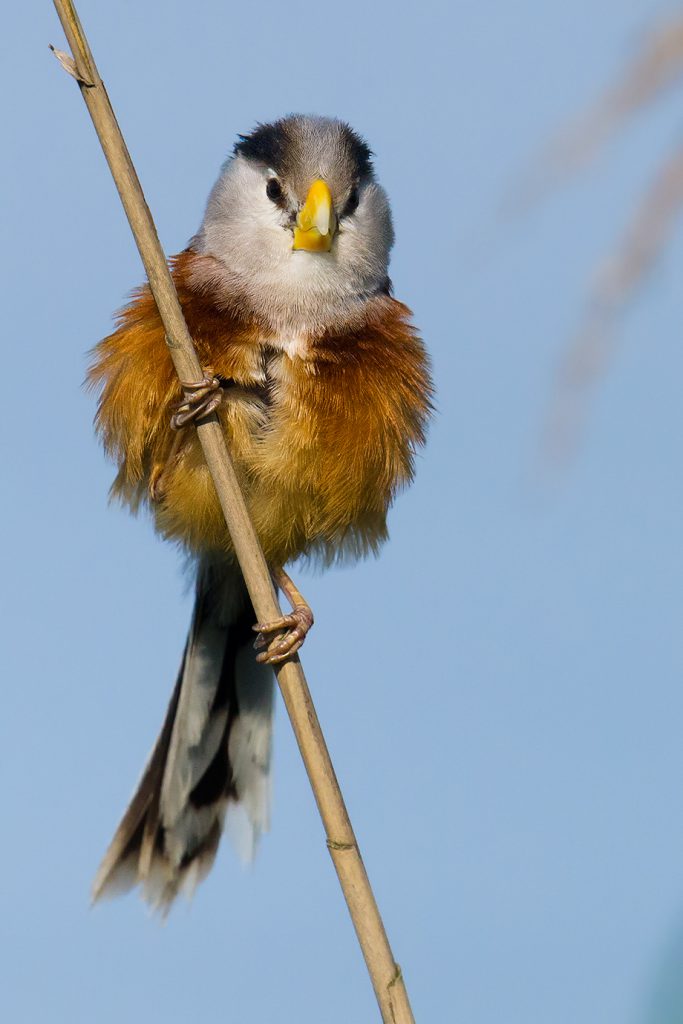
Sat. 21 May 2016
Dongtai and Yangkou
Yangkou-Dongtai today, Elaine and I with Ian Davies from eBird/Cornell and his buddies Nick Bonomo and Luke Seitz. Rain non-stop all day, extremely difficult conditions, missed Nordmann’s Greenshank and Spoon-billed Sandpiper but covered most other major waders, among them Great Knot, Red Knot, Broad-billed Sandpiper, Grey-tailed Tattler, and Eurasian Oystercatcher. We had a fun encounter with Grey Nightjar roosting on road in forested part of Dongtai Surf ’n’ Turf birding loop. Lifers were piling up for our three young American partners, all on their first trip to China.
Yangkou is still good for waders but continues to lose its appeal. Haiyin Temple Forest has been turned into a menagerie, with the obligatory captive Black Swan as well as Blue Eared Pheasant and—get this—a pair of ostrich! The trees remain but the undergrowth has been pared back, limiting the attraction of the migrant trap to thrushes, robins, and bush warblers. Entrance to the menagerie requires payment, but we got around it by saying we were birders. Entrance to the entire temple-seawall area requires ticket costing 60 yuan per person. The entire sea wall around Yangkou is now fenced off and access to mudflats is in some places denied, notably at the well-known point ca. 10 km south of town where we have seen Spoon-billed Sandpiper so many times. Dongtai meanwhile continues its own transformation, particularly in the southern parts of the reclaimed area.
List 1 of 2 for Sat. 21 May 2016 (76 species). Birds noted around Yangkou (Yángkǒu [洋口]), fishing town in Rudong County (Rúdōng Xiàn [如东县]), Jiangsu, China (32.537730, 121.017746). Nick Bonomo, Craig Brelsford, Ian Davies, Elaine Du, & Luke Seitz.
Mallard Anas platyrhynchos 2
Common Pheasant Phasianus colchicus 4
Little Grebe Tachybaptus ruficollis 7
Grey Heron Ardea cinerea 2
Purple Heron A. purpurea 1
Great Egret A. alba 3
Little Egret Egretta garzetta 38
Eastern Cattle Egret Bubulcus coromandus 30
Chinese Pond Heron Ardeola bacchus 5
Common Moorhen Gallinula chloropus 16
Eurasian Coot Fulica atra 1
Black-winged Stilt Himantopus himantopus 9
Pied Avocet Recurvirostra avosetta 2
Eurasian Oystercatcher Haematopus ostralegus 2
Grey Plover Pluvialis squatarola 1265
Grey-headed Lapwing Vanellus cinereus 3
Lesser Sand Plover Charadrius mongolus 58
Lesser/Greater Sand Plover C. mongolus/leschenaultii ca. 600
Kentish Plover C. alexandrinus 32
Terek Sandpiper Xenus cinereus 292
Common Sandpiper Actitis hypoleucos 6
Grey-tailed Tattler Tringa brevipes 68
Spotted Redshank T. erythropus 4
Common Redshank T. totanus 13
Common Greenshank T. nebularia 7
Marsh Sandpiper T. stagnatilis 4
Wood Sandpiper T. glareola 1
Whimbrel Numenius phaeopus 4
Far Eastern Curlew N. madagascariensis 10
Eurasian Curlew N. arquata 10
Black-tailed Godwit Limosa limosa 1
Bar-tailed Godwit L. lapponica 1045
Ruddy Turnstone Arenaria interpres 139
Broad-billed Sandpiper Limicola falcinellus 2
Great Knot Calidris tenuirostris 2
Sharp-tailed Sandpiper C. acuminata 38
Curlew Sandpiper C. ferruginea 1
Red-necked Stint C. ruficollis 3388
Dunlin C. alpina 294
Saunders’s Gull Chroicocephalus saundersi 26
Black-tailed Gull Larus crassirostris 1
Little Tern Sternula albifrons 3
White-winged Tern Chlidonias leucopterus 1
Whiskered Tern C. hybrida 1
Common Tern Sterna hirundo 43
Oriental Turtle Dove Streptopelia orientalis 5
Spotted Dove Spilopelia chinensis 2
Common Cuckoo Cuculus canorus 3
Eurasian Hoopoe Upupa epops 1
Common Kingfisher Alcedo atthis 1
Brown Shrike Lanius cristatus 1
Long-tailed Shrike L. schach 2
Black Drongo Dicrurus macrocercus 2
Eurasian Magpie Pica pica 3
Oriental Skylark Alauda gulgula 2
Barn Swallow Hirundo rustica 21
Japanese Tit Parus minor 1
Light-vented Bulbul Pycnonotus sinensis 11
Japanese/Manchurian Bush Warbler Horornis diphone canturians/H. borealis borealis 2
Brown-flanked Bush Warbler H. fortipes 1
Arctic Warbler Phylloscopus borealis 2
Eastern Crowned Warbler P. coronatus 1
Black-browed Reed Warbler Acrocephalus bistrigiceps 1
Oriental Reed Warbler A. orientalis 14
Zitting Cisticola Cisticola juncidis 1
Plain Prinia Prinia inornata 2
Reed Parrotbill Paradoxornis heudei 1
Vinous-throated Parrotbill Sinosuthora webbiana 5
Red-billed Starling Spodiopsar sericeus 11
White-cheeked Starling S. cineraceus 8
Dark-sided Flycatcher Muscicapa sibirica 4
Grey-streaked Flycatcher M. griseisticta 2
Asian Brown Flycatcher M. latirostris 1
White Wagtail Motacilla alba 2
Eurasian Tree Sparrow Passer montanus 39
Meadow Bunting Emberiza cioides 1
Yellow-breasted Bunting E. aureola 1
List 2 of 2 for Sat. 21 May 2016 (28 species). Birds noted around Great Dongtai Surf ’n’ Turf Birding Trail, a 40-km loop on coast of Dongtai (Dōngtái [东台]), a county-level city in Jiangsu, China. Important points on Trail are N entrance to new sea-wall road on Dongtai Levee Road (Dōngtái Hǎidī [东台海堤], 32.868218, 120.912340), T-junction on Dongtai Levee Road (32.855576, 120.896557), SE corner of sea wall (32.759499, 120.962893), & NE corner of sea wall (32.872444, 120.951522). Nick Bonomo, Craig Brelsford, Ian Davies, Elaine Du, & Luke Seitz.
Little Grebe Tachybaptus ruficollis 1
Grey Heron Ardea cinerea 2
Little Egret Egretta garzetta 7
Eurasian Oystercatcher Haematopus ostralegus 4
Grey Plover Pluvialis squatarola 42
Lesser Sand Plover Charadrius mongolus 40
Kentish Plover C. alexandrinus 4
Terek Sandpiper Xenus cinereus 26
Grey-tailed Tattler Tringa brevipes 6
Common Greenshank T. nebularia 2
Common Redshank T. totanus 1
Whimbrel Numenius phaeopus 1
Far Eastern Curlew N. madagascariensis 3
Eurasian Curlew N. arquata 97
Bar-tailed Godwit Limosa lapponica 62
Ruddy Turnstone Arenaria interpres 6
Broad-billed Sandpiper Limicola falcinellus 3
Great Knot Calidris tenuirostris 8
Red Knot C. canutus 17
Sharp-tailed Sandpiper C. acuminata 16
Red-necked Stint C. ruficollis 217
Dunlin C. alpina 8
shorebird sp. 100 on horizon
Saunders’s Gull Chroicocephalus saundersi 35
Little Tern Sterna hirundo 8
Common Cuckoo Cuculus canorus 1
Grey Nightjar Caprimulgus jotaka 1
White-cheeked Starling Spodiopsar cineraceus 1
Eurasian Tree Sparrow Passer montanus 2
Sun. 22 May 2016
Yangkou
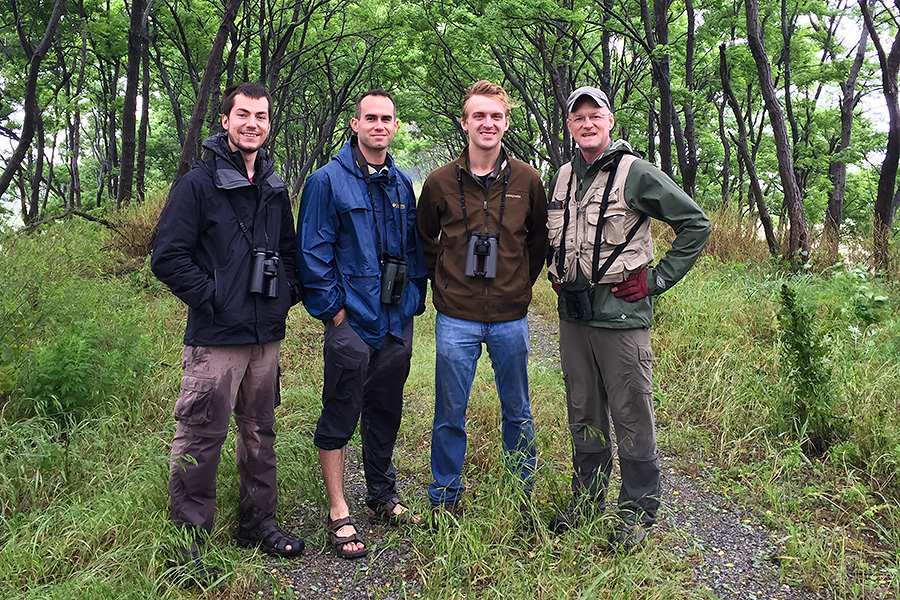
Yangkou again today with Elaine and American birders Ian Davies, Nick Bonomo, and Luke Seitz. Spoon-billed Sandpiper photographed in flight by Ian after our 4-man group split up on mudflats to cover more ground. Despite relentless search could not find it again. While searching we saw thousands of Red-necked Stint and hundreds of other waders and got soaked in the misty rain. At long-disused Magic Forest we found 33 species in 79 minutes, with Northern Boobook, Lesser Cuckoo, Tiger Shrike, Narcissus Flycatcher, and Forest Wagtail leading the way. The Magic Forest has been locked since 2013, but a guard let us use the area today. It was wonderful to bird the old place again. Our partners were wide-eyed at the richness of the Magic Forest and impressed by the mudflats. Ian trained Elaine and me on the eBird reporting system.
List 1 of 1 for Sun. 22 May 2016 (82 species). Birds noted around Yangkou (Yángkǒu [洋口]), fishing town in Rudong County (Rúdōng Xiàn [如东县]), Jiangsu, China (32.537730, 121.017746). Nick Bonomo, Craig Brelsford, Ian Davies, Elaine Du, & Luke Seitz.
Common Pheasant Phasianus colchicus 8
Little Grebe Tachybaptus ruficollis 3
Purple Heron Ardea purpurea 2
Little Egret Egretta garzetta 11
Eastern Cattle Egret Bubulcus coromandus 10
Chinese Pond Heron Ardeola bacchus 2
Black-crowned Night Heron Nycticorax nycticorax 1
Common Moorhen Gallinula chloropus 3
Black-winged Stilt Himantopus himantopus 12
Pied Avocet Recurvirostra avosetta 2
Eurasian Oystercatcher Haematopus ostralegus 6
Grey Plover Pluvialis squatarola 2210
Grey-headed Lapwing Vanellus cinereus 4
Lesser Sand Plover Charadrius mongolus 1250
Greater Sand Plover C. leschenaultii 5
Kentish Plover C. alexandrinus 43
Terek Sandpiper Xenus cinereus 408
Common Sandpiper Actitis hypoleucos 2
Grey-tailed Tattler Tringa brevipes 48
Spotted Redshank T. erythropus 2
Common Greenshank T. nebularia 7
Common Redshank T. totanus 3
Whimbrel Numenius phaeopus 5
Far Eastern Curlew N. madagascariensis 21
Eurasian Curlew N. arquata 5
Black-tailed Godwit Limosa limosa 1
Bar-tailed Godwit L. lapponica 1670
Ruddy Turnstone Arenaria interpres 188
Broad-billed Sandpiper Limicola falcinellus 14
Great Knot Calidris tenuirostris 18
Red Knot C. canutus 1
Sharp-tailed Sandpiper C. acuminata 23
Red-necked Stint C. ruficollis ca. 6400
Sanderling C. alba 1
Dunlin C. alpina 230
Spoon-billed Sandpiper C. pygmea 1 seen by Ian Davies
Oriental Pratincole Glareola maldivarum 5
Saunders’s Gull Chroicocephalus saundersi 196
Black-tailed Gull Larus crassirostris 1
Little Tern Sternula albifrons 7
Gull-billed Tern Gelochelidon nilotica 3
White-winged Tern Chlidonias leucopterus 16
Common Tern Sterna hirundo 16
Oriental Turtle Dove Streptopelia orientalis 3
Red Turtle Dove S. tranquebarica 14
Common Cuckoo Cuculus canorus 4
Lesser Cuckoo C. poliocephalus 1
Cuculus sp. 29
Northern Boobook Ninox japonica 1
Eurasian Hoopoe Upupa epops 11
Great Spotted Woodpecker Dendrocopos major 1
Tiger Shrike Lanius tigrinus 1
Brown Shrike L. cristatus 7
Black Drongo Dicrurus macrocercus 5
Azure-winged Magpie Cyanopica cyanus 5
Eurasian Magpie Pica pica 2
Oriental Skylark Alauda gulgula 12
Barn Swallow Hirundo rustica 25
Japanese Tit Parus minor 2
Light-vented Bulbul Pycnonotus sinensis 24
Japanese/Manchurian Bush Warbler Horornis diphone canturians/H. borealis borealis 5
Brown-flanked Bush Warbler H. fortipes 1
Arctic/Kamchatka Leaf/Japanese Leaf Warbler Phylloscopus borealis/examinandus/xanthodryas 3
Pale-legged/Sakhalin Leaf Warbler P. tenellipes/borealoides 3
Eastern Crowned Warbler P. coronatus 2
Black-browed Reed Warbler Acrocephalus bistrigiceps 1
Oriental Reed Warbler A. orientalis 6
Zitting Cisticola Cisticola juncidis 5
Plain Prinia Prinia inornata 4
Vinous-throated Parrotbill Sinosuthora webbiana 8
White-cheeked Starling Spodiopsar cineraceus 8
Crested Myna Acridotheres cristatellus 1
thrush sp. 2
Asian Brown Flycatcher Muscicapa latirostris 3
Dark-sided Flycatcher M. sibirica 5
Grey-streaked Flycatcher M. griseisticta 3
Mugimaki Flycatcher Ficedula mugimaki 1
Narcissus Flycatcher F. narcissina 1
Taiga Flycatcher F. albicilla 1
Forest Wagtail Dendronanthus indicus 1
Eastern Yellow Wagtail Motacilla tschutschensis 2
Chinese Grosbeak Eophona migratoria 20
Eurasian Tree Sparrow Passer montanus 20
Tristram’s Bunting Emberiza tristrami 1
Mon. 23 May 2016
Yangkou and Nanhui
Yangkou and Nanhui today, Elaine, U.S. birders Ian Davies, Nick Bonomo, and Luke Seitz, and I (Yangkou), then Elaine and I (Nanhui).
At Yangkou mostly around Magic Forest north of Haiyin Temple. Ruddy Kingfisher, Purple Heron, Lesser Cuckoo 2, Asian Koel, Lesser Coucal 3, Arctic Warbler 3 singing, Chestnut-flanked White-eye. Ruddy Kingfisher seen by Ian and Elaine (life bird for both), but missed by me. (My view in Nanhui in Oct. 2013 remains my sole sighting of Ruddy King.) Temple Wood still productive (Eyebrowed Thrush, Japanese Paradise Flycatcher).
After dropping off Ian, Nick, and Luke at Pudong Airport, Elaine and I continued on to Nanhui. Black-capped Kingfisher, Japanese Para Fly 5, Thick-billed Warbler, Dusky Warbler, Richard’s Pipit.
List 1 of 1 for Mon. 23 May 2016 (55 species). Birds noted around Yangkou (Yángkǒu [洋口]), fishing town in Rudong County (Rúdōng Xiàn [如东县]), Jiangsu, China (32.537730, 121.017746). Nick Bonomo, Craig Brelsford, Ian Davies, Elaine Du, & Luke Seitz.
Common Pheasant Phasianus colchicus 3
Little Grebe Tachybaptus ruficollis 2
Great Crested Grebe Podiceps cristatus 1
Yellow Bittern Ixobrychus sinensis 1
Grey Heron Ardea cinerea 1
Purple Heron A. purpurea 1
Little Egret Egretta garzetta 3
Eastern Cattle Egret Bubulcus coromandus 1
Black-crowned Night Heron Nycticorax nycticorax 8
Common Moorhen Gallinula chloropus 1
Eurasian Coot Fulica atra 1
Grey-headed Lapwing Vanellus cinereus 1
Oriental Turtle Dove Streptopelia orientalis 4
Spotted Dove Spilopelia chinensis 1
Indian Cuckoo Cuculus micropterus 1
Common Cuckoo C. canorus 2
Lesser Cuckoo C. poliocephalus 2
Asian Koel Eudynamys scolopaceus 1
Lesser Coucal Centropus bengalensis 3
Eurasian Hoopoe Eurasian Upupa epops 2
Ruddy Kingfisher Halcyon coromanda 1
Black-capped Kingfisher H. pileata 1
Common Kestrel Falco tinnunculus 2
Brown Shrike Lanius cristatus 1
Long-tailed Shrike L. schach 1
Black Drongo Dicrurus macrocercus 1
Japanese Paradise Flycatcher Terpsiphone atrocaudata 1
Azure-winged Magpie Cyanopica cyanus 2
Oriental Skylark Alauda gulgula 1
Barn Swallow Hirundo rustica 5
Japanese Tit Parus minor 1
Light-vented Bulbul Pycnonotus sinensis 5
Japanese/Manchurian Bush Warbler Horornis diphone canturians/H. borealis borealis 1
Dusky Warbler Phylloscopus fuscatus 1
Yellow-browed Warbler P. inornatus 1
Arctic Warbler P. borealis 2 singing
Pale-legged/Sakhalin Leaf Warbler P. tenellipes/borealoides 1
Eastern Crowned Warbler P. coronatus 1
Oriental Reed Warbler Acrocephalus orientalis 5
Plain Prinia Prinia inornata 1
Reed Parrotbill Paradoxornis heudei 2
Vinous-throated Parrotbill Sinosuthora webbiana 6
Chestnut-flanked White-eye Zosterops erythropleurus 2
Japanese White-eye Z. japonicus 1
White-cheeked Starling Spodiopsar cineraceus 1
Chinese Blackbird Turdus mandarinus 1
Eyebrowed Thrush T. obscurus 1
Dark-sided Flycatcher Muscicapa sibirica 2
Asian Brown Flycatcher M. latirostris 1
Grey-streaked Flycatcher M. griseisticta 1
Yellow-rumped Flycatcher Ficedula zanthopygia 1
Mugimaki Flycatcher F. mugimaki 2
Black-faced Bunting Emberiza spodocephala 1
Chinese Grosbeak Eophona migratoria 20
Eurasian Tree Sparrow Passer montanus 1
Tues. 24 May 2016
Nanhui
Elaine and I again covered Cape Nanhui, the coastal birding site in southeast Pudong, Shanghai. Highlights: Eurasian Bittern 1 booming, Yellow Bittern 6, Common Tern 1 minussensis, Common Cuckoo 18 + 8 Cuculus sp. that were probably all Common, Black-winged Cuckooshrike, Black Drongo 28, Japanese Paradise Flycatcher 2 (1 calling; see nearby recording), Arctic Warbler 3 singing, Arctic-type Warbler 30 (vast majority likely Arctic), Thick-billed Warbler 2 (1 singing), Narcissus Flycatcher 1 male, Richard’s Pipit.
— I had never heard Thick-billed sing. This forest Acro was hidden in the crown of one of the locust trees in Microforest 1. The sound I recorded is below. The wind was blowing, lowering the quality of the recording, but the essentials are there. Note the typical raspy Acro sound, and note the much faster delivery of Thick-billed than that of its fellow Acro Oriental Reed Warbler:
Thick-billed Warbler, Shanghai, 24 May 2016 (01:53, 5.3 MB)
— The cuckoos were in full breeding mode, chasing each other and calling constantly.
— Elaine and I spent the better part of an hour walking along the muddy bank of a canal looking for Middendorf’s Grasshopper Warbler. On 21 May 2015 at Nanhui, Kai Pflug , Elaine, and I found this species. Was that encounter a one-off, or is Middendorf’s Gropper a bird that would be recorded more in Shanghai were more birders looking for it? I still don’t have an answer to that question.
26 May to 12 June 2016
Elaine and I were in her hometown of Boli County, Heilongjiang, observing the breeding season in Northeast China. We wrote a report.
While we were in Heilongjiang, birders at Nanhui made some notable records:
Crested Goshawk (29 May)
Asian Koel (3 June)
Fairy Pitta (2-5 June)
Brown-chested Jungle Flycatcher (30 May-1 June)
Slaty Bunting (29 May)
List of Place Names
Accidental Marsh, Accidental Mudflat (30.611902, 122.114873): area on reclaimed land between Lesser Yangshan Island & Dazhitou Island. So named because a causeway linking the two islands fostered the emergence of a marshy area on the S side.
Accidental Mudflat: see Accidental Marsh, Accidental Mudflat.
Binjiang Park (Bīnjiāng Gōngyuán [滨江公园]): small urban park on Huangpu River in Pudong New Area (Pǔdōng Xīn Qū [浦东新区]), Shanghai. 31.235662, 121.497396.
Binjiang Forest Park (Bīnjiāng Sēnlín Gōngyuán [滨江森林公园]): large urban park in Pudong New Area (Pǔdōng Xīn Qū [浦东新区]), Shanghai. Occupies dramatic location where Huangpu River flows into Yangtze River. 31.383916, 121.523818.
Century Park (Shìjì Gōngyuán [世纪公园]): urban green space in Pudong, Shanghai. Size: 140 hectares. 31.219361, 121.551900.
Chongming Dongtan National Bird Sanctuary and Nature Reserve (Chóngmíng Dōngtān Niǎolèi Guójiājí Zìrán Bǎohùqū [崇明东滩鸟类国家级自然保护区]): nature reserve E Chongming Island. 31.510109, 121.961955.
Chongming Island (Chóngmíng Dǎo [崇明岛]): large alluvial island at mouth of Yangtze River. Area: 1041 sq. km. Part of Shanghai.
Dazhitou Island (Dà Zhǐtou Dǎo [大指头岛]): island E of Lesser Yangshan Island, now connected to Lesser Yangshan by causeway. See also Accidental Marsh, Accidental Mudflat.
Dongtai (Dōngtái [东台]): county-level city E Jiangsu.
Garbage Dump Coastal Plain: broad area between Donghai Bridge & Garbage Dump Gully on Lesser Yangshan Island. 30.638860, 122.060089.
Garbage Dump Gully: birding spot on Lesser Yangshan Island near Donghai Bridge, known for its tall trees. A small garbage-processing plant lies at mouth of gully. 30.641565, 122.062836.
Gongqing National Forest Park (Gòngqīng Guójiā Sēnlín Gōngyuán [共青国家森林公园]). Park Yangpu District (Yángpǔ Qū [杨浦区]), Shanghai. 31.320540, 121.546220.
Haiyin Temple (Hǎiyìn Sì [海印寺]: place of worship Yangkou, Jiangsu. 32.558756, 121.044740.
Hengsha Island (Héngshā Dǎo [横沙岛]): small alluvial island at mouth of Yangtze River. Area: 56 sq. km. Part of municipality of Shanghai. S gate to birding area at 31.297333, 121.859434.
Huangpu River (Huángpǔ Jiāng [黄浦江]): river 113 km in length, running through Shanghai. Tributary of Yangtze River.
Jiangsu (Jiāngsū Shěng [江苏省]): province E China on Yellow Sea. Area: 102,600 sq. km. Population: 79.2 million.
Lesser Yangshan Island (Xiǎo Yángshān [小洋山]): island Zhejiang Province in Hangzhou Bay (East China Sea). 30.634096, 122.058079.
Magic Parking Lot: parking area next to Holiday Inn in Nanhui, one of the few places in the area with tall trees & thus attractive to many species of bird. 30.882784, 121.972782.
Nanhui (Nánhuì [南汇]): area in Pǔdōng (浦东) in SE Shanghai, on Hangzhou Bay & East China Sea.
Pudong (Pǔdōng Xīn Qū [浦东新区]): district Shanghai E of Huangpu River extending to East China Sea.
Pudong Nanhui Dongtan Wetland (Pǔdōng Nánhuì Dōngtān Shīdì [浦东南汇东滩湿地]): former nature reserve in Nanhui, on East China Sea. 30.920507, 121.973159 (corner of Shìjìtáng Lù [世纪塘路] & main access road leading inland).
Pudong New Area: see Pudong.
Puxi (Pǔxī [浦西]): historic center of shanghai, on W bank of Huangpu River.
Sānmíncūn (三民村): village SE Jiangsu ca. 40 km S of Yangkou. Mudflats: 32.459155, 121.294937. Sānmíncūn Magic Forest: 32.438124, 121.278211.
Shanghai (Shànghǎi Shì [上海市]): provincial-level city E China, at mouth of Yangtze River on East China Sea. Area: 6341 sq. km. Population: 24.3 million.
Shanghai Botanical Garden (Shànghǎi Zhíwùyuán [上海植物园]; 31.152036, 121.445856): urban green space in Shanghai.
Shanghai Binhai Forest Park (Shànghǎi Bīnhǎi Sēnlín Gōngyuán [上海滨海森林公园]). 30.966324, 121.910289.
Suzhou Creek (Sūzhōu Hé [苏州河]): tributary of Huangpu River; flows near Zhongshan Park in Shanghai. Also known as Wusong River (Wúsōng Jiāng [吴淞江]).
Temple Mount: area on Lesser Yangshan Island, named after Guānyīn Temple (Guānyīn Chánsì [观音禅寺]). 30.639945, 122.048277.
West Tianmu Mountain Nature Reserve (Xī Tiānmùshān Zìrán Bǎohùqū [西天目山自然保护区]): protected area in Zhejiang. 30.333333, 119.416667.
Wusong River: see Suzhou Creek.
Xiǎo Yángshān (小洋山): see Lesser Yangshan Island.
Xiǎoyánglíng Cove: bay & surrounding land on Lesser Yangshan Island. Named after Xiǎoyánglíng Tǎ (小洋陵塔), a Buddhist monument. To reach cove, walk through tunnel from Garbage Dump Gully. 30.642243, 122.066940.
Yangkou (Yángkǒu [洋口]): fishing town Rudong County, Jiangsu. 32.537730, 121.017746.
Zhejiang (Zhèjiāng Shěng [浙江省]): province E China, on East China Sea. Area: 101,800 sq. km. Population: 54.9 million.
Zhongshan Park (Zhōngshān Gōngyuán [中山公园]): urban green space 6 km W of People’s Square in Changning District (Chángníng Qū [长宁区]), Shanghai. Size: 21 hectares. 31.221888, 121.420066.
Selected Bibliography
Alström, Per, Krister Mild, & Bill Zetterström. Pipits and Wagtails. Princeton University Press.
Brazil, Mark. Birds of East Asia. Princeton University Press. Craig’s first reference in the Shanghai region.
Brelsford, Craig. A Photographic Field Guide to the Birds of China. (Work in progress; notes and drafts in Craig’s laptop. Please help us create this field guide by making a donation.)
del Hoyo, Josep, et al., eds. The Handbook of the Birds of the World. Lynx Edicions.
Kennerley, Peter & David Pearson. Reed and Bush Warblers. Christopher Helm.
Lynx Edicions. The Internet Bird Collection. ibc.lynxeds.com
MacKinnon, John & Karen Phillipps. A Field Guide to the Birds of China. Oxford University Press.
Message, Stephen & Don Taylor. Waders of Europe, Asia, and North America. Christopher Helm.
Olsen, Klaus Malling & Hans Larsson. Gulls of Europe, Asia and North America. Christopher Helm.
Oriental Bird Club. Oriental Bird Images. orientalbirdimages.org.
Robson, Craig. Birds of Southeast Asia. Princeton University Press.
Smith, Andrew T. & Yan Xie, eds. Mammals of China. Princeton University Press.
Svensson, Lars. Collins Bird Guide: The Most Complete Guide to the Birds of Britain and Europe. HarperCollins.
Xeno-Canto Foundation. Xeno-Canto: Bird Sounds from Around the World. xeno-canto.org. Craig has downloaded hundreds of calls from this Web site.
Equipment
Cameras: Nikon D3S; for landscapes, Apple iPad, Apple iPhone 4S, and Apple iPhone 6
Lens: Nikon VR 600mm F/4G
Sound recorder: Olympus DM-650
Binoculars: Swarovski EL 8 x 32 (Craig), Zeiss Conquest HD 8 x 42 (Elaine)
Spotting scope: Swarovski ATX-95
Featured image: Fri. 21 May 2016. As darkness was falling, Elaine Du, Ian Davies, Nick Bonomo, Luke Seitz, and I were driving through the coastal forest in Dongtai, Jiangsu. I saw a log on the road and braked. The log was Grey Nightjar. I pulled out my camera and went to work. Nikon D3S, 600 mm, F5.6, 1/20, ISO 10000, mirror-up + cable. (Craig Brelsford)

